|
|
Post by codystarbuck on Nov 22, 2020 19:06:39 GMT -5
All-Star Squadron #51 Note: Bondage cover! (for all you Overstreet fans...) Also, Ming the Merciless and Dale Arden! Well, in rip-off form! Or "homage"... To-may-to, to-maw-to..... Creative Team: Roy Thomas-writer and boy editor, Dann Thomas-girl co-plotter and Mrs, Mike Clark (1-21) & Arvell Jones (22)-manly pencils, Vince Coletta-inks and ladies (if you believe some stories about Vinnie), David Cody Weiss-fully named letters, Carl Gafford-dutch boy paints. This one gets a little silly, folks! Synopsis: In Clifford, NJ, Seaman First Class Lenny Brown (Dynamo? Of the THUNDER Agents?) and his girl Velma (Dinkly?) are walking along, talking about getting married and BS scuttlebut about the US Navy being in Yokohama by July 4, 1942, are disturbed by a gruesome statue come to life... 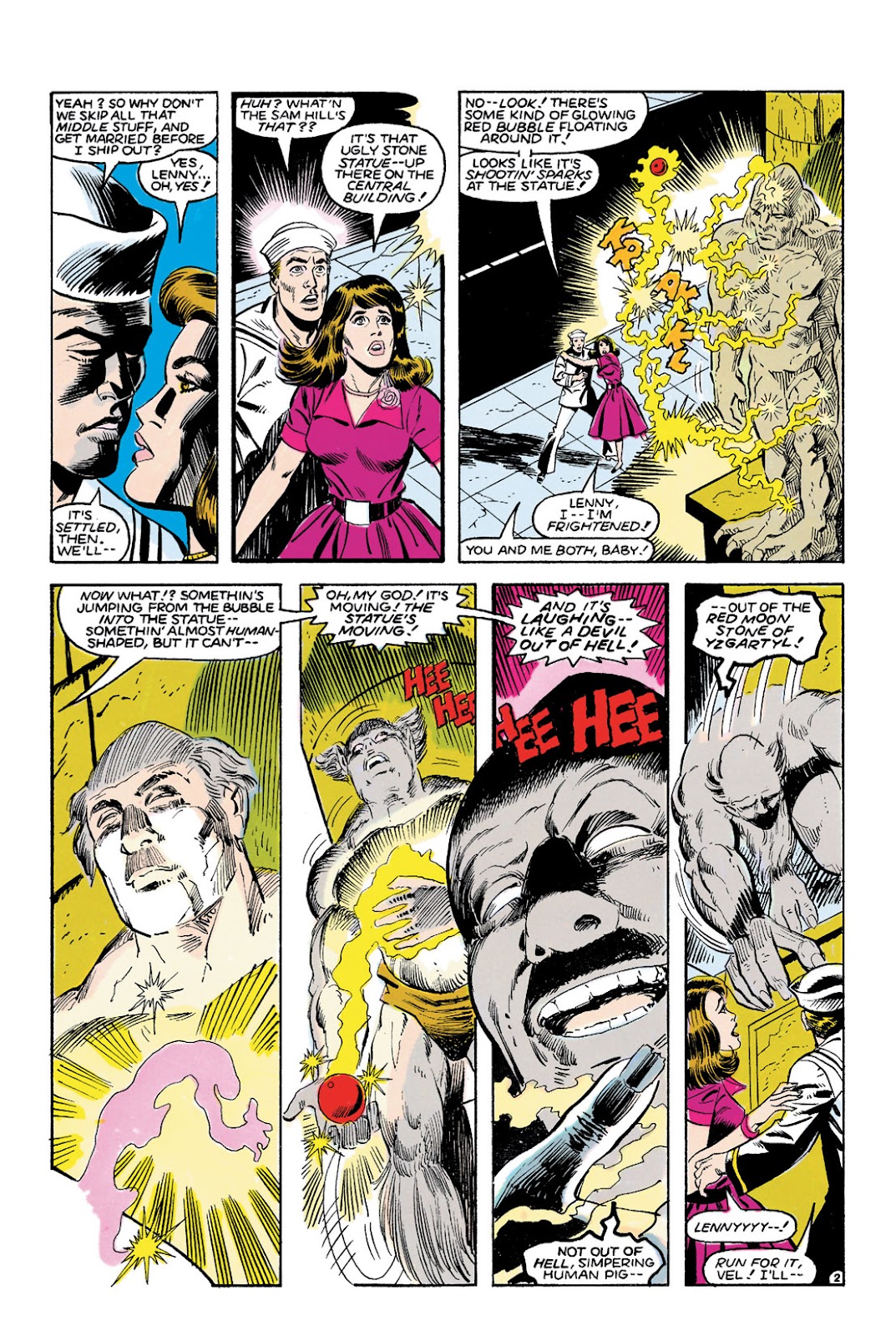 It is Oom, from the Dark Side of the Moon (cue Pink Floyd), who kills Lenny, but Velma faints (and probably loses her glasses, though it looks like she upgraded to contact lenses). Before Oom can kill her, he is interrupted by the little helicopter/microphone we saw last issue, which is piloted by Mr Mind (unseen, of course). We then get a recap of All-Star comics #3, when the Spectre whupped his hide, real good. He then demonstrates how he brought Oom back to life and can take him out again, so Oom agrees to obey him, even if he can't kill Velma. They trot along and we switch to New York, where Dr Fate and Hourman are returning to the hotel where the JSA hang out. They come inside and find Hawkgirl tied up and a band of refugees from Flash Gordon... 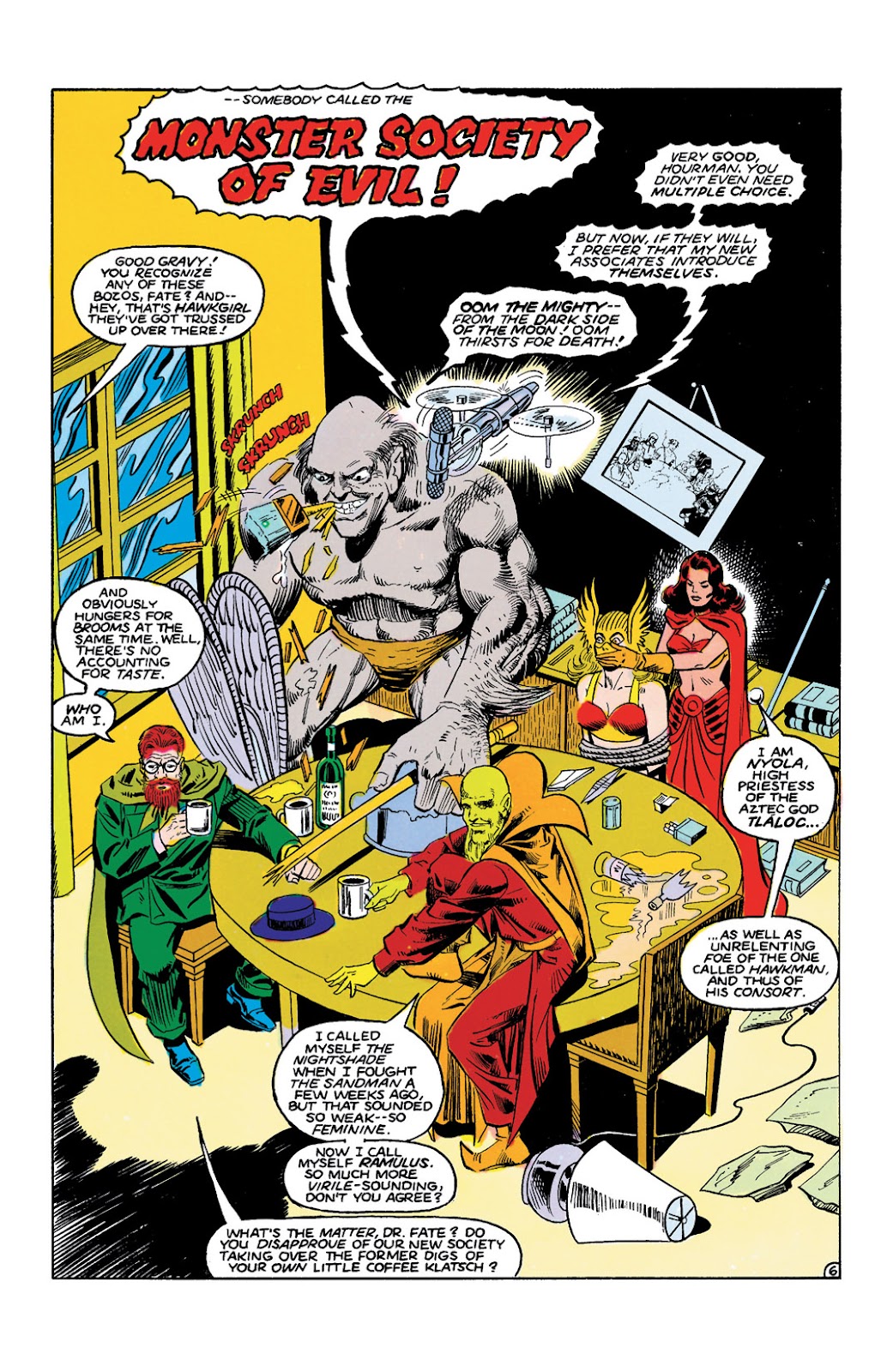 Wait, Monster Society of Evil? That's not the MSOE; where's Captain Nazi, Dr Sivana, Ibac, Nippo, Mr Banjo,? Okay, no one misses the last two...This is Oom, Ramulus (formerly Nightshade), Nyola (must be a cousin of Nyoka), and Mr Who (stripped of his credentials by the AMA, no doubt!) Roy makes intros and then proceeds to do an Abbot & Costello routine... 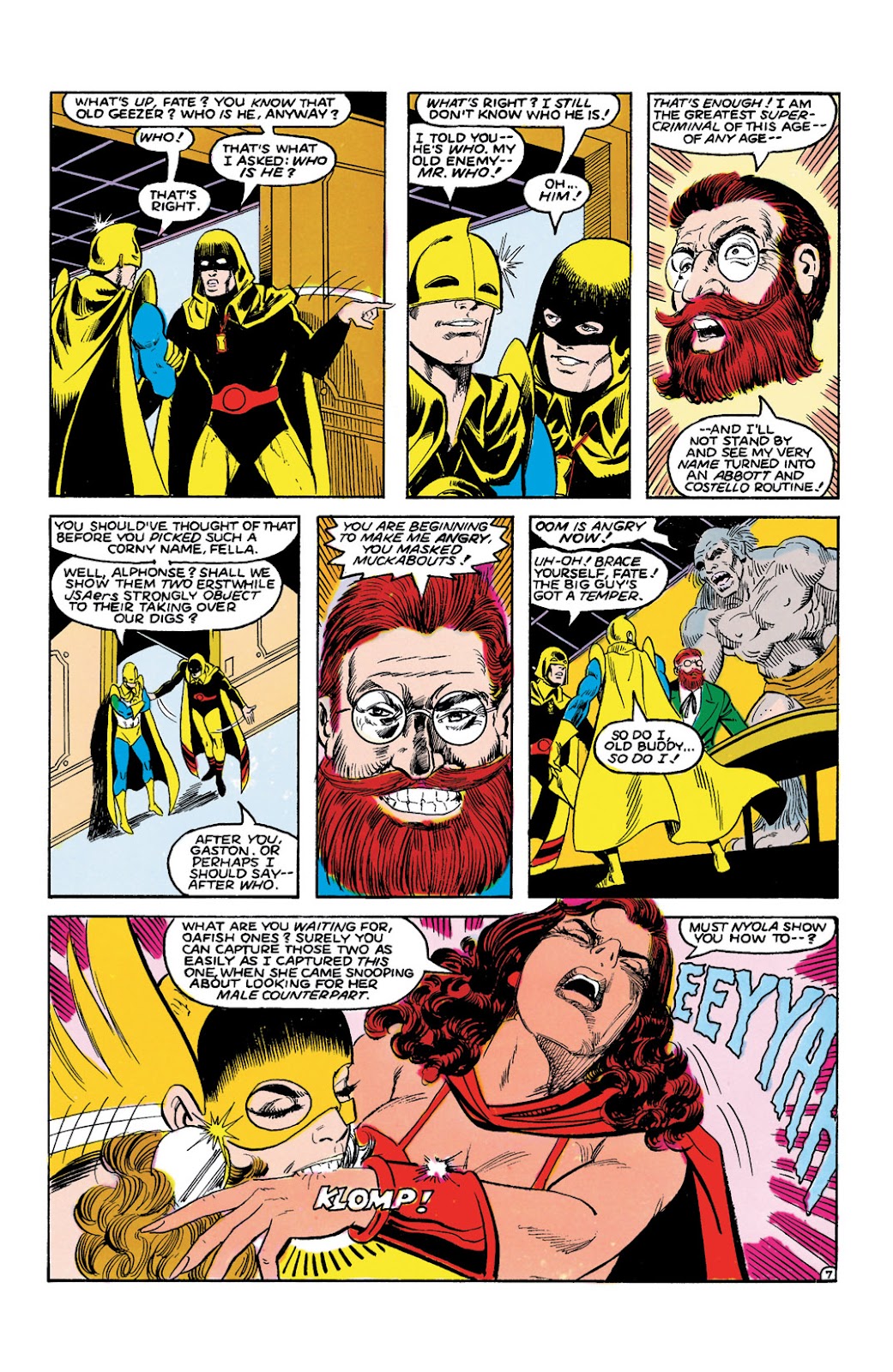 Hawkgirl bites the hand that feeds her and then Nyola gets all Bette Davis on her. Nightshade...Ramulus....sicks some vines on Hourman, while Dr Fate demonstrates how Rey Mysterio Jr or Spike Dudley could reasonably fight Kevin Nash or The Big Show.... 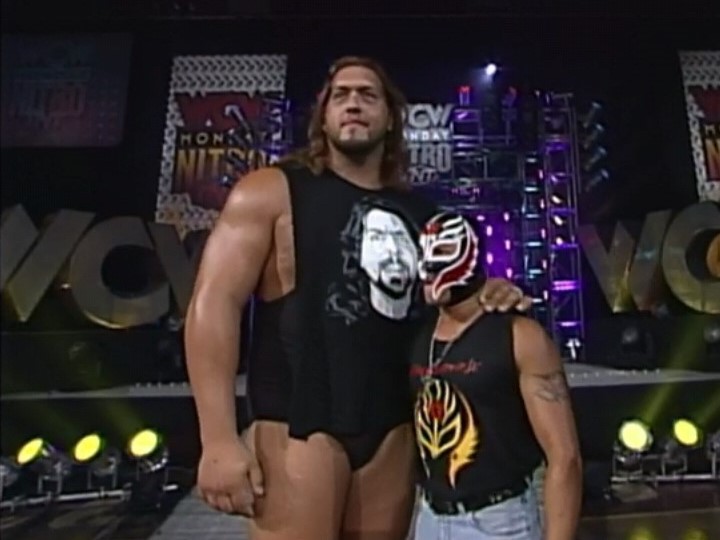   Oom lays the smackdown on Dr Fate and Hawgirl gets threatened with a sword to the throat, if she doesn't stop cheering. It ends with Dr Fate kissing the canvas, Hourman trussed up in vines and Hawkgirl in ropes. Then, Mr Mind fills in his backstory and the formation of this version of the MSOE... 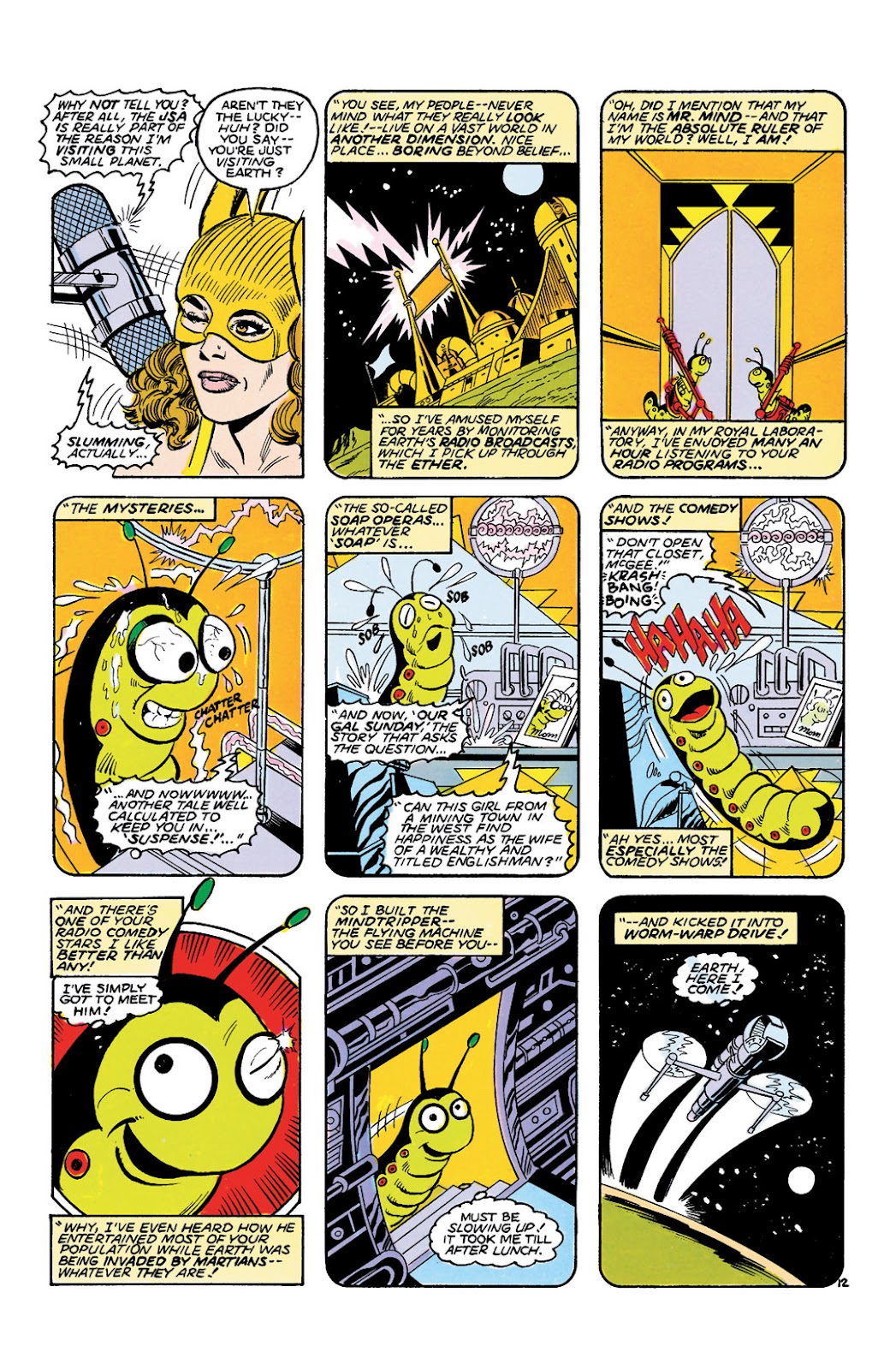 He comes to earth to find his radio hero, gets knocked off course by Harbinger & Firebrand. He arrives in Hollywood and tracks down his comic idol; but, finds out that Charlie McCarthy is just a ventriloquist's dummy... 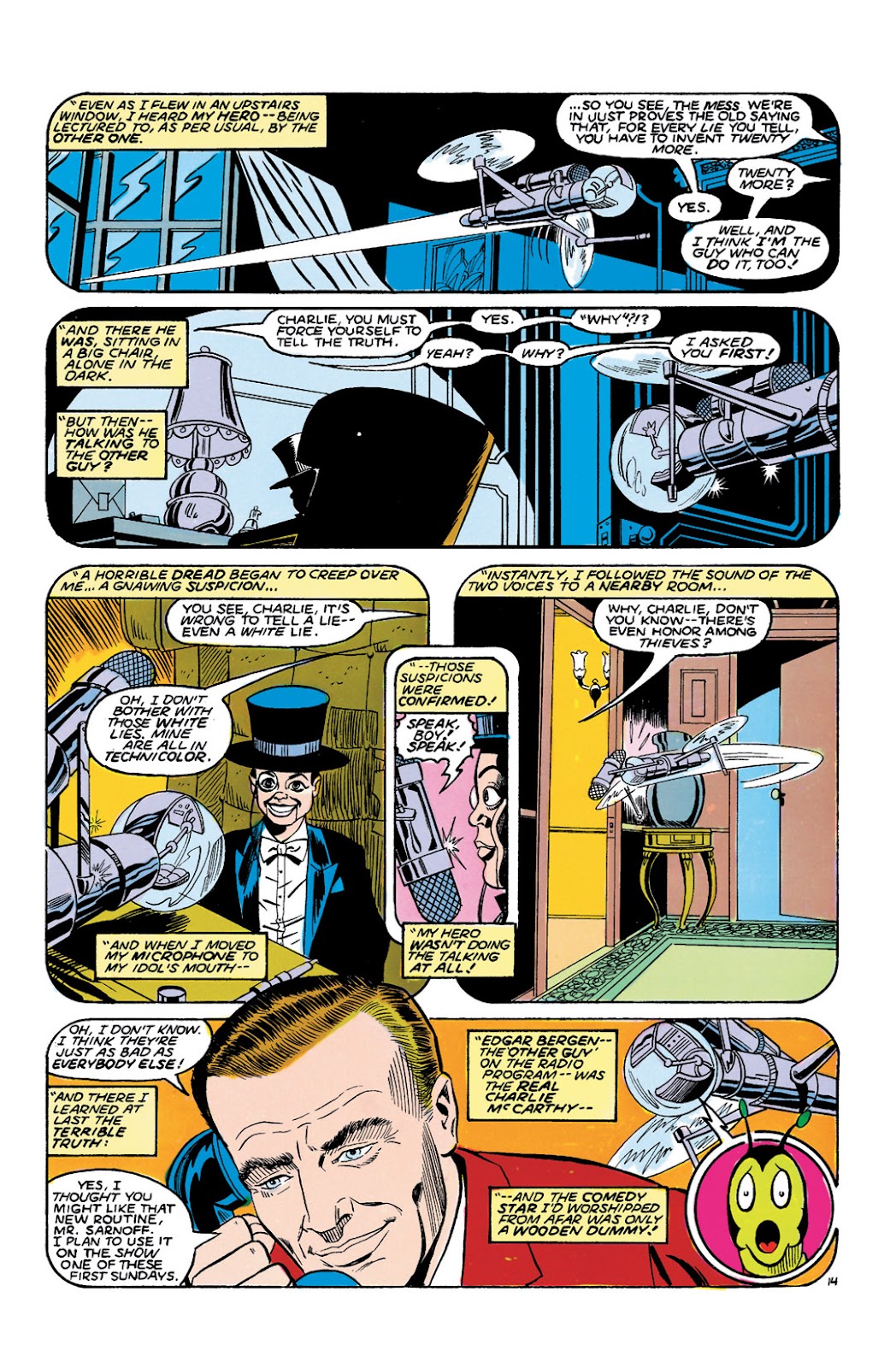 Dejected, he goes to find his other radio heroes, the JSA, and finds the empty meeting room. He reads WW's records of their exploits and decides to create his own society of evil and recruits Nightshade (recently whupped by Sandman), Mr Who (in jail since Dr Fate put him there), Oom (which we saw at the beginning) and Nyola, who was sacrificing people to rain gods. Oom wants to kill Dr Fate, Mr Who wants to kill Dr Fate, Nyola is itching to slit Hawkgirl's throat and Nightshade...Ramulus...is crushing Hourman. Who can save them? 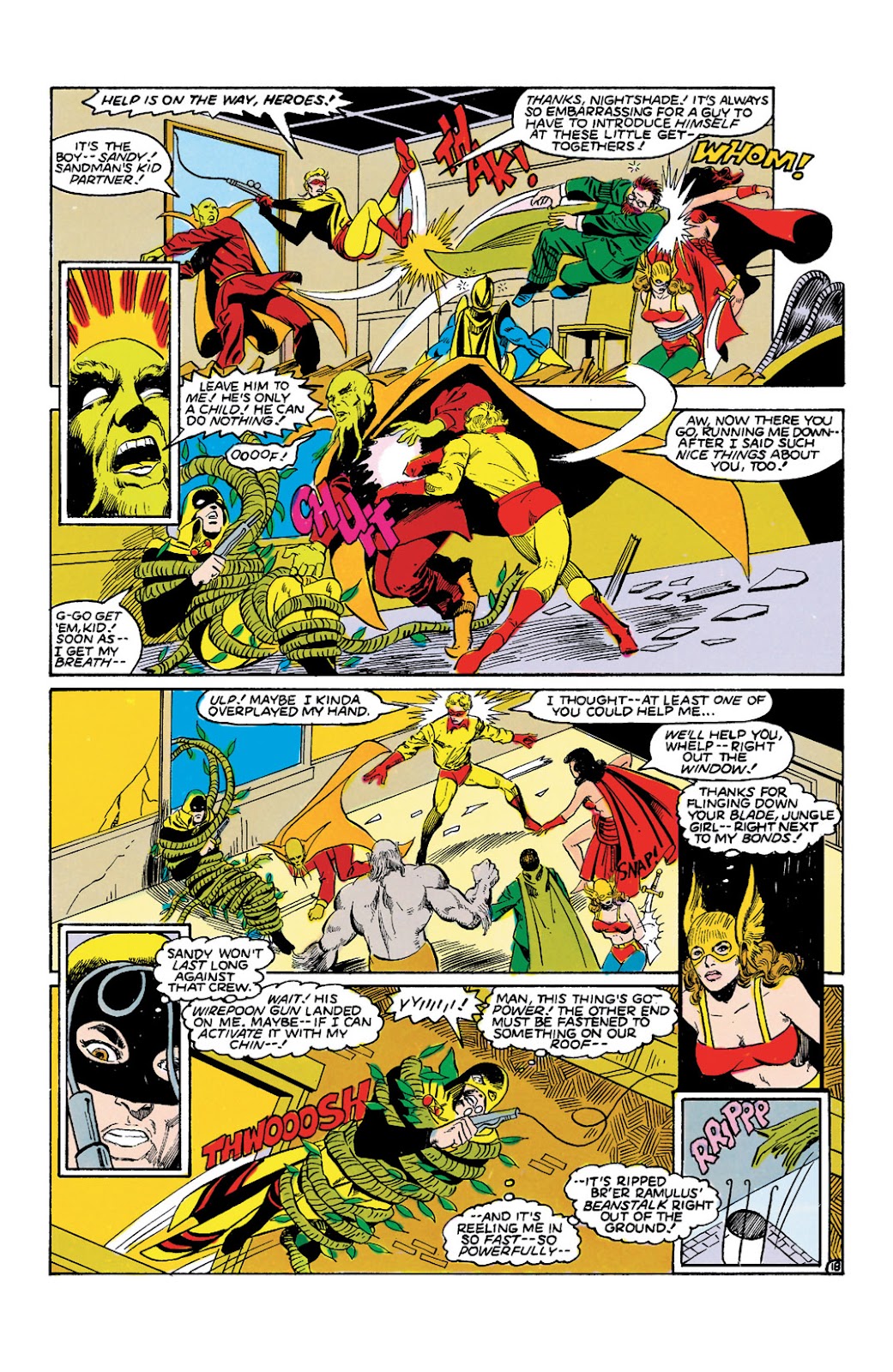 Sandy? Sounds like Roy has been reading Little Orphan Annie. Arf! Sandy's entrance lets Hourman get ahold of his wirepoon gun and fire it, which yanks him out of the room, but his landing is a bit rough... 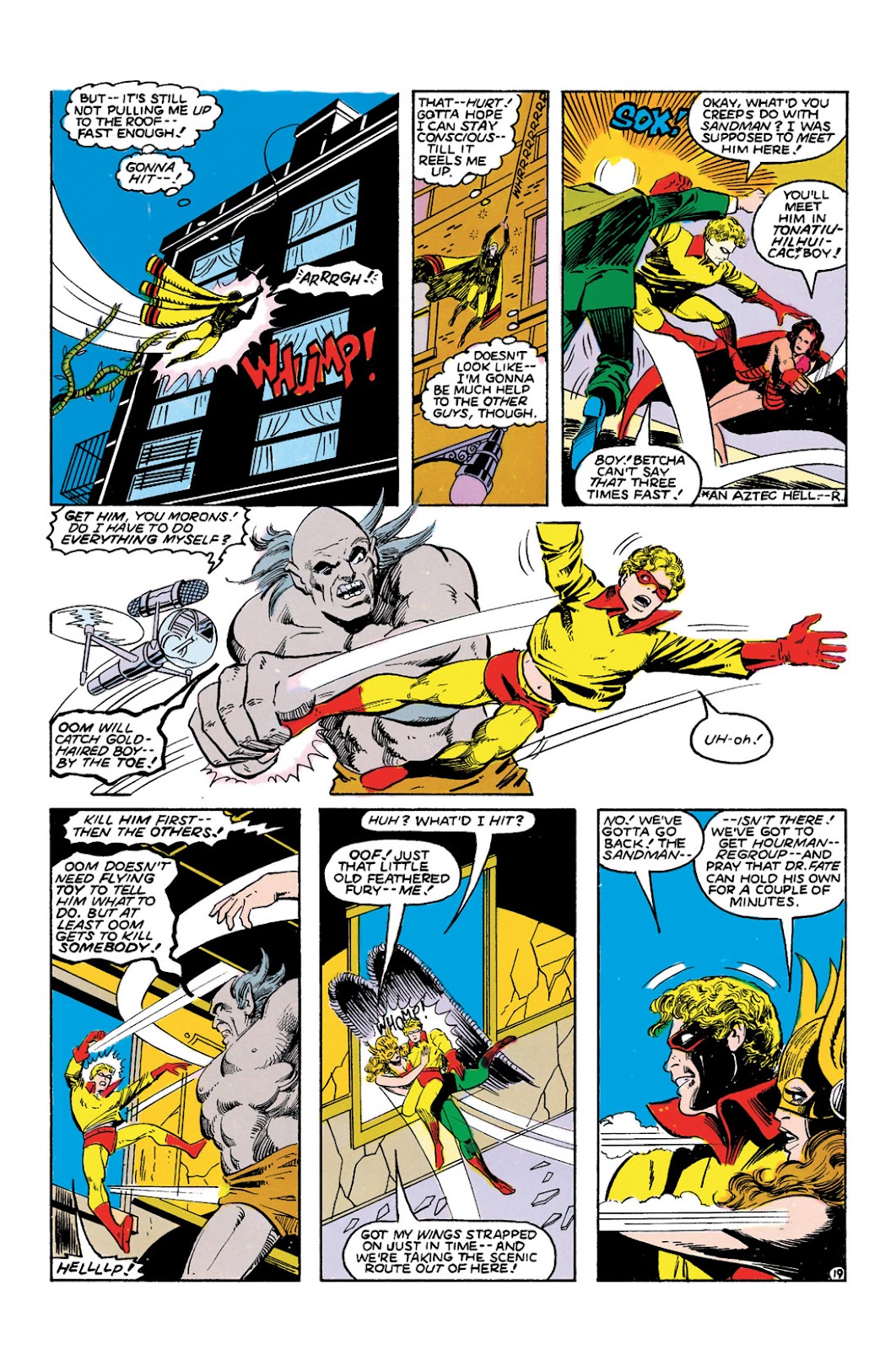 Hawkgirl gets over to Nyola's dropped blade and cuts herself loose, grabs her wings and intercepts Sandy, after Oom swings him like a tether ball. Dr Fate and Oom trade punches and Oom transports him to the Dark Side of the Moon (cue Pink Floyd) and back, causing him to lose consciousness, due to the lack of air, on the moon). The Monsters crow, while the escaped heroes lick their wounds. We cut to somewhere else in the multiverse, as Johnny Quick, Liberty Bell and Green Lantern materialize over New York, but it looks a bit different. They head down to take a closer look, when they run into a big red cheese... 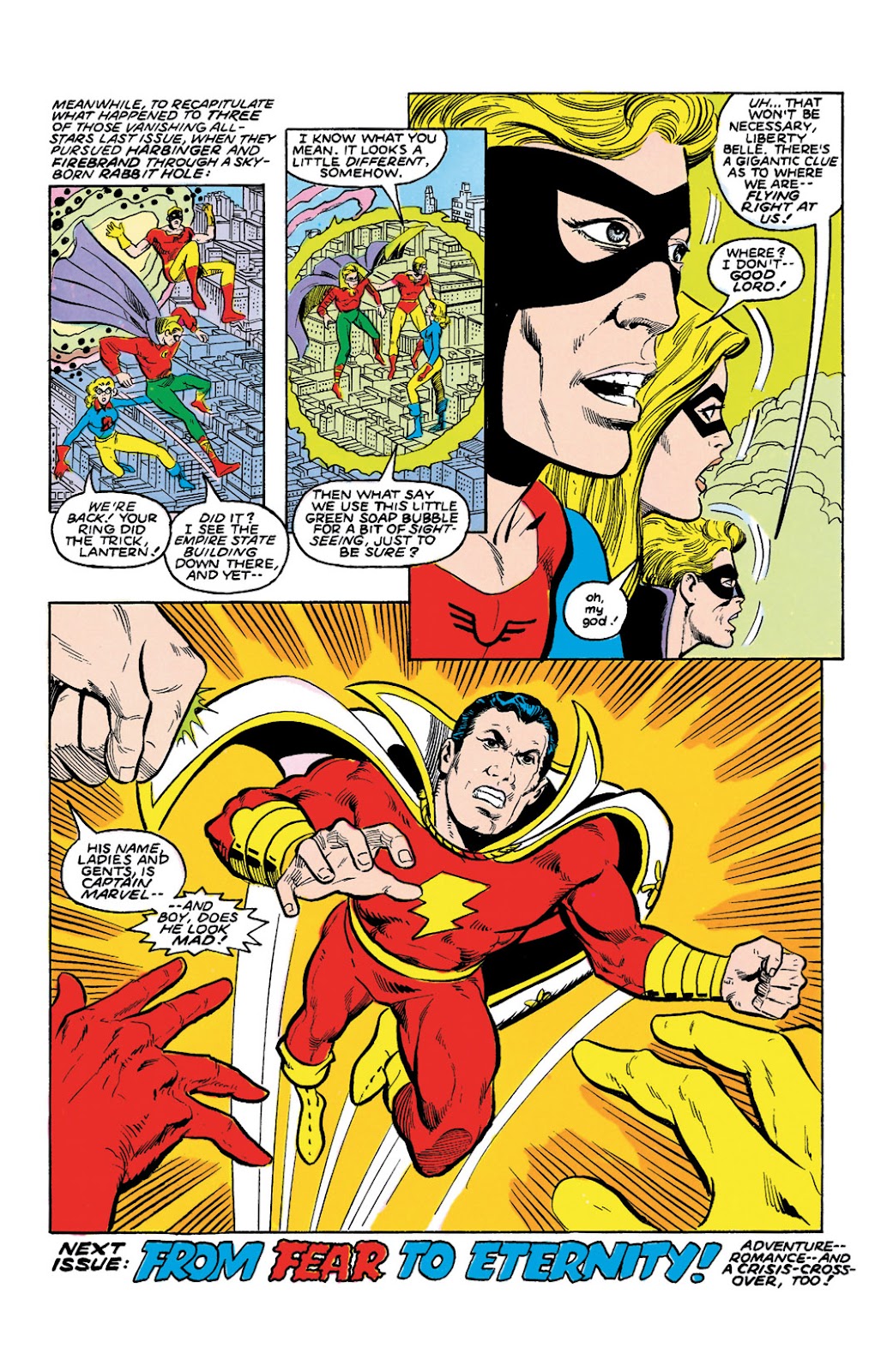 We end with a pin-up of the cover to All-Star Comics #13, which inspired the storyline of the JSA lost in space... 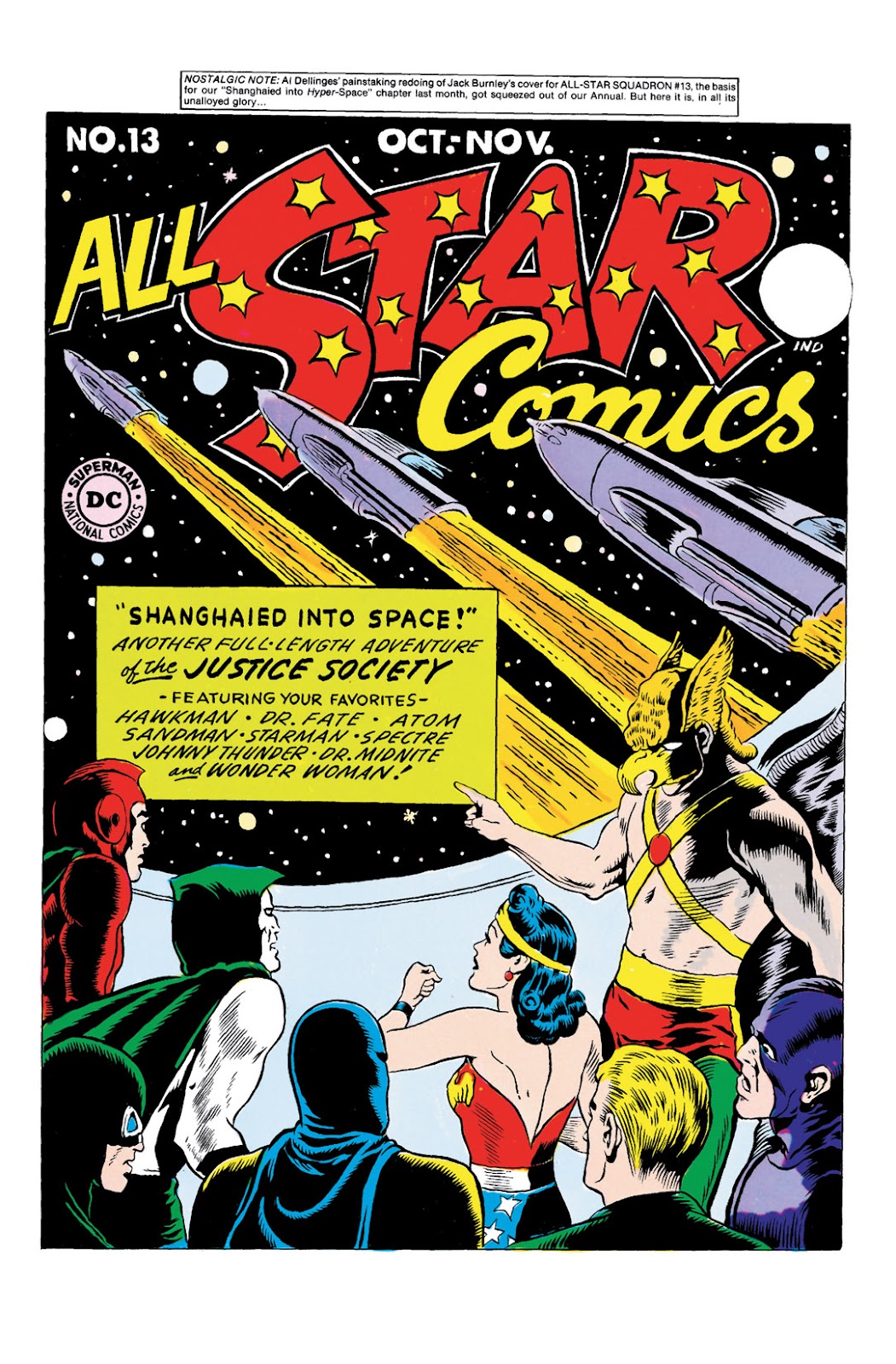 Thoughts: Thoughts: This was rather goofy, though I think it was deliberate, as Roy seems to be trying to capture the more whimsical style of the Fawcett stories, rather than those of Gardner Fox and DC/All-American. We all know what Mr Mind looks like (well, we should, if you are a true comic lover); but, Roy sticks to the conceit that he is unknown until the climax of the original Monster Society of Evil serial (Captain Marvel Adventures #22-46)...well, he is revealed in CMA #27, but Captain Marvel doesn't catch up to him until the end, when he captures him, he is put on trial and sentenced to the electric chair, in one of the most gonzo, yet entertaining endings of the Golden Age. It's a little confusing how he is on Earth-2, other than because Crisis has blurred lines across the parallel worlds. Given the information we see here, my theory is that he is in the Earth-S multiverse, when he bumps into Harbinger and Firebrand, crossing realities and gets shunted into the Earth-2 dimension. It is obvious that GL and the newly married couple (Johnny & Libby) have turned up on Earth-S; so, that's my theory, which is mine. (tm Ann Elk) Mike Clark does a great job with the facials, which adds to both the comedic stuff and the big fight. He really goes to town, in the fight scenes, which makes it look kind of brutal, as the body language really sells the impact, in the best traditions of pro wrestling and movie stunts. He even has Dr Fate choking out a giant, before Rob Reiner did the same with Cary Elwes and Andre the Giant, in The Princess Bride. One criticism of this issue is that there is a lot of description of the action, within the dialogue, pretty much repeating what we are seeing. This was a common fault of script-driven comics, especially by lesser writers at DC. Roy can get a bit wordy; but, he was seasoned enough to avoid this trap, which makes me wonder about why it happens so much in this issue. Almost makes me wonder if Dann might have dialogue some of it and Roy let it go. Or, maybe, it was deliberate, to invoke those earlier stories, where those kinds of things stand out. Certainly, the dialogue is very much in the style of the Golden Age; so maybe that was for effect. Nightshades name change to Ramulus (relating to small branches, in botany) is due to the introduction of the Charlton Action Hero Nightshade to the DC Universe, in Crisis on Infinite Earths. I guess it was okay to have multiple Green Lanterns, Hawkmen, Red Tornadoes, Sandmen, Wonder Women, Flashes, Roses & Thorns, Harlequins, etc; but not Nightshades. Well, actually, Crisis did a pretty big job of culling the duplicate herds, though mostly where it tread on the A-list stars. Meanwhile, both Nightshade/Ramulus and Nyola's attire are blatant swipes of Alex Raymond drawings, from Flash Gordon. Ramulus' collar is pure Ming the Merciless, and Nyola's matches attire worn by both Princess Ardala and Dale Arden (while Ming's prisoner). Nothing too extraordinary about that, as comics were swiping from Flash Gordon from almost Day 1. Hawkman, himself, was a swipe of the Hawkmen of Flash Gordon, right down to the costuming. Sheldon Moldoff even copied specific panels in early Hawkman stories. Excuse me, my editor wants scratches..... Okay, he's had his fill. Back to the review. Historical Notes: Mr Mind mentions the War of the Worlds Broadcast, from Orson Welles and the Mercury Theater. He talks about how most people were listening to his hero, while the Earth was being invaded by Martians. This refers to the fact that on the NBC Radio Network, the more popular Charlie McCarthy show was being herd by many listeners, who then switched over to the CBS Network (during a Nelson Eddy interlude), and caught the Mercury Theater broadcast in progress, minus the notation that the program was a drama, at the start of the show. Thus, a large segment believed it was a real news report, interrupting things. Welles would go on to make frequent appearances on Charlie's show, where he and Charlie would spar. 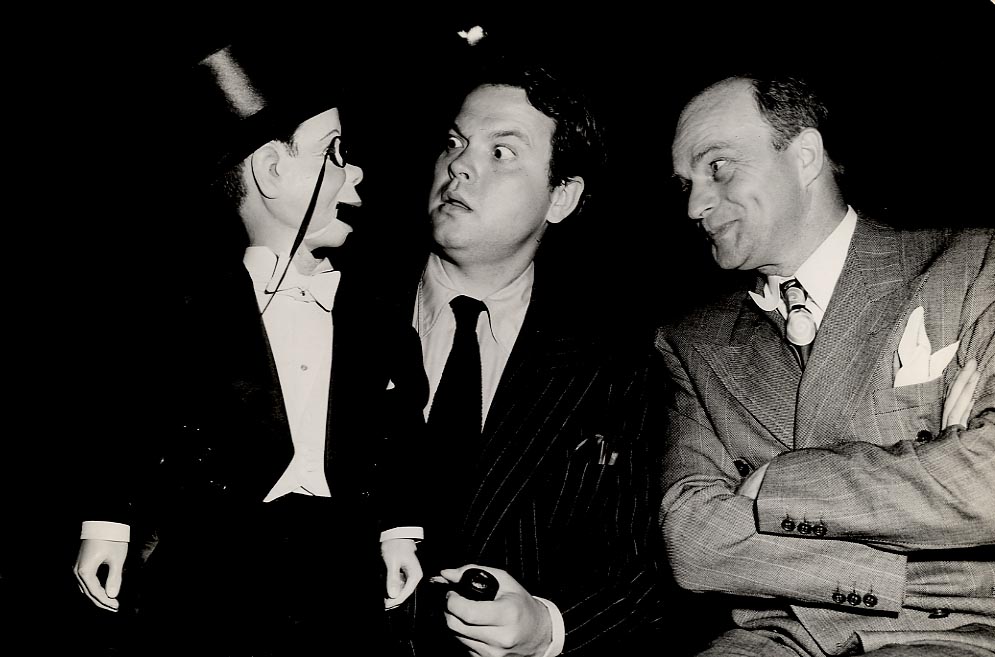 Roy, or rather, Mr Mind, also mentions such radio programs as "Suspense," (which was a forerunner to things like The Alfred Hitchcock Hour and The Twilight Zone, on tv), the soap opera "Our Gal Sunday," (starring Dorothy Lowell, who was replaced by Vivian Smollen, after Lowell's death, in 1944), and Fibber McGee & Molly (with McGee opening the closet). Thus, Roy illustrates the dominant entertainment medium of the period (people had access to radio everyday, but motion pictures maybe once a week or even less frequent). This element helps set the period and give some insight to it, to an audience that grew up with tv and radio being mostly music, news and sports (depending on your local stations). The opening attack on the sailor and his girl, by Oom, shows the sailor in his Summer White uniform. However, you can see a gold braid on the left sleeve and a dark strip on the kerchief. I think someone had old references. The Summer White never had gold braid on the sleeves; but, pre-WW2 they did have blue and white striped cuffs. Also, the kerchief at that point was blue, with white piping. That uniform was replaced and WW2 Summer Whites had a white collar, with the blue kerchief tied loosely around the neck, under the collar.... 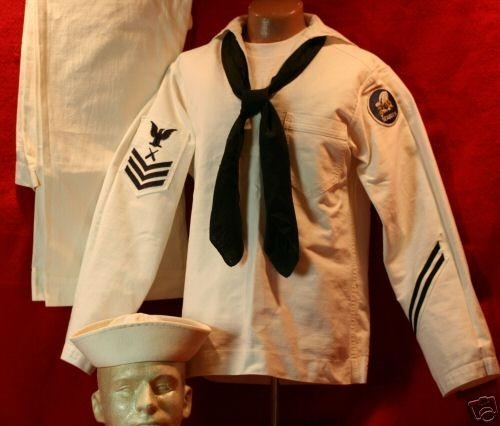 I believe what Mike Clark was intending to show was the service stripe (aka hash mark), which would be in blue, and displayed vertically on the left sleeve. This indicated length of service, with 4 years for every stripe (three years, for the US Army). There is no rating badge on the right sleeve, so Lenny is an unrated Seaman, First Class. That would not be unusual. Upon enlistment, a new sailor would have the rank of Seaman Recruit, during bootcamp. He would then progress to Seaman Apprentice and Seaman First Class. A rating refers to a job specialty. There were two ways to earn a rating: going to an "A-School" (technical training school) or "striking for a rating." The former is pretty obvious; you attend a technical school, take classes and pass exams for that technical specialty and receive the rating upon successful completion of the course. The secondary method is quite common for certain ratings in the Navy, especially bosun's mate and certain engineering ratings. An unrated sailor had the opportunity to "strike" for a rating, via on the job training. He would be partnered with a "sea daddy" (mentor), who would guide his training in the rating. This was usually the job of a Petty Officer, First Class or Chief Petty Officer (a petty officer is a senior non-commissioned officer, equivalent to an Army sergeant or master sergeant), who would take the sailor through the requisite training and then have the sailor sit through an exam (after all prerequisite training has occurred and been signed off by an authorized instructor). Upon passing the exam, the sailor then earns the rating and becomes, for instance, a Radioman. When you see something like Radioman, Second Class, that refers to a sailor with a Radioman rating, and a rank of Petty Officer, Second Class. If you see Chief Radioman, that means a Radioman, who is a Chief Petty Officer (or Senior Chief or Master Chief Radioman). We are also supposed to be in March, in New Jersey, so the sailor might have still been in Winter Dress Blues (aka the "Crackerjack" uniform, for obvious reasons), instead of Summer Whites. Summer Whites were usually only worn when the weather was warm enough, or in tropical or other warm climates. New Jersey and Virginia, in March, can still be kind of cold; so, you might not see the whites until well into Spring. The sailor tells his girl that his Exec (Executive Officer) said they will be in Yokohama Harbor by Independence Day. He'd be a pretty foolish XO, indeed (well, mine would say something that stupid; but, he was an exception, compared to most XOs I saw) to be saying stuff like that, in early 1942. The US Navy had yet to win a naval engagement with the Japanese and had just suffered defeat, along with the Australians and Dutch, in the Battle of the Java Sea, where the US lost 5 ships, in several engagements related to the overall Battle. It would take Midway for the Navy to start getting cocky, though the Naval Battle of Guadalcanal restored some reality to that thinking. No idea if any alien worms were plotting the conquest of the Earth, during WW2. If so, they were pretty quiet about it. Mr Mind first appeared in 1943, during the Monster Society of Evil serial. One can then assume that Roy intends this to be a prequel and a test run for his Society. That is, Pre-Crisis. In the post-Crisis world (ignoring the presence of Captain Marvel, at the end of Crisis, Captain Marvel debuts in the present modern world, well after the other heroes. His debut, in Shazam: A Ne Beginning, occurs around the same time as the Legends crossover, which followed Crisis. Mr Mind is absent from the post-Crisis DC, until Power of Shazam #13, in 1996. This Mr Mind is a more realistic alien creature, who is an advanced scout for a Venusian race, which acts rather like the Borer Worms, in Star Trek 2. I still prefer the little caterpillar guy with the radio hanging around his neck. December 1943- The war is relatively quiet, in terms of major engagements. One of the few was the Battle of Arawe, in the New Britain chain of islands, which was meant to be a diversion from the landings at Cape Gloucster and to establish a PT Boat base. The US forces greatly outnumbered the Japanese and had control of the island within a month. The PT Boat base was never established and many argued that the landings were pointless. In fact, many, at the time, argued against the New Britain campaign as being largely unnecessary to isolate Rabaul. MacArthur was the main force pushing the offensive, to reinforce his operations in New Guinea. and the Solomons. The main argument in support was securing convoy routes to Australia and New Guinea, though those routes were pretty secure, after the capture of Guadalcanal. Others felt naval blockade and aerial bombardment were enough to isolate Rabaul, while existing air bases in New Guinea were sufficient to support operations in that region. In Bolivia, a coup overthrew the military government, which had been in power since a coup, in 1936. Bolivia lost a war with Paraguay, in 1935, over the Gran Chaco region, In 1936, military officers staged a coup, after the government began making noises about investigating the failures of the military leadership, during the war. This was a setback to the reformist air in Bolivia; but, the forces of change were strong and a definite movement began, with intellectuals and blue collar workers pushing for reform, known as the Movimento Nacionalista Revolucionario (MNR). However, anti-semitic statements by members in the MNR hurt their movement and led to the jailing of many members, as Nazi sympathizers. Bolivia had followed other Latin American countries in declaring war on Germany and also declared war on Romania and Hungary, during this month. The MNR were angered by Bolivia's alliance with the US, particularly after the government made financial compensation to Standard Oil for nationalized petroleum holdings, which were at the heart of the Chaco War (1932-35, with Paraguay). With the aid of select officers in the military, a coup was launched in December. The US government refused to recognize the new government, continuing to ally the MNR with the Nazis. The MNR members resigned from the new cabinet and the US recognized the government, in 1944, after the party had gained a majority. The party would fall from power, in 1946, after rivalries with the military component of the government. It would return to power after the Bolivian National Revolution, in 1952. The other major engagement of December was the Battle of the North Cape. The Germans had used a combination of air and sea power to attack North Sea convoys to the Soviet Union, especially in the waters around Norway, at the Arctic Circle. The battleships Tirpitz and Scharnhorst had been devastating raiders of convoys. In December, Convoy JW 55B left Scotland, bound for the Soviet Union. The convoy was used as bait to draw out the Scharnhorst for a decisive battle, as the Tirpitz had already been damaged at anchorage, in Norway. Adm Sir Bruce Fraser, commander of the Home Fleet, planned to ruse. They soon received word that the Luftwaffe was shadowing the convoy. Stormy weather soon grounded the Luftwaffe and the Scharnhorst had trouble locating the convoy. A U-boat spotted the convoy and relayed a message to Scharnhorst; but, it still could not locate them. Fraser had diverted a returning convoy from the area where they expected to find the Schornhorst and ordered JW 55B to reverse course. The Scharhorst had detached her escorting destroyers to widen their search area and they lost contact with her. Soon, the Home Fleet gained radar contact of the Scharnhorst. They engaged at a distance of 12,000 yards, with the Scharnhorst failing to inflict damage, but the British were able to disable her Setakt radar, leaving the ship blind. Their gunenrs could only target British muzzle flashes; but, the British were using new smokeless propellant charges, which eliminated muzzle flash. Scharnhorst disengaged and used her greater speed to try to circle around, to attack the convoy ships; but, the British ships anticipated the German's intentions and positioned themselves to intercept, rather than pursue the Scharnhorst. They re-engaged the Scharnhorst, but were unable to launch a torpedo attack, while HMS Norfolk suffered damage to their forward gun battery. Scharnhorst broke off and decided to run for home. She radioed her destroyers to attack the position reported by the U-Boat, which was out of date. Norfolk was unable to keep up pursuit; but, HMS Belfast regained radar conatct and reported course and speed to Adm Fraser's main force, which intercepted Scharnhorst. Scharhorst was caught unawares and HMS Duke of York met her and scored direct hits, on her forward guns. HMS Belfast fired flares and lit up the German ship, which was pounded by the British and suffered multiple torpedo hits. Her speed was reduced after a hit to a main boiler and further after torpedo strikes. She capsized and sank, with only 36 survivors out of nearly 2,000 crew. This was the last engagement of capital ships, in the European Theater, and marked a turning point on the success of the convoys, as German losses continued to reduce their ability to attack the convoys, further adding to the USSR's military strength, in advance of the impeding opening of a Second Front in Europe. On Dec 2, a Luftwaffe raid at Bari, Italy, sank 28 Allied ships, including the SS John Harvey, which was secretly carrying a consignment of mustard gas. The US Army, without informing the British, had transported the chemical weapon, in anticipation of the Germans using chemical agents in the face of the Allied advance. Cannisters were on the John Harvey's hold and reports indicate also stacked quayside. The German attack caused the chemical agent to be released into the water, diluting it, but, still releasing the agent into the area. British physicians did not realize they were treating gas exposure and prescribed treatments that often led to fatalities. A member of Eisenhower's staff, Stewart Alexander, who had experience with mustard gas effects, was dispatched to Bari, though lacking knowledge that mustard gas had been present. Despite atypical effects, he correctly surmised that patients had been exposed to mustard gas and advised treatment accordingly, which saved many lives. FDR, Churchill and Eisenhower ordered all records destroyed and the attack remained secret, until records were declassified in 1959. However, the truth was not fully known until a 1967 book, Disaster at Bari (by Glenn B Infield, Ace Books). On December 3, the SS and Gestapo executed 100 Warsaw Tramway workers, after sabotage efforts. On December 13, the 117th Jager Division, of the Wehrmacht, executed every adult male of the town of Kalavyrta, in Greece, in reprisal for guerillas killing 78 German soldiers, taken prisoner. The villagers were rounded up and the women and children separated from the men and older boys. The male group was executed by machine gunning, killing 438, with 13 survivors, who were buried under the bodies of the dead. The women and children were locked into a school, which was set on fire; but, a soldier (possibly Austrian) disobeyed orders and opened the doors to allow the prisoners to escape. In total, some 69s villagers and people from the surrounding area were killed. On December 24, FDR gave Gen Eisenhower an early Christmas present, as he was named Supreme Allied Commander Europe and the Supreme Headquarters, Allied Expeditionary Force was established. From here, the planning and training for the invasion of France began. In India, Subhas Chandra Bose set up a pro-Japanese government, in Port Blair, India (on the Japanese-held Andaman and Nicobar Islands). Bose was an Indian Nationalist and represented the more radical effort to oust the British, by allying with the Germans and Japanese. he was expelled from the Indian national Congress in 1939, after clashes with Mohandas Gandhi. After several arrests, he fled India in 1940 and ended up in Berlin. The Germans were sympathetic to Indian Nationalism, as a way to weaken the British and he gained much support. A 3,000 man Free India Legion was assembled from Indian prisoners taken by the Afrika Korps, with the idea of invading India. However, German setbacks led to Bose losing faith in this effort. He asked to be transferred to Asia and was sent via submarine to Japanese-occupied Sumatra. He took part in reorganizing the Indian National Army, which was a project of the Japanese, but the Japanese did not trust his military skills. The INA did fight with the Japanese in Burma. Bose visited the captured islands, but was isolated fromt he local population, which attempted to alert him to the torture and murder of civilians by the Japanese. Bose was killed in August, 1945, when the bomber which was transporting him out of Saigon, crashed and burned, after being overloaded. he died of 3rd degree burns, though there are many conspiracy theories surrounding his death. He was hailed as a hero of Indian Independence, for his patriotism, but, the INC distanced themselves from his legacy with the Axis powers. With the economy in full recovery and wartime production reaching a peak, the Works Progress Administration was ended. On New Years Eve, the Times Square Ball was once again not illuminated and was not lowered at midnight. Instead, a moment of silence was observed, at midnight, followed by the sounds of bells ringing, broadcast from trucks carrying speakers.
|
|
|
|
Post by codystarbuck on Nov 22, 2020 19:27:15 GMT -5
ps The "Human Lawn Dart," is Rey Mysterio Jr, who stands about 5 ft 4 in and was about 145 lbs, at the time, who was hurled by 6 ft 10 in Kevin Nash, into the side of the production trailer, and Universal Studios, Orlando. This was part of a legendary angle in World Championship Wrestling, on WCW Monday Nitro, where the newly christened New World Order, atatcked WCW wrestlers backstage. Rey comes out of the trailer and tries to leap out at Nash, from the railing of steps that descend from the trailer. Nash catches him, shifts him around, raising him up (with Mysterio bridging his arms, to help lift him) then hurls him into the side of the trailer. The images was repeated several times over the next couple of weeks and became an early internet gif.
The third image is of Spike Dudley (Matt Hyson), one of the Dudley Boys of ECW. He was the "Runt of the Litter," and was relatively small. However, was booked as a crazy fighter (implied to be as a result of LSD, the initials of his name, Little Spike Dudley) and was given several wins over very large opponents, as a "giant killer."
The first picture features The Big Show, aka the Giant (in his debut and subsequent career, in WCW) aka Paul Wight (his real name), who is legit 7 feet tall, and was originally booked as the fictional son of Andre the Giant (Andre had a legit daughter, who was never involved in wrestling). At one point, he and Rey Mysterio were teamed up, in the WWF.
|
|
|
|
Post by codystarbuck on Nov 28, 2020 22:21:31 GMT -5
All-Star Squadron #52 Creative Team: Creative Team: Roy Thomas-writer/editor, Dann Thomas-co-plotter, Arvell Jones-pencils, Alfredo Alcala-inks, Cody Weiss-letters, Carl Gafford-colors Synopsis: Arriving on Earth-S, Green Lantern, Johnny Quick and Liberty Belle finds themselves faced with an angry Captain Marvel, bearing down on them. However, Libby & Johnny quickly figure out that he wasn't attacking them, he was trying to warn them of the shadow creatures that were following him... 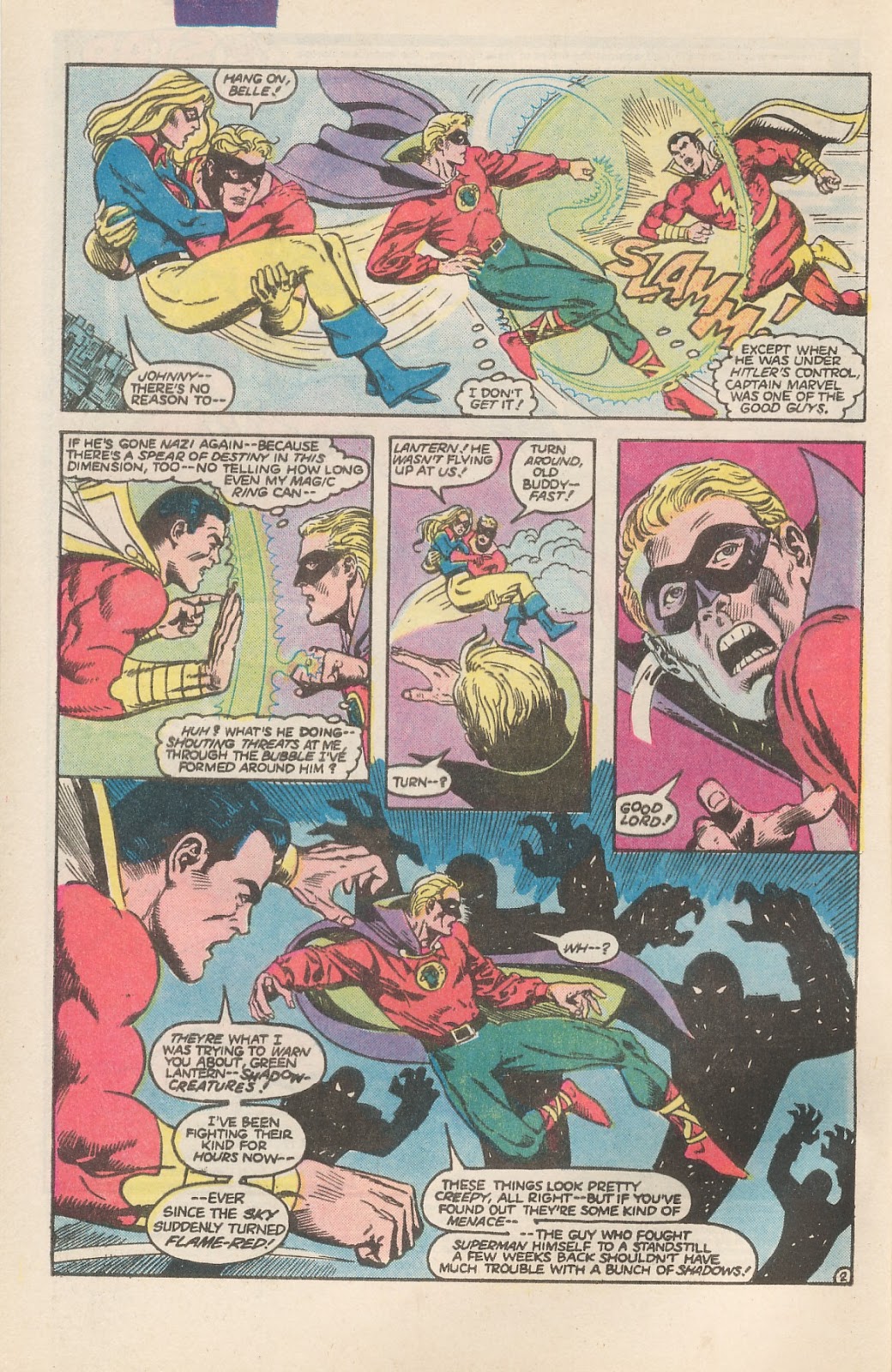 The Big Red Cheese is able to smash up the shadow creatures; but, they reform as black lightning and it triggers the transformation into little Billy Batson, while hanging in mid-air. 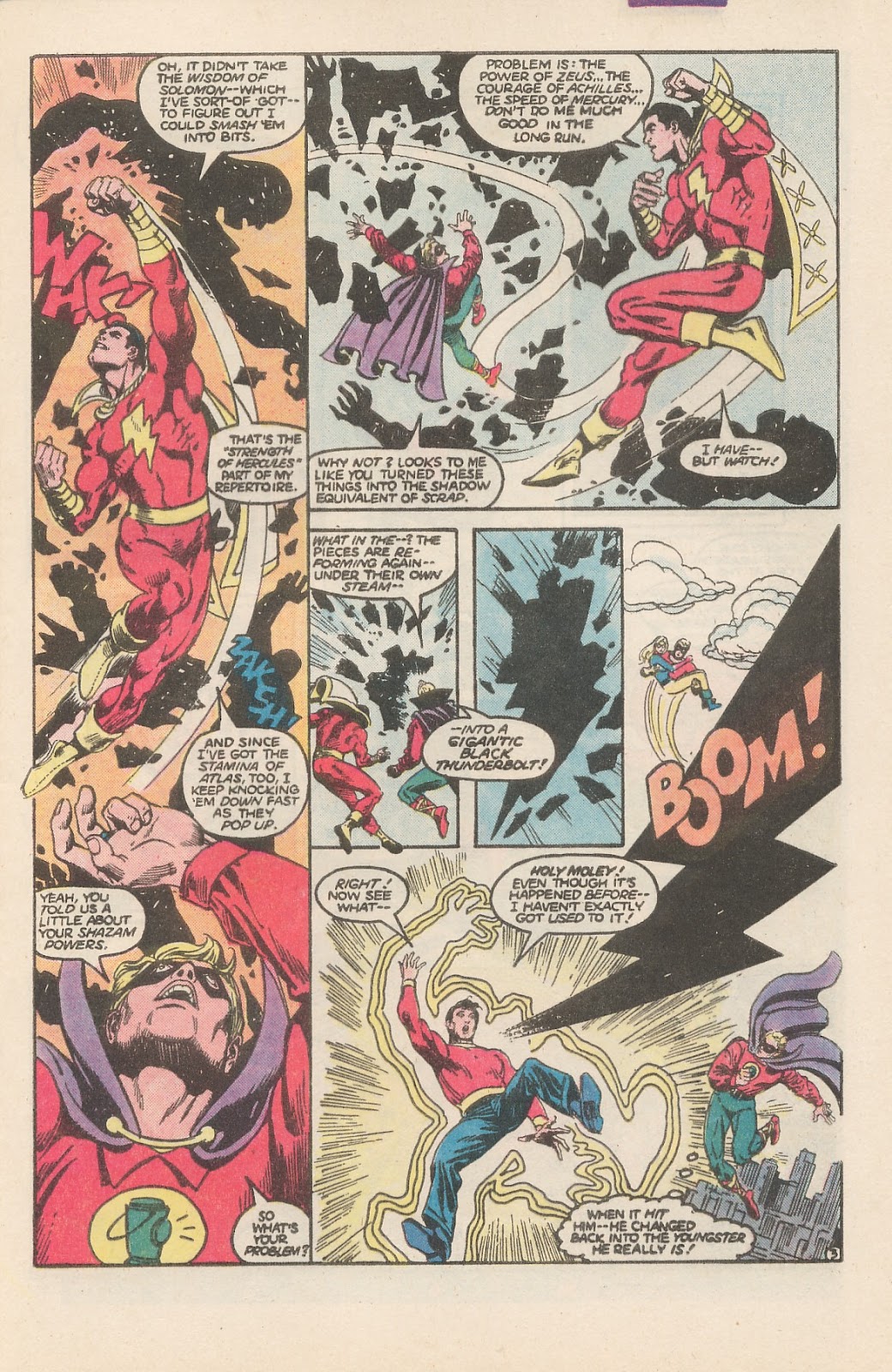 GL rescues BB and Libby and Johnny swoop and evade shadow creatures, while Libby hits them with sonic blasts, which blast them apart. However, they just reform into a single giant anti-matter entity. Billy says the magic words ("Please...."" and changes back into Captain Marvel, freeing Green Lantern to hit the big monster with the light of his power ring. The gang regroups and compare notes about the differences between Earth-2 and Earth-S, while Captain Marvel name drops heroes that Roy can't have drawn, since DC doesn't have the rights to Spy Smasher, Bullet Man or Mr Scarlet (see notes below). GL fills TBRC in about Johnny and Libby's recent nuptuals They retire to a restaurant, for some grub and a kid gets TBRC autograph, but isn't interested in the others, since they are not Ibis the Invincible or Minute Man (or even Hoppy, the Marvel Bunny). They are pretty tired and hotel rooms are at a premium; so, they bunk at Billy's place, which is pretty snazzy, for a kid... 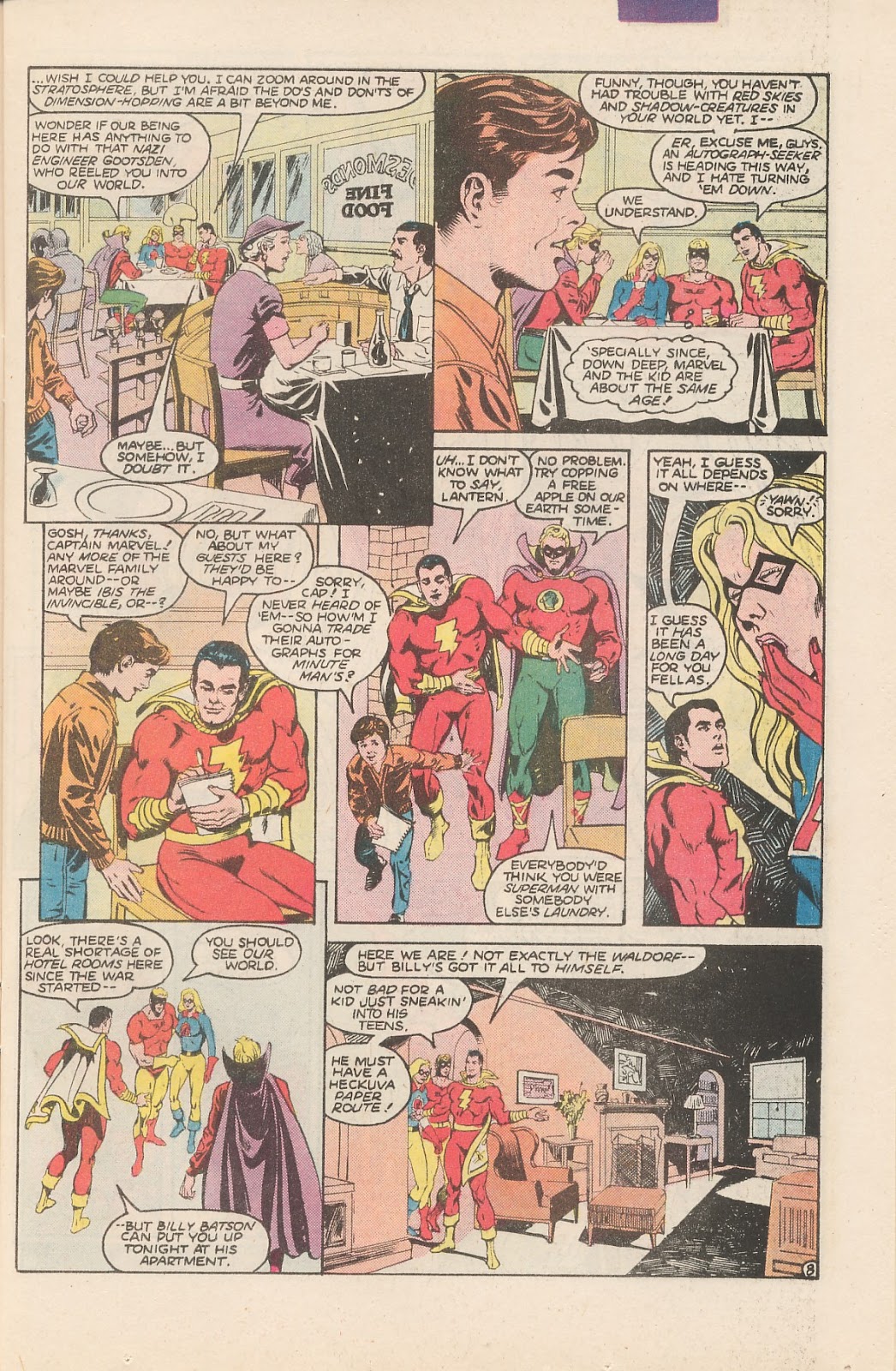 GL and TBRC leave Libby and Johnny with the only bedroom and clear out so....you know.... GL tells TBRC that he is holding something back and tries to fly after him and crashes his but down onto the ground. He hasn't charged his ring and doubts there is a power battery nearby. He asks Captain Marvel if he can get him to China, which is no sweat for le gros fromage rouge, though if they hit Axis territory, he is FUBAR. GL is looking for the meteor that was formed into his power battery, assuming it came to this Earth and, sure enough, there it is and he recharges his ring... 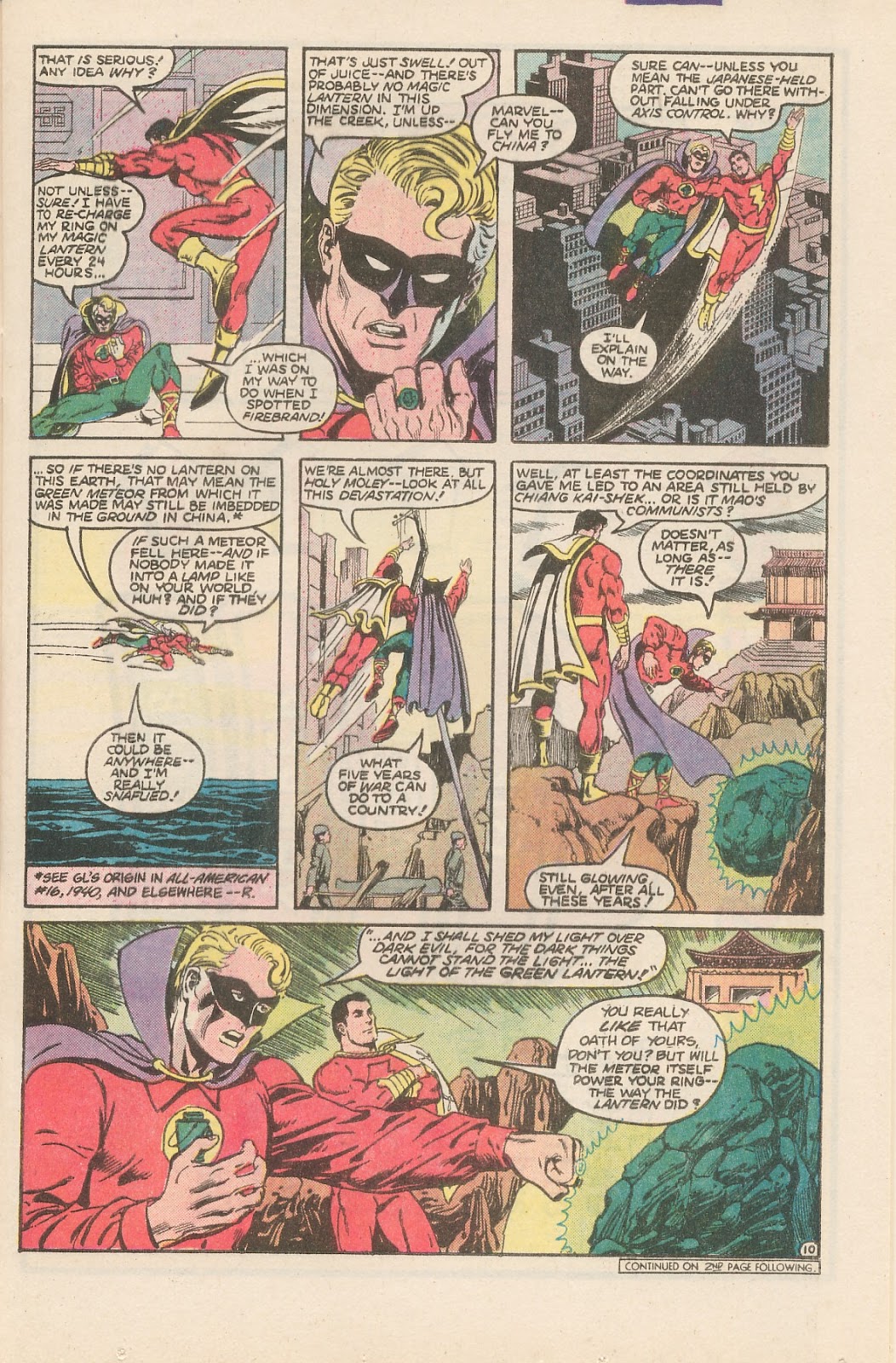 Meanwhile, Libby wakes up, after a night of wedded bliss, and gets up wearing Billy's shirt, which is both sexy and slightly creepy, at the same time... 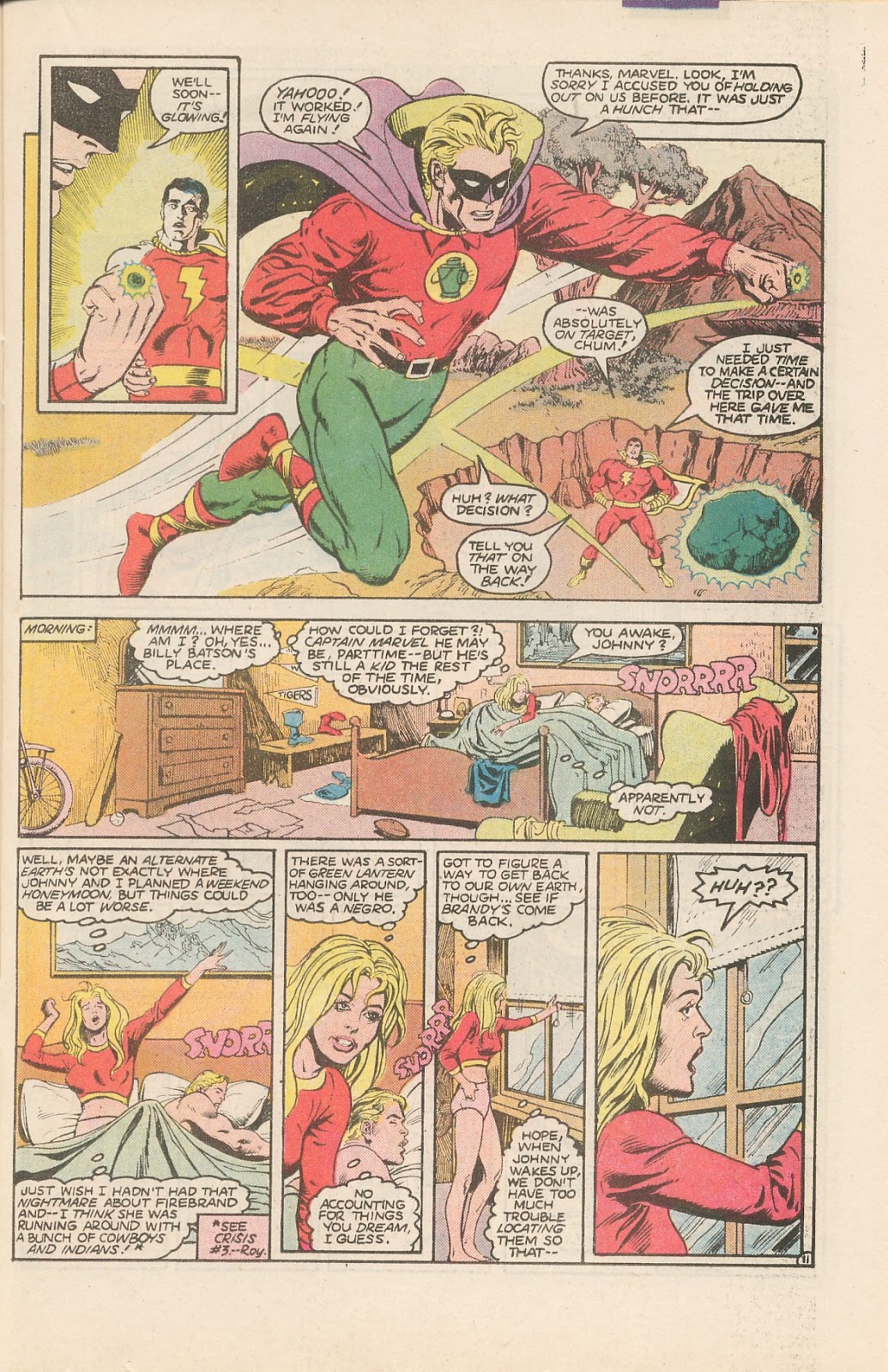 She spots GL and Billy hovering outside, though not peeking in (at the moment) and they say they may have a way to cross dimensions. Libby wakes up loverboy (pillow tot he head) and they get dressed and head to the wizard, Shazam's little cave, with the Seven Deadly Sins statues (strange decorating tastes). TBRC lights the old brazier and Shazam turns up for the barbeque. He says he can send the All-Stars home; but, Captain Marvel is stuck there. So, he sends them tot he Rock of Eternity and then a portal opens to take them elsewhere, while Captain Marvel must stand by and deal with whatever is coming his way. What follows is a tale of Hawkman, and his experiences, trapped in space (based on All-Star Comics #13). Hawkman is trapped in a rocket, travelling through Hyperspace and ends up at saturn (in some dimension) and comes for a landing, where he is attacked by bat creatures, and rescues some pasty white dude... 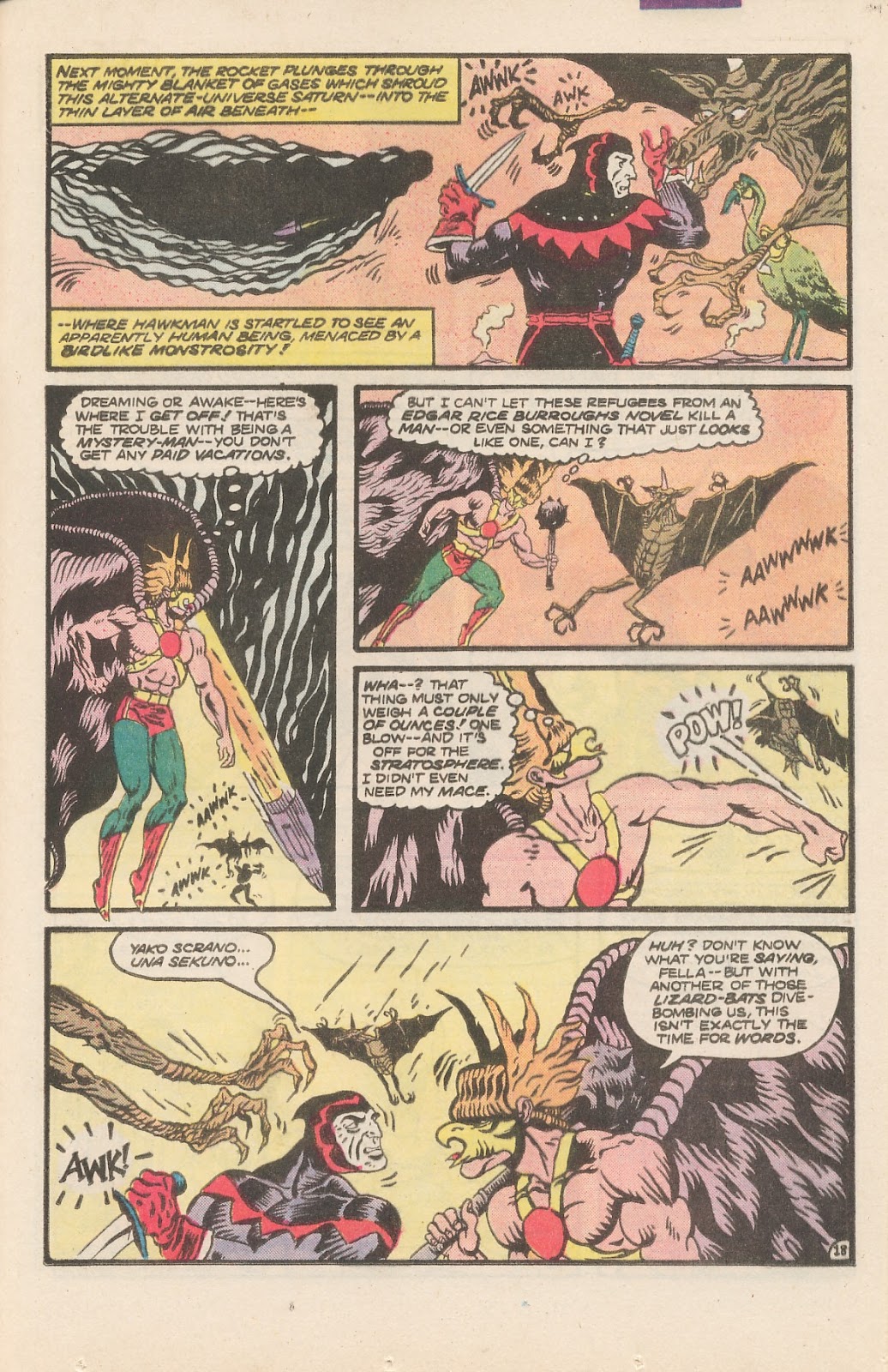 White dude is Aka, president of Arkania, who is off to see his girl, Ysult. She is the daughter of a fascist tyrant, who would make war on Arkania. Hawkman offers to help. He rescues Ysult, dumps on her pop and unites Ysult's people with Arkania, while riding weird birds. Kind of a poor man's Flash Gordon. Thoughts: Kind of a non-issue, really. Nothing of great consequence happens. The All-Star group lands on Earth-S, meets up with Captain Marvel, fight a few Shadowmen and then go back home. Nothing of any real consequence happens. Just kind of feels like a placeholder. It looks fine, and the Rock of Eternity makes for a nice way to travel between Earths (my memory is hazy; but, I believe it played into the JLA'JSA/Shazam crossover, from a few years before); but, it just seems like a script thrown together because Roy wanted to use Captain Marvel; but, everything is too much in flux, because of Crisis. This is why I generally didn't follow the various tie-in comics, unless I was already reading them (actually, I wasn't regularly reading any comics, during Crisis, due to College and stuff; but, I did start picking up Crisis with the death of Supergirl and did collect back issues of a few comics of this era (Infinity, Inc and a couple of others). The Hawkman interlude really does nothing for me. I would rather have a straight reprint than some pseudo adventure that occurred off to the side of All-Star #13. This is what started to annoy me in Infinity, Inc, as Roy would tie things to an old All-Star issue, ten spend more time recapping that story than dealing with his own characters. It started to feel like Roy's JSA fan-fiction (which, when you get down to it, this is kind of that concept). The art tries to ape 1940s Joe Kubert, but is just ends up looking like amateur time. Joe at least had the excuse that he was a kid who was developing as an artist (which worked out pretty darn well, I must say). At this point in time, DC only had the rights to use Captain Marvel, CM Junior and Mary Marvel and their villains and no other Fawcett characters. Previously, DC had licensed the Marvel Family and also used the other Fawcett heroes, in a few stories (Bullet Man and bullet Girl turned up in a couple of stories, and Bullet Girl teamed with Mary Marvel, Minute Man turned up in an issue of Shazam, the whole gang was the Squadron of Justice, in JLA); but, the deal had changed, by this point, to just the Marvel's, and that continued into the post-Crisis revamp. Eventually, in the pages of Power of Shazam, DC was able to use the other Fawcett heroes again, and new versions appeared in Kingdom Come. Historical Notes: Nothing, really. Captain Marvel remarks that hotel rooms are at a premium, because of the war. This was a problem in major cities, as hotels were often filled up by GIs and other war-related personnel, or GIS and their "guests." Housing was often a problem for military families, especially around newer bases. I used to live in Rantoul, IL, where Chanute Air Force Base was located, before it was closed, int he 90s. There was a museum there, after, featuring some of the training apparatus (Chanute was primarily a training base), historical displays, old aircraft and the like. There were displays of letters and photos from each decade of its existence (I was busy looking for potential pictures of my dad, who spent a little time there, in the early 50s, when he was in the Air Force) and, in the 20s, there was a letter to the War Department about the shortage of housing and the outrageous rents that landlords were charging for really crappy rooms. Some things never change! Johnny does look for some radio programs, trying to see if Earth-S does have a Bing Crosby. Crosby was regularly featured on the Kraft Music Hall, sponsored by Kraft Foods. The popular show ran from 1935 to 1946, on Thursday evenings, on NBC. Most of the pre-war shows, which ran an hour in length, have been lost, leaving only the half hour version. The show Johnny finds is Captain Midnight. The hero, aka Captain Albright, a WW1 aviator who returned from a dangerous mission at the stroke of midnight, earning his nickname. The show premiered in 1938 and gained its famous sponsor, Ovaltine, in 1940 and he began leading the Secret Squadron, a paramilitary organization that fights spies, saboteurs and criminals. In 1942, the captain became the star of both a comic strip and a Dell comic book, before he found a home at Fawcett comics, who published 67 issues of his adventures, between 1942 and 1948, with adventures written by Otto Binder, among others.  January 1944- In the European Theater, the Allies begin their assault on The Gustav Line and Monte Cassino. The Gustav Line was a defensive line that stretched across the mountains surround the Rapido-Gari, Liria and Garigliano valleys, which blocked the path to Rome. The Allies launched a series of four assaults on the line, between January and March, which ended up causing 55,000 casualties, to the Germans' estimated 20,000. Allied positions were hit by very accurate artillery fire, which had devastating effect and the Army believed the abbey at Monte Cassino was being used for artillery spotting, despite the Germans previously avoiding using historical spots. The abbey was targeted with a massive bombing raid, in February, giving the Germans provocation to openly position fallschirmjager there, inflicting further casualties on the Allies. Until the 1960s, the US Army maintained that the Germans were occupying Monte Cassino; but, eventual walked back those statements until they yielded to the weight of evidence that only Italian civilians had taken refuge there and were killed in the bombing. Meanwhile, the Allies attempted to outflank the Gustav Line with amphibious landings at Anzio, under the name Operation Shingle. The plan was to surprise the Germans with a swift landing at Anzio, which was largely reclaimed marsh land. They would then drive onto Rome and capture it, thereby taking the heart of the country and cut off the German retreat, catching them on two sides. Gen Mark Clark commanded the landings and new that speed and surprise were necessary, but his subordinate commander, Maj Gen John P Lucas, didn't have faith in the plan and decided to dig into positions on the beachhead, rather than drive swiftly inland. The landings did catch the Germans off guard and a recon unit made it to the outskirts of Rome; but, the delay in moving the bulk of Lucas' troops inland gave Field Marshal Kesselring time to move his troops in a circle around the beachhead. His artillery command the heights over the Allies and inflicted devastatingly accurate fire. The stalemate continued for over a month and Lucas was relieved of command and replaced by Maj Gen Lucian Truscott, who had commanded the 3rd Division, during the invasion of Sicily and his men were considered the best trained and toughest forces in the theater, at the time. Truscott was finally able to achieve a breakoput, but, orders from Clark sent him north, to capture Rome, rather than cut off the 10th Army's lines of communication and path of retreat. As a result, Rome was taken in June, 1944, two days before D-Day. The 10th Army was able to escape and regroup with Kesselring's forces, and establish new defensive positions, the Gothic Line, in the Apennine Mountains. Truscott was one of the youngest and most able commanders in the ETO, while Clark came under serious criticism for the disproportionate number of casualties he took, for little ground and the post-War years did not improve his reputation. Had he not had the support of Eisenhower, he potentially could have been relieved of command. The name Operation Shingle is somewhat fitting, as a shingle is slang term for toast, as used in the old Army mess favorite of chipped beef on toast, known to the troops as "shit on a shingle." Anzio proved to be a meet grinder and troops faced a lot of shit, on this Shingle. In the Pacific, 13,000 US and Australian troops landed at Saidor, on Papua New Guinea, in attempt to cut off the Japanese retreat. one of the objectives was a Japanese airstrip, whose capture led to immediate construction of an air base, from which to launch attacks on Wewak and Hollandia. This proved to be a strategic gain, as B-24s were able to operate from there, without having to restrict their operations to day time, as at the other air base, at Nadzab, which was surrounded by mountains. Saidor had no such natural obstruction. The attempt to cut off Japanese retreat was largely a failure, as the Japanese chose withdrawal over fighting and were able to slip away from advancing forces, through rugged mountain and jungle terrain; but in a high cost of men, as they suffered from extreme cold, fatigue, drowning, disease and starvation. On January 31, the combined forces of the 4th and 7th marine Divisions, the 22nd Marine Regiment, the Army 106th and 111th Infantry Regiments landed on Kwajalein Atoll, in the Marshall Islands. The Japanese used it as part of their outer ring of defense and as a base for submariens and surface ships, as it has one of the world's largest lagoons. The Japanese maintained a 3,500 man garrison. With the end of the Gilbert Islands campaign, the Allies turned their attention to the Marshal Islands, and, having learned hard lessons at Tarawa, launched a two pronged assault on the coral atoll. By this point, Japanese strategic planning had abandoned the idea of defending the Marshal Islands, favoring heavier defenses closer to home. However, they did intend to make the capture of the Marshals very costly. To that end, they reinforced Kwajalein, with further troops stationed at Truk, to add to the fighting. the defenses on the island were laid out in a line, rather in the deeper layers of defenses found on Okinawa and Iwo Jima. Landings were begun and smaller islets fell and became artillery positions for the next assault. Kwajalein Island was the main target, but, it was 2.5 miles long and only 880 yards wide and was virtually indefensible. The Japanese did not believe the US could land on coral and their defenses faced the beaches. The US was able to land on two ends, using amphibious tracked vehicles (amtracks, also known as "gators") and was able to land on the lagoon side of the atoll. The Navy had learned the lessons of Tarawa and fired armor piercing shells, at closer range and inflicted massive damage on the defenses, while also maintaining naval gunfire support during the landings. The Marines and Army made rapid advance and secured the island within 4 days, with only 51 Japanese soldiers surviving. The landings proved that US tactics and training had been effective and the Marshal Campaign moved at a much higher pace than the Solomon and Gilbert Campaigns. The Japanese learned that in line beach defenses were too vulnerable to naval and air bombardment and switched up their defenses in the Marianas, which would prove costly to the US, at Guam and Peleliu. On January 14, the Red Army launched offensives at Leningrad and Novgorod. On January 15, the Polish Home Army was recreated as the Polish Home Infantry Division and launched Operation tempest, a series of armed uprisings, designed to disrupt the German preparations for the advancing Soviet forces. By January 27th, the Siege of Leningrad had finally been lifted. On January 29, Soviet partisans, in conjunction with Jewish partisan unit, carried out a massacre of civilians at Koniuchy, Lithuania. The village had formed a self-defense militia that inhibited partisan activities. Details of the massacre were sketchy and the source of much controversy. The Lithuanian perspective was that they formed a militia in response to partisan attacks on the Germans, which spilled over into their area. the partisans claimed they aided the Germans. The truth is probably somewhere in the middle. On January 11, during his State of the Union address, President Roosevelt announced a proposed Second Bill of Rights. The proposals addressed "economic rights," as the political rights guaranteed by the Constitution had been unable to protect the populace during the Great Depression. The rights proposed included Right to Employment, Right to earn enough to provide for adequate food, clothing and recreation, Right for Farmer's to earn a living wage from their products, Right to freedom from unfair competition and monopolies, Right to decent housing, Right to adequate medical care, Right to , essentially, social security, and Right to a good education. These ideas were to form the framework of proposed social changes that would accompany the end of the war, providing for the future of all Americans. Of the proposals, the only ones really implemented were Social Security, farm subsidies and price stabilization, and such things as the Minimum Wage. However, the bulk went mostly unaddressed in legislation and many saw declines, over time, as Minimum Wage was held stagnate against inflation, in many periods, universal healthcare was never realized, beyond Medicare, and fair housing and education have long been political battlegrounds.
|
|
|
|
Post by codystarbuck on Dec 12, 2020 18:09:35 GMT -5
All-Star Squadron #53 Creative Team: Creative Team: Roy Thomas-writer/editor, Dann Thomas-co-plot, Mike Clark & Arvell Jones-pencils, Vince Coletta & Tony DeZuniga-inks, Cody Weiss-letters, Carl Gafford-colors Synopsis: The Multiverse is in peril as world's are being destroyed and there are red skies.... Nyola, Ramulus and Mr Who have broken into a prison (under Mr mind's direction, but run into Superman... 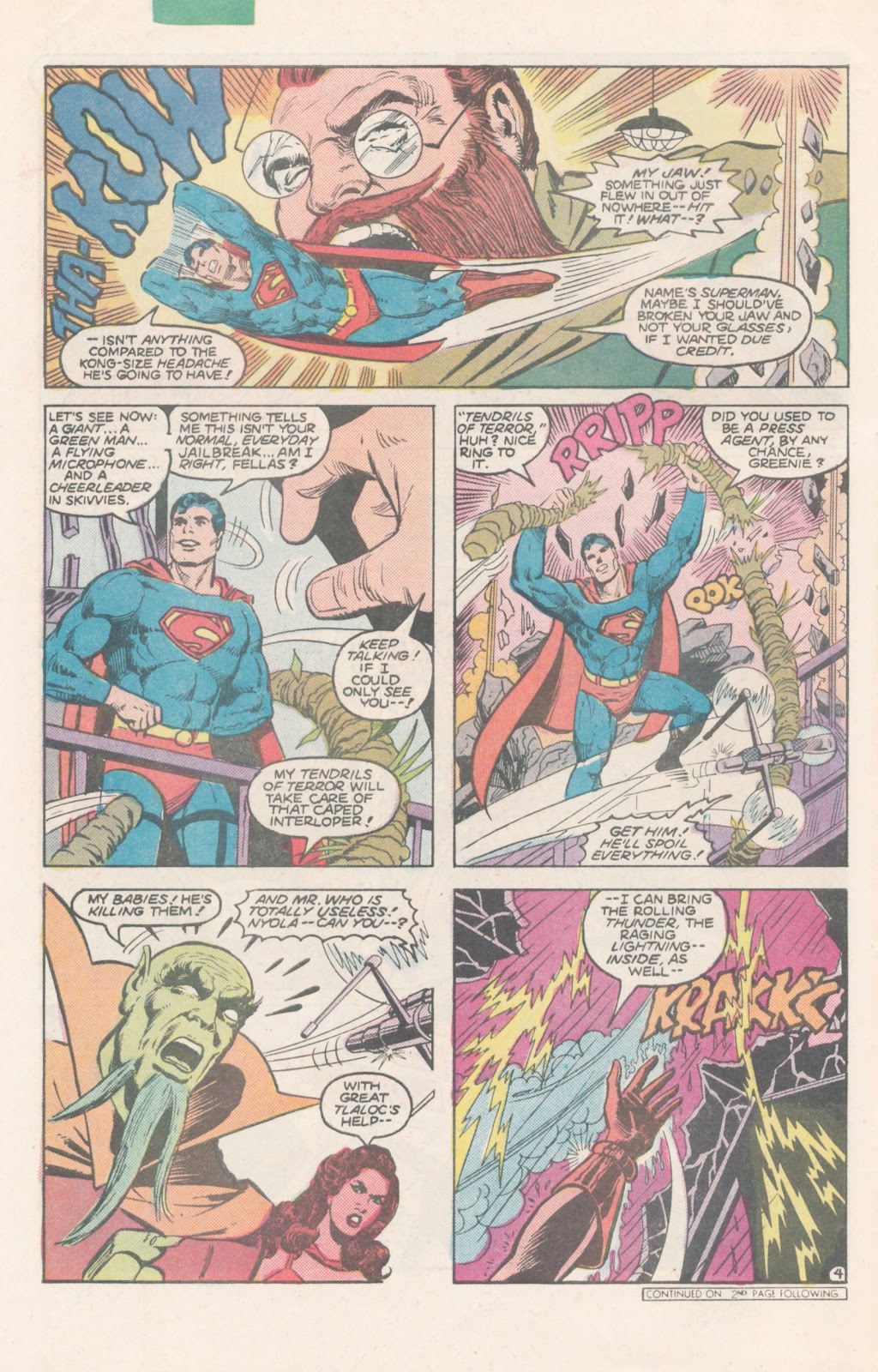 They are after a particular cell ad battle it out with him, and get their clock's cleaned, until lightning strikes Superman, stunning him. They get away with their quarry, who turns out to be, The Dummy! 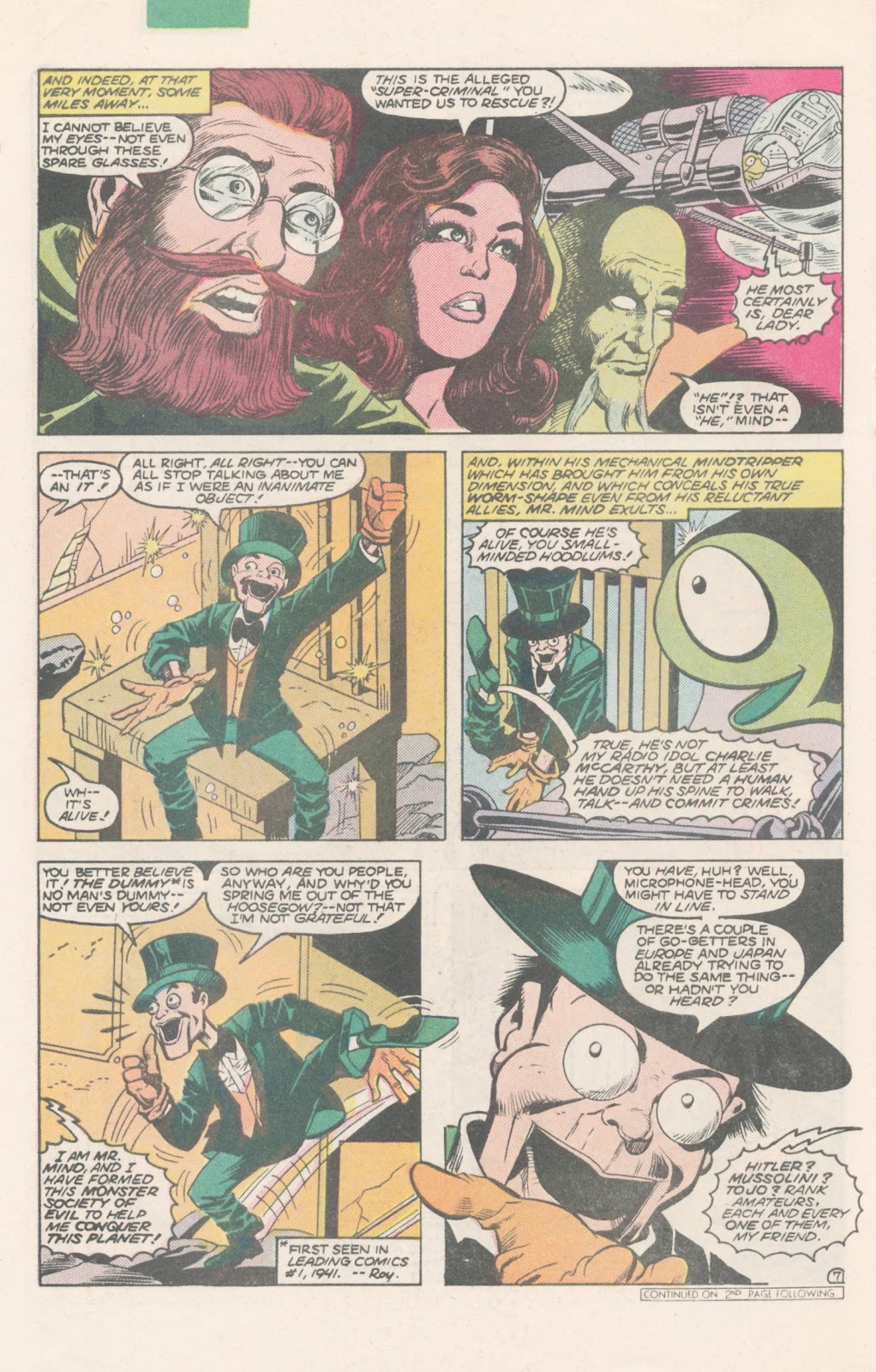 (foe of The Vigilante) The Dummy is no dummy and even he thinks Mr Mind is wacko to go up against the JSA. The others are already plotting a double-cross and the Dummy is let in on the game. Meanwhile, Superman arrives at the Perisphere and meets up with the All-Stars, where he is introduced to a "guy who looks a bit like him," Dr Occult. They confer about their dealings with the Monster Society of Evil (which even the Dummy thinks is a mouthful). They bring Supes up to date on previous issues and they try to contact the Seven Soldiers of Victory; but, get static interference. The team heads out, while Hourman (who had to stop taking Miraclo) stays behind and tries to contact other All-Stars for reinforcements. Meanwhile meanwhile, The Monsters turn on Mr Mind, and bring in Oom for additional help... 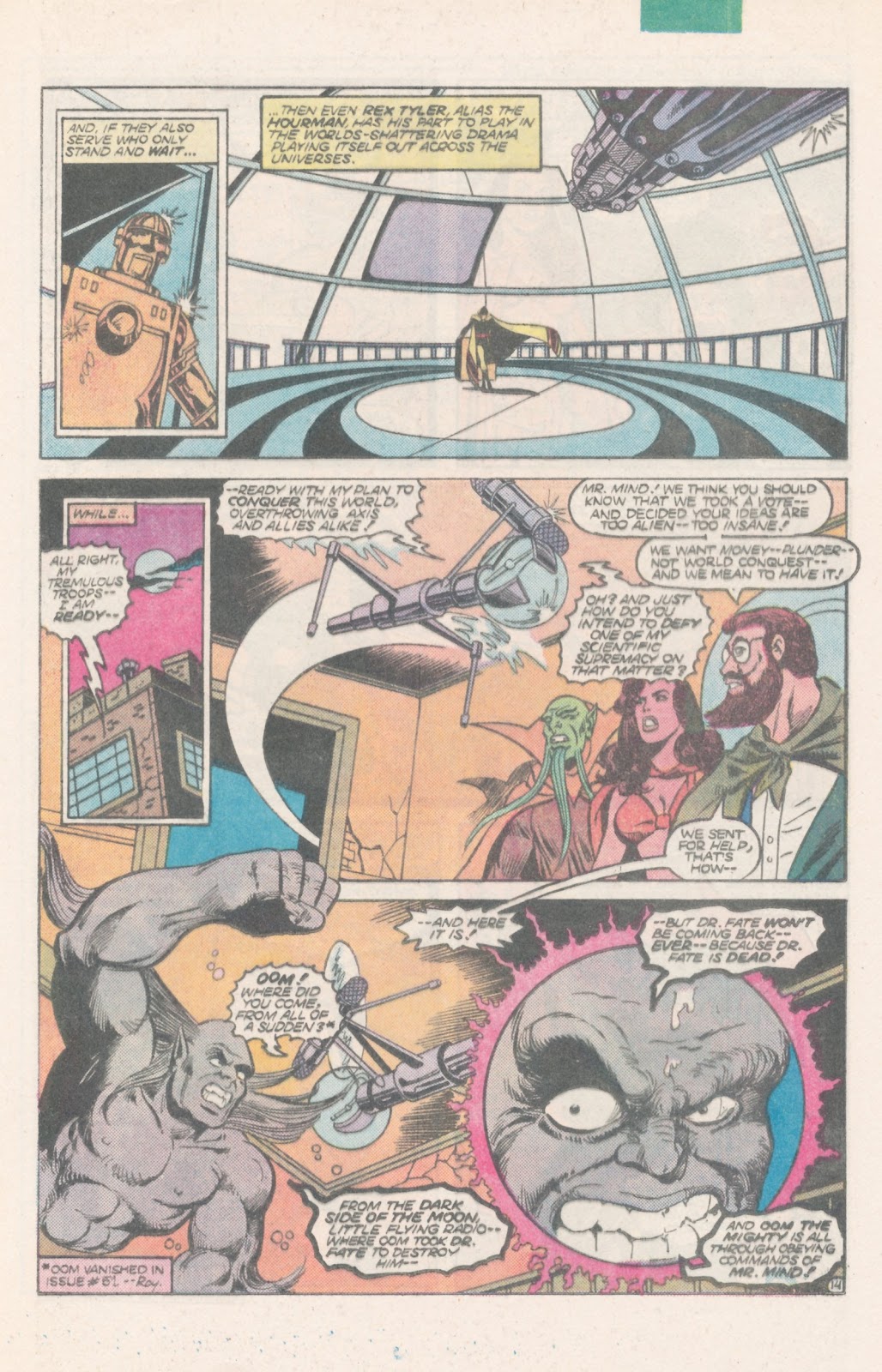 The Dummy has the Moonstone and Oom grabs it and swats away Mr Mind's flying machine, then kicks Dummy on his wooden butt and takes over, redubbing it the Society of Oom. Mr Mind ends up using his sensor to follow the radiation path that leads off to Earth-S, where he figures he can conquer things... 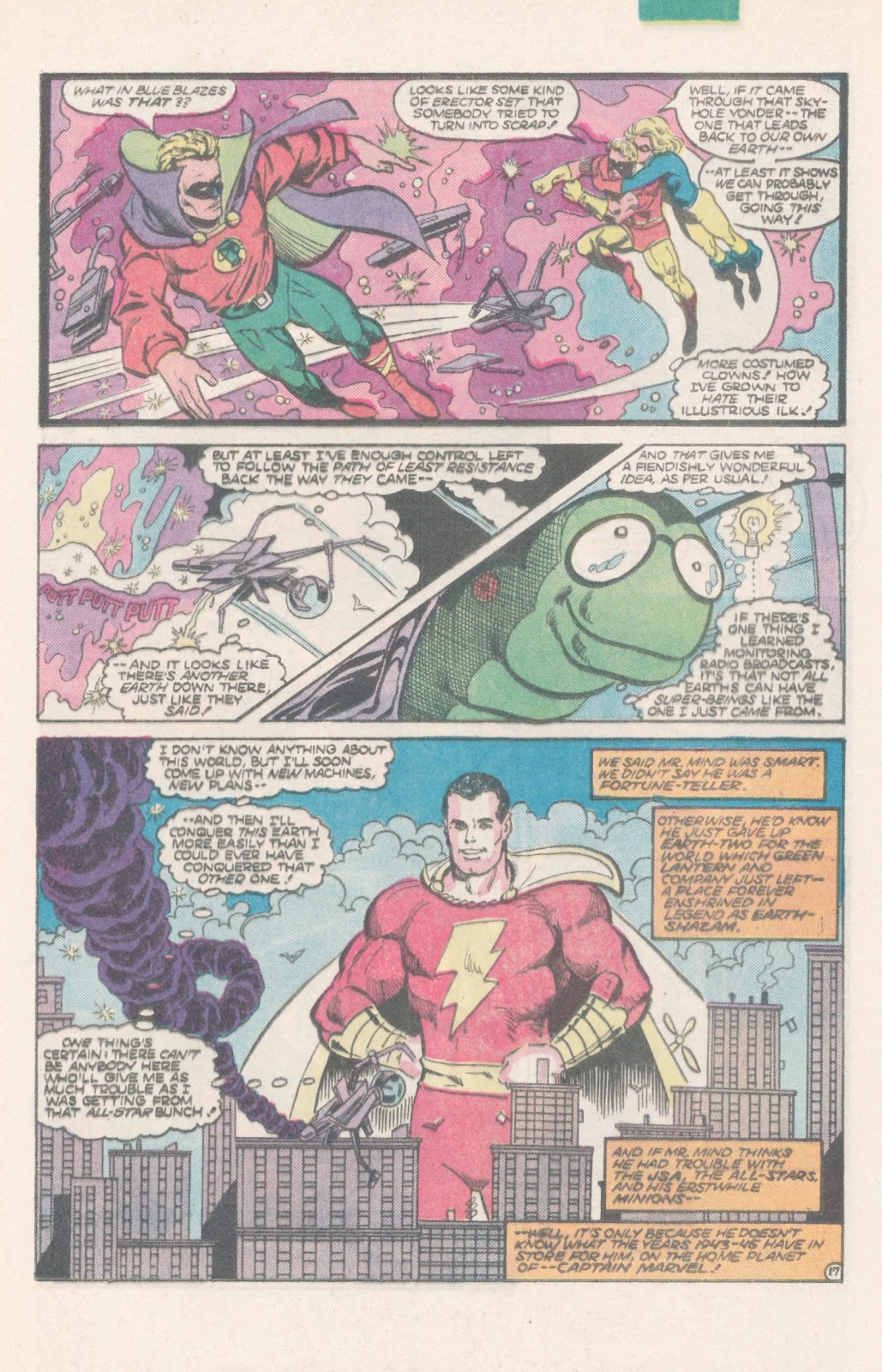 GL, Johnny Quick and Liberty belle emerge from the Earth-S dimension, but GL gets kicked out. Libby and Johnny end up on the Monitor's ship, where they meet other displaced people, including GL, who is now married to Harlequin, Amazing Man and a bunch of others, who have been gathered by Harbinger, who brings in Pariah and we are told to go read Crisis #5 and I tell Roy to get bent. Our gang is dumped on Earth-1, where they end up dealing with a messed up Red Tornado, before GL pulls Johnny and Power Girl to join him, Per Degaton, Deathbolt and Star Sapphire on a mission. Libby says goodbye and they are off back to Earth-2. Thoughts: This is one big disjointed mess. Roy is trying to show in-between stuff, from Crisis; but, it requires you to have read Crisis #5, which is never a good assumption and also the previous issues. That's limiting your book tot he faithful, in a period when yu should be recruiting new people who are curious about Crisis. I get wanting to finish the story; but, there isn't a complete story all the way through the issue. It really detracts from the reading experience and, at best, you get a couple of good scenes and a lot of exposition and random chaos. Roy is trying to be a team player; but, it isn't working. Thankfully, we are spare more retreading of the JSA "Shanghaied into Space" story, since that is also being interrupted by Crisis. The Dummy first appeared in leading Comics #1, as a foe of the Vigilante and would become a recurring enemy. James Robinson brought him back for his Vigilante mini-series, Vigilante: City Lights, Prairie Justice, where he explores post-war Hollywood and Las Vegas, with Vigilante running up against Bugsy Siegel. Roy throws out an in-joke, when Superman spots someone who looks sort of like him. Dr Occult was also created by Siegel and Shuster and predated Superman in comics, though Joe Shuster drew them pretty much the same (and Slam Bradley). Historical Notes: Ummm........we almost get Abbott & Costello's "Who's on First?" routine again. Other than that, I got nothing, except Superman remarks about being at the 1939 World's Fair, to set up the Infantile Paralysis Exhibit, which was part of World's Fair Comics 1939. At the actual fair, on July 3, 1940, the fair hosted Superman day, with an actor portraying Superman... 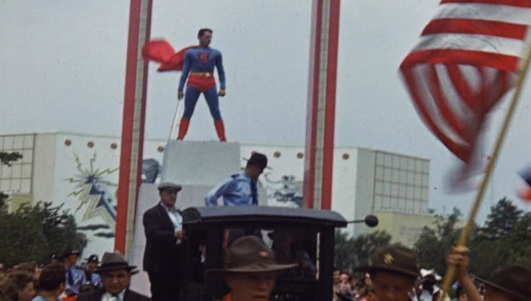 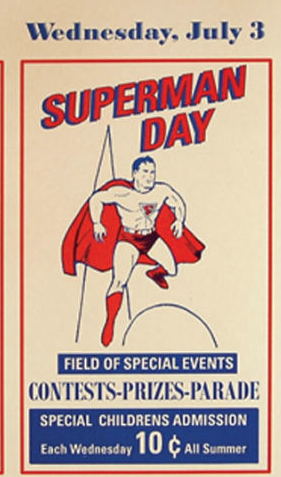 There is some conjecture as to the identity of the acotr. Some reference him as Ray Middleton, who was there as a judge for the Super-Boy and Super-Girl of the Day, and may have protrayed Superman in a radio broadcast from the Fair. Bud Collyer was already portraying Superman on radio and would also voice the character in the Fleischer cartoons and the Filmation New Adv. of Superman. February 1944 In the Pacific, the Allies launched the Marshalls Campaign, beginning a series of landings in the Marshall Islands group, particularly the archipelago of Eniwetok. The atoll is a series of 40 small islands, with a total land mass of less than 5 square kilometers. The Japanese had an airbase there for refuelling between Truk and other island bases and it was lightly garrisoned. It was desired for use as an airbase to support the Mariana Campaign and provide a harbor for ships, as the archipelago rings in a large lagoon, making it ideal for sheltering naval vessels, for resupply and staging further landings. The fighting began on February 17 and lasted until February 23, after the capture of Parry Island. Japan had about 3500 troops there, of which only about a 100 or so survived. US casualties were 313 killed, 879 wounded, and 77 missing. Eniwetok later became infamous as the site of of 43 nuclear weapon tests, from 1948-1958, including the first Hydrogen Bomb. The testing site was later cleared of radioactive soils and materials were placed under a concrete dome, though reports from the Australian Broadcasting Service indicate that rising sea levels have caused leakage of radioactive materials. The are is unfit for human habitation until at least 2026, per earlier estimates; but, the Australian reports suggest it will still be too dangerous.  Meanwhile, based on faulty intelligence, MacArthur upped his timetable in New Guinea and sent a forced reconnaissance into the Admiralty Islands, in the New Guinea chain, to verify that the Japanese had deserted them. Instead, they found them well garrisoned, with about 4000 men. Fierce fighting would ensue and last from February 29 to May 18, during which time some 35,000 Allied troops would be committed to capturing the islands, after reinforcing their initial positions at Los Negros. The capture of the Admiralties allowed for the construction of a major naval and air base, from which further landings and operations were launched. it also completed the encirclement of Rabaul, cutting it and Truk off completely, thereby neutralizing their threat and avoiding the necessity of taking those islands, which were heavily fortified. Instead, the Japanese had to try to run a naval blockade to move in or out f those bases and their logistical situation became more and more dire, inhibiting their ability to launch airstrikes from the base at Rabaul. In Europe, the Germans launched a counter-offensive, aimed at the stalled Allies, at Anzio. It was also this month that Monte Cassino was bombed by the Allies. The USAAF launched major bombing raids on German aircraft manufacturing sectors. The Nazi propaganda film, Theresienstadt, directed by Jewish actor and director Kurt Gerron, begins filming, using mainly Jewish film crew. The film depicts life in the Theresienstadt camp, which was a show camp created to delude the Red Cross into believing that Jews and other prisoners of the Nazis were being humanely treated. Gerron was a German Jew who escaped to the Netherlands, but was then deported after Nazi conquest. The film was undertaken not by the Ministry of Propaganda, controlled by Josef Goebbels; but, by the Protectorate of Bohemia and Moravia, under Hans Gunther, in Czechoslovakia. the intent was to discredit the reports of genocide that had reached the west (from Poland and other areas). However, it was only officially screened 3 times and was not completed until March 1945, by which point Germany was too far on the brink of defeat to go through with plans to distribute it to neutral nations. After completion, Gerron and the crew were gassed, at Auschwitz. Sue S Dauser became the first woman promoted to the rank of captain, in the US Navy Nursing Corps. Dauser attended Stanford University and the California Hospital School of nursing; and, then became a Navy Nurse in 1917. She served in Edinburgh, Scotland, during WW1. After the war, she served as Chief Nurse at the naval Hospital, in San Diego, in Guam and the Philippines and as Chief Nurse at several other facilities. She was made Superintendent of the Navy Nursing Corps in 1939 and oversaw the recruitment of nurses, growing from a strength of 400 to over 11,000, by 1945. She was awarded the Distinguished Service Medal for her work during the war. She died in 1972. She had also attended President Warren G Harding, when he was stricken with what would prove to be a fatal illness. 
|
|
|
|
Post by codystarbuck on Dec 20, 2020 19:55:19 GMT -5
All-Star Squadron #54 Night on Balding Mountain, apparently. Creative Team: Roy Thomas-writer/editor, Dann Thomas-co-plot, Mike Clark & Arvell Jones-pencils, Alfredo Alcala & Vince Coletta-inks, Cody Weiss-letters, Carl Gafford-colors Images are gonna look crappy on this one. My image source has a pretty bad scan; either done badly or this was one of those issues DC had with that gawdawful Flexo-graphic press printing, where they used plastic printing plates and had a LOT of teething trouble. Quite a few books from this era look like pure crap entirely due to bad printing. Synopsis: It's finally April, 1942!!!! That's an average of about a month a year. I know the pace of life was slower in the 40s; but, not that slow, Roy! The All-Stars are out hunting for the Monster Society of Evil. Superman searches Metropolis, where the buildings are lit up to form crossword puzzles.... 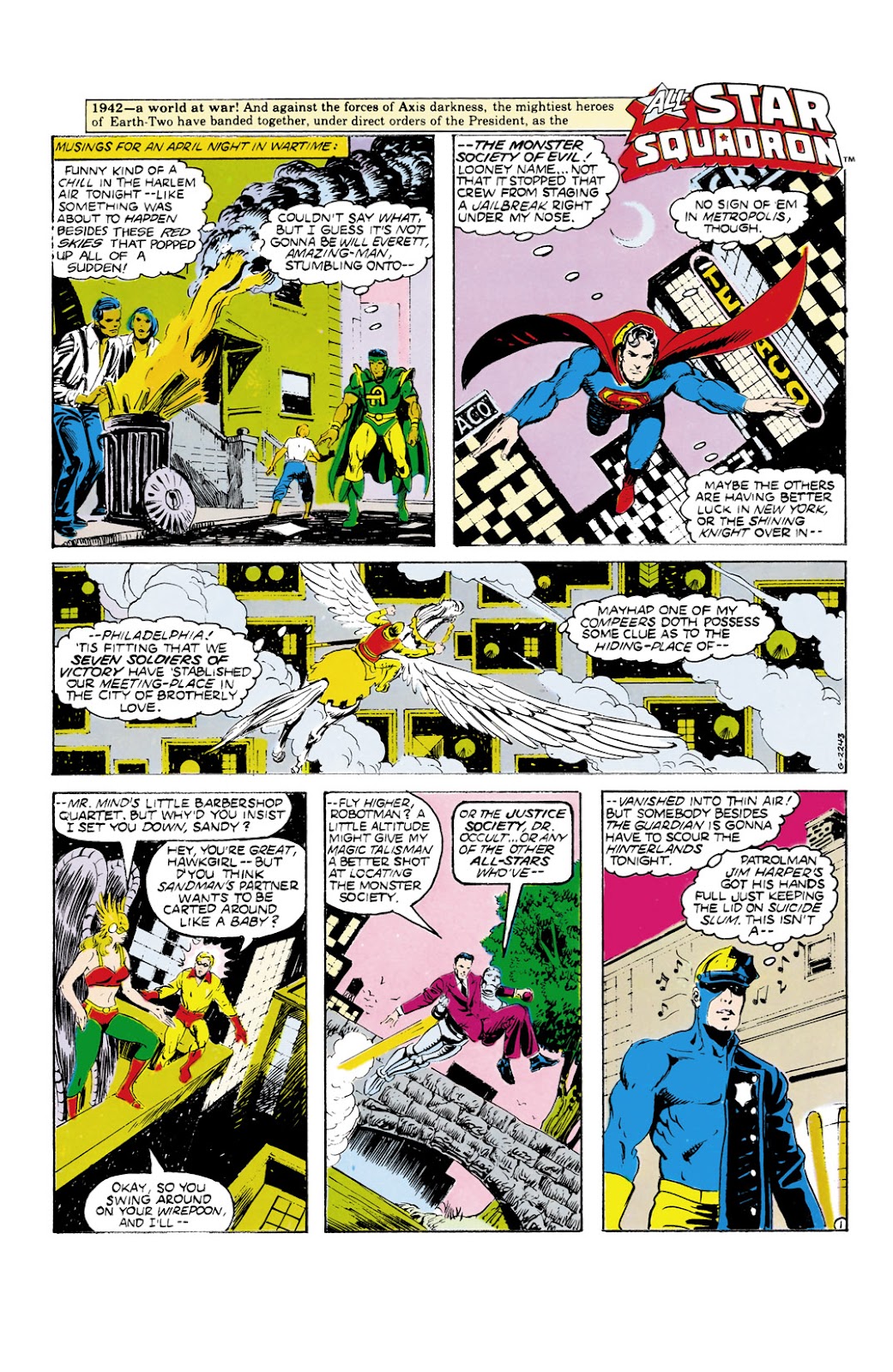 Seems a bit frivolous, for wartime. Shouldn't Superman be shouting... There's a war on! Back at the Perisphere, Hourman is busy losing gin rummy to Gernsback (the robot butler), until Green Lantern shows up with Batman & Robin. We then go into recap mode, for both previous issues and Crisis on Infinite Earths. We then cut to the Monster Society, now known as the Society of Oom, as chrome dome leads them around and the rest play along because Oom has gotten scary powerful. 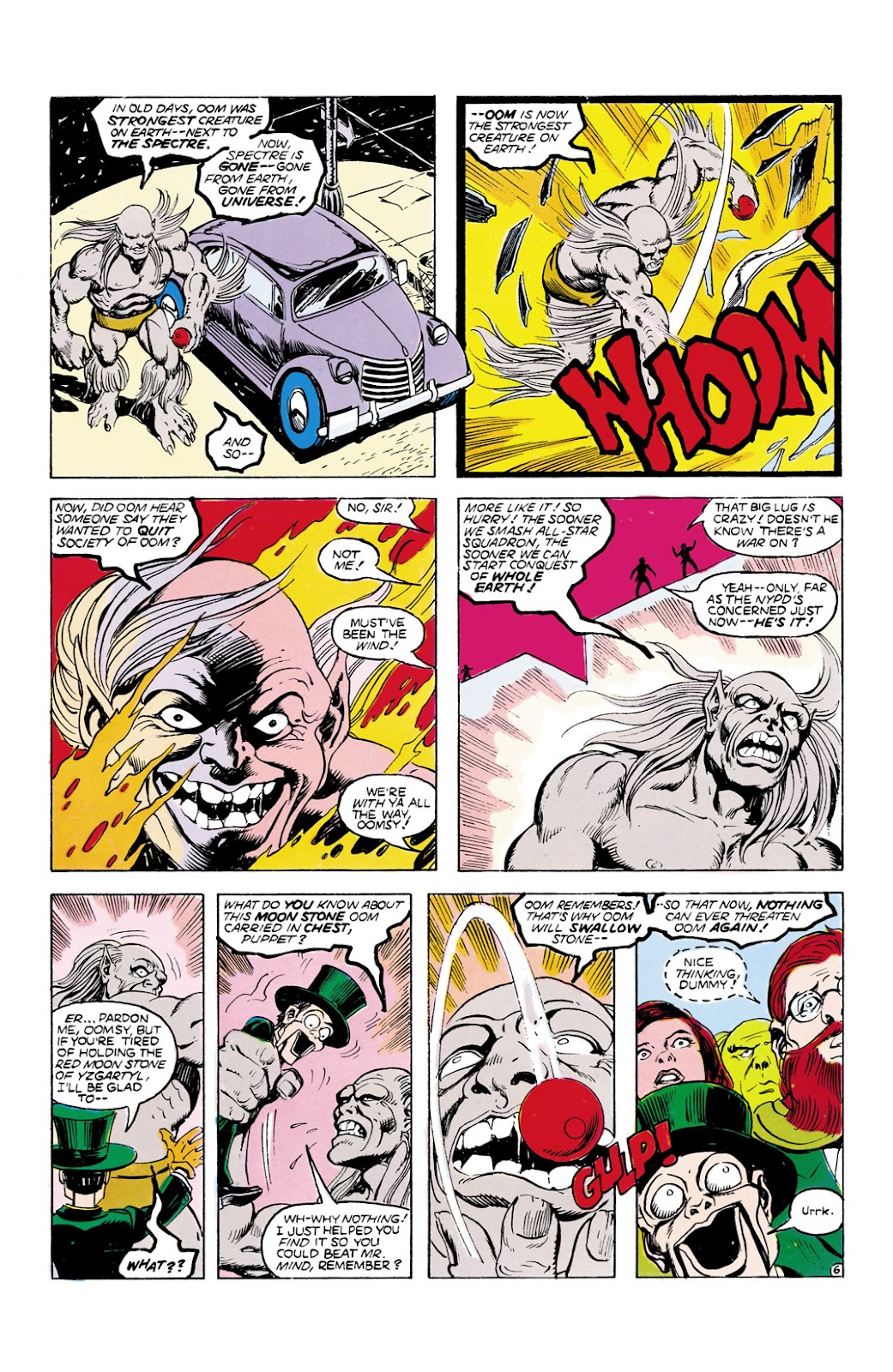 Meanwhile, The Flash is busy rescuing his girlfriend Joan, who was tied to the tracks (and the train's just coming...) (Love The Police; but, Manfred Mann's version is way better!) 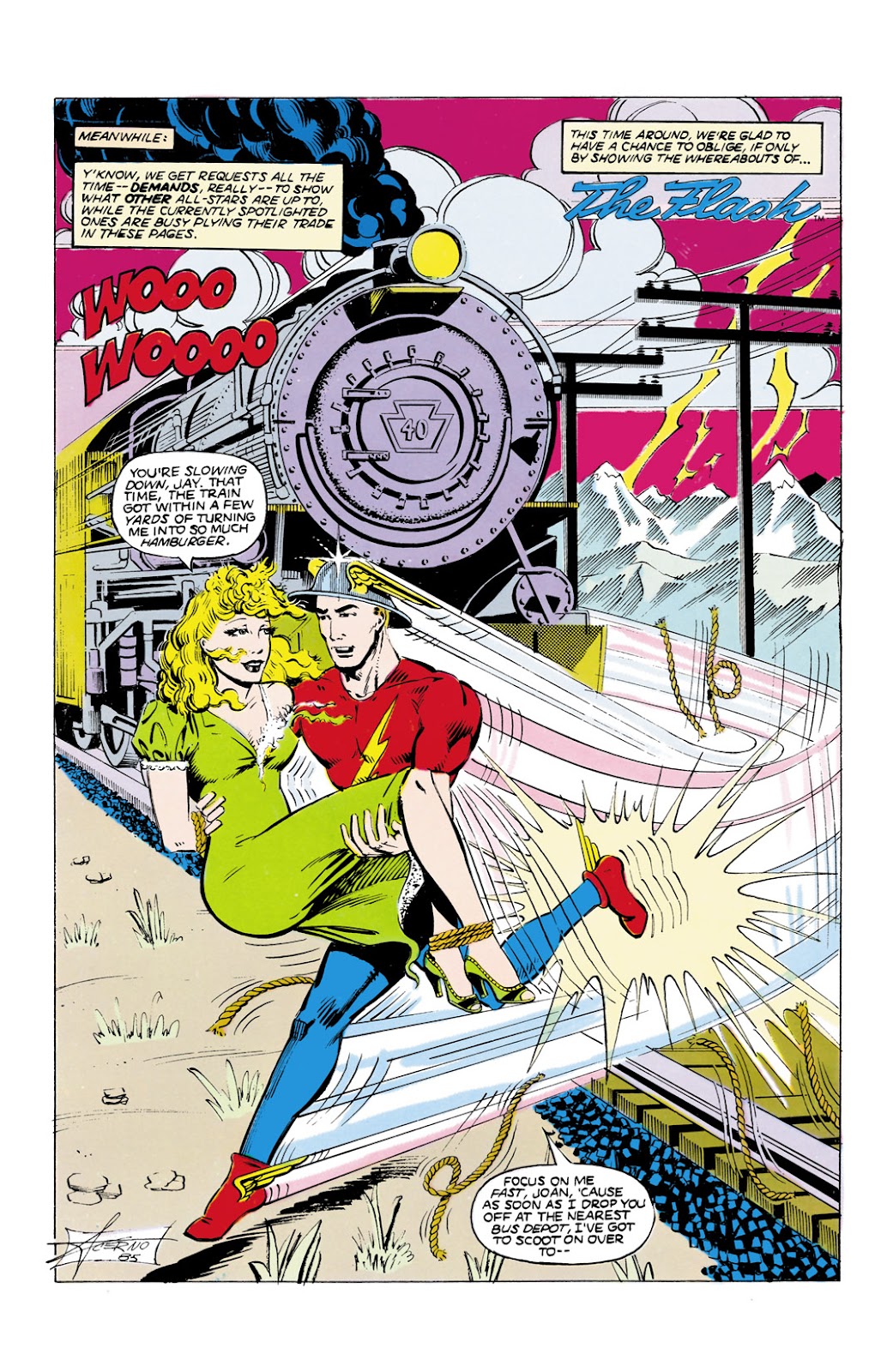 No explanation of why she is tied to the tracks, so we just have to assume it's some kind of sex game between the two. Joan has to live with the regret of being in love with the Fastest Man Alive, as he leaves her and turns up at the Perisphere for the meeting. Everyone reports in...all have no joy. They are interrupted by quaking and rumbling and find out they are under attack by The Society of Ooom, as Mr Who tries to "bowl" the Perisphere... 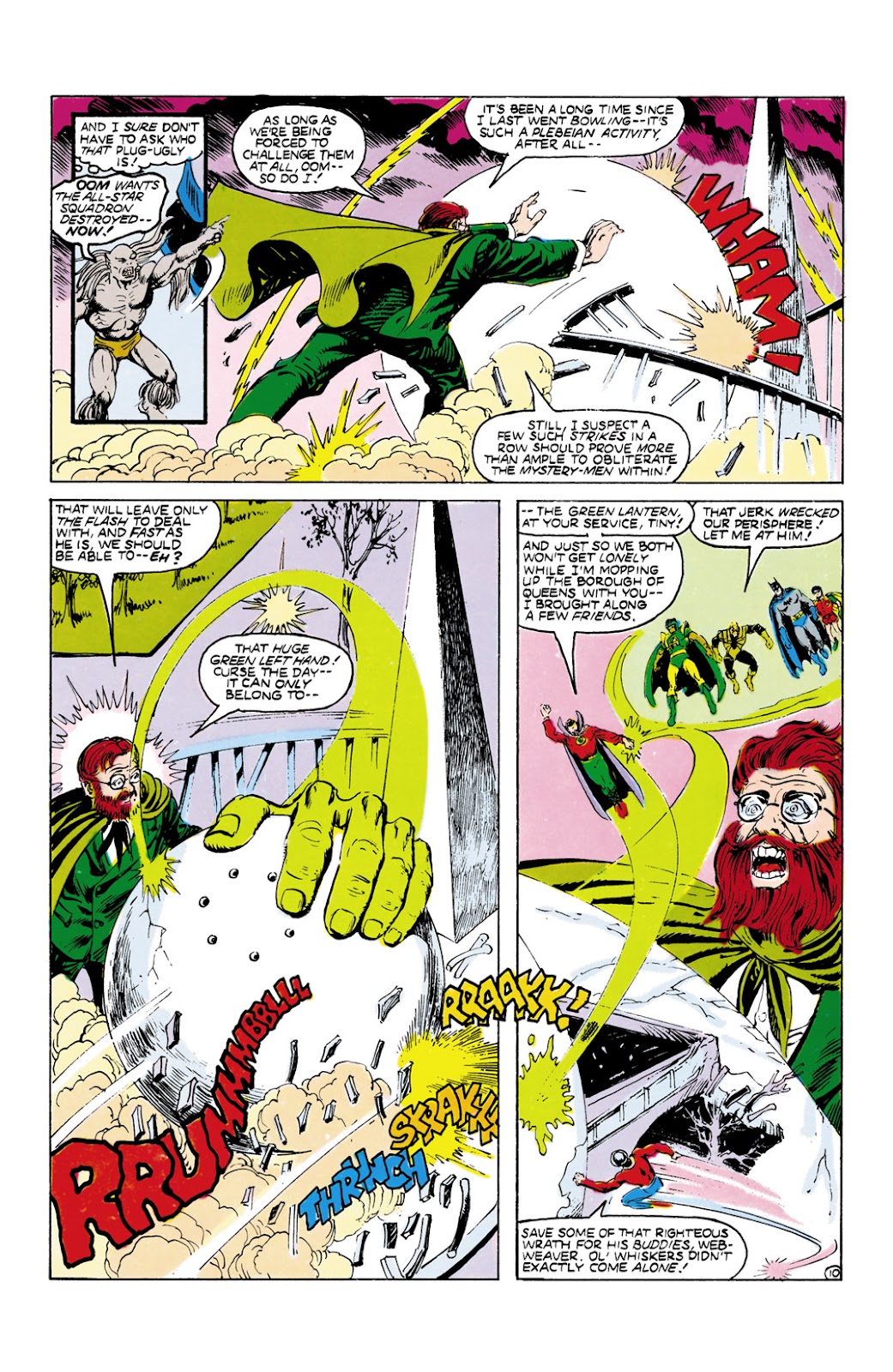 The heroes counter-attack, with GL hitting Who with a green left cross and then Flash repeatedly punching Who in the face, at super speed and Amazing Man turns into rubber and stretches into bonds to hold Who's legs. 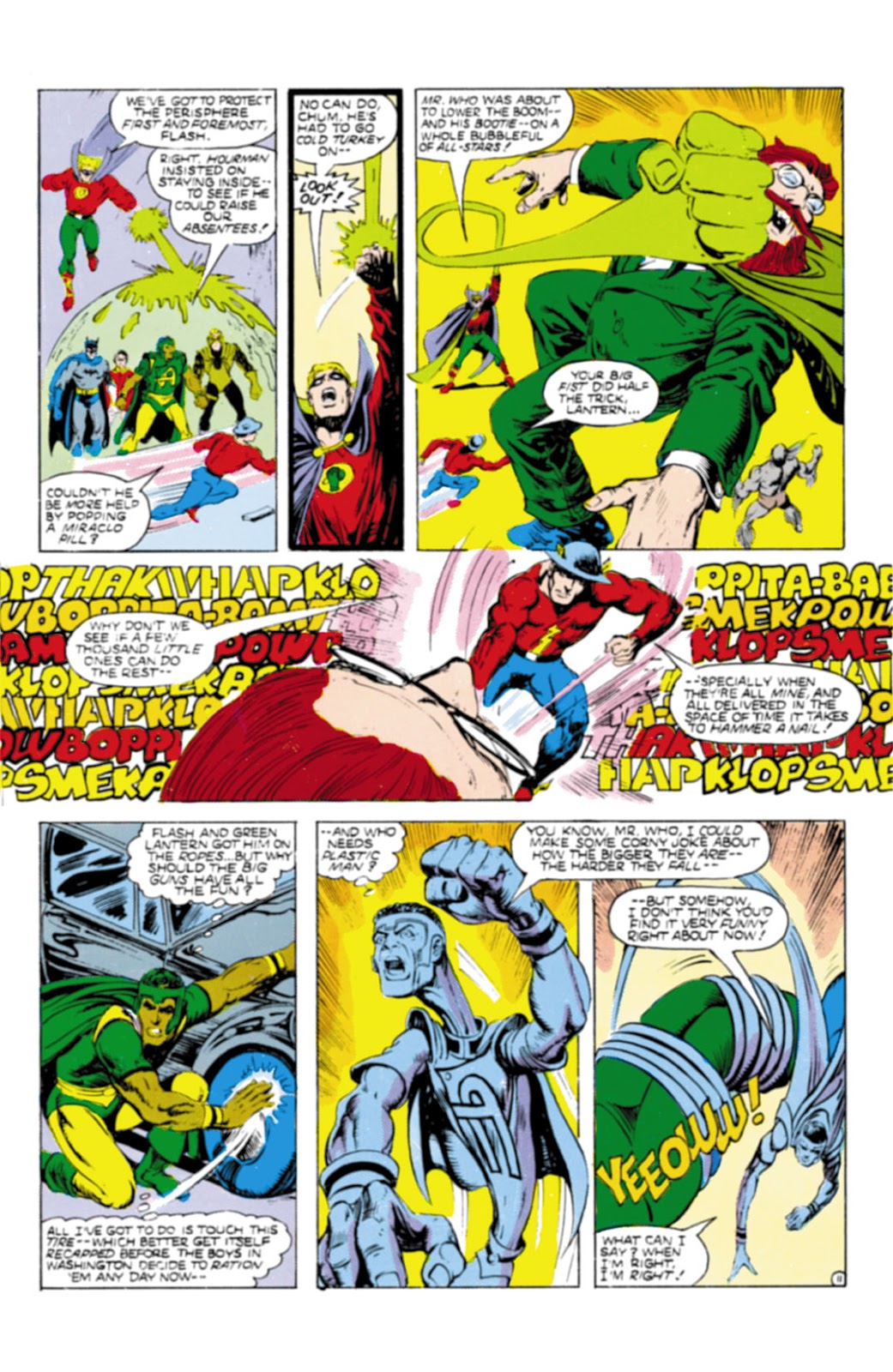 I take it Cody Weiss has been taking note of Ken Bruzenak's work on American Flagg... Nyola is about to get involved, when Batman & Robin tie her up the old fashioned way, eliminating her necessary gestures for her magic rituals (of course they are). Tarantula uses his web line to wrap up Ramulus' plant tendrils and takes him out with a dropkick. GL goes for Oom and has him clamped in place, when the Dummy attacks him, since wood passes through the power ring's energy. While all of this is going on, the storms generated by the red skies are causing havoc and there is a blinding white light, which takes away Amazing Man and Tarantula. Dummy's attack has knocked out GL and he lets his excitement overload his judgement and he accidentally insults Oom, who is rather like another so-called leader and gets testy when his competence is challenged and Dummy wakes up GL to protect him from the big blowhard with the bad hair. He has Hourman raised like a club and GL shakes it off in time to use the ring to blast OOm and remove the crystal from his body (he had swallowed it so no one could control him again). Dummy was then about to knife him, when the absent Dr Fate turns up and yanks him up by the collar and explains he survived on the moon by pulling the oxygen out of a hunk of rock (uh-hunh). Meanwhile, the environment is going nuts. We learn that Amazing Man and Tarantula have been snatched by harbinger for the big Crisis confab. We cut to Firebrand and her band of historical adventurers and heroes... 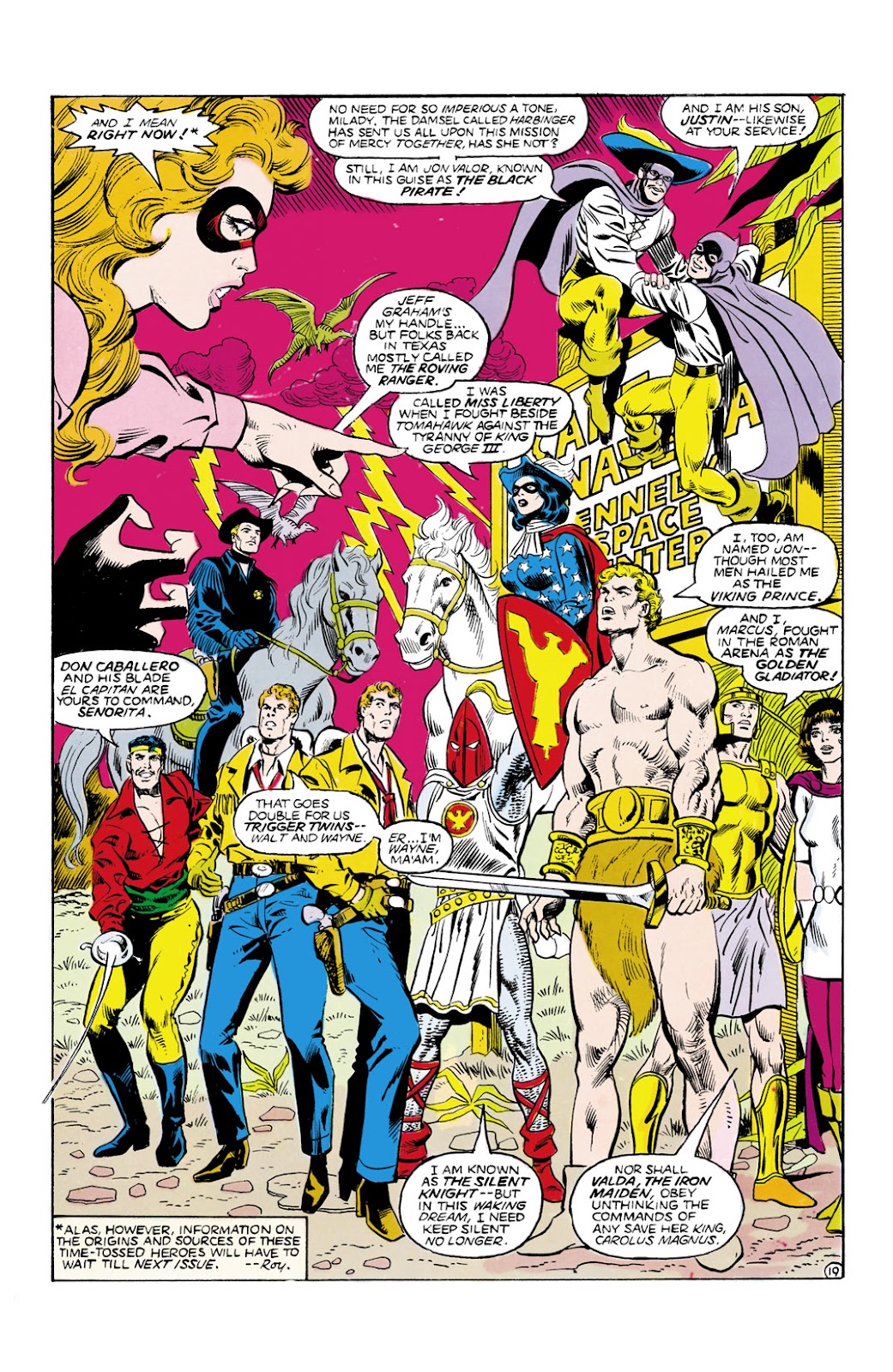 Miss Liberty, The Viking Prince, Silent Knight, Golden Gladiator, Valda the Iron Maiden (Maiden Rules!), the Trigger Twins, Don Caballero (any relation to Guy caballero?), Black Pirate (and son) and the Roving Ranger (not sure if he is Lone or not). they are at Cape Canaveral, which is under attack by Indians...ahem...Native Americans... 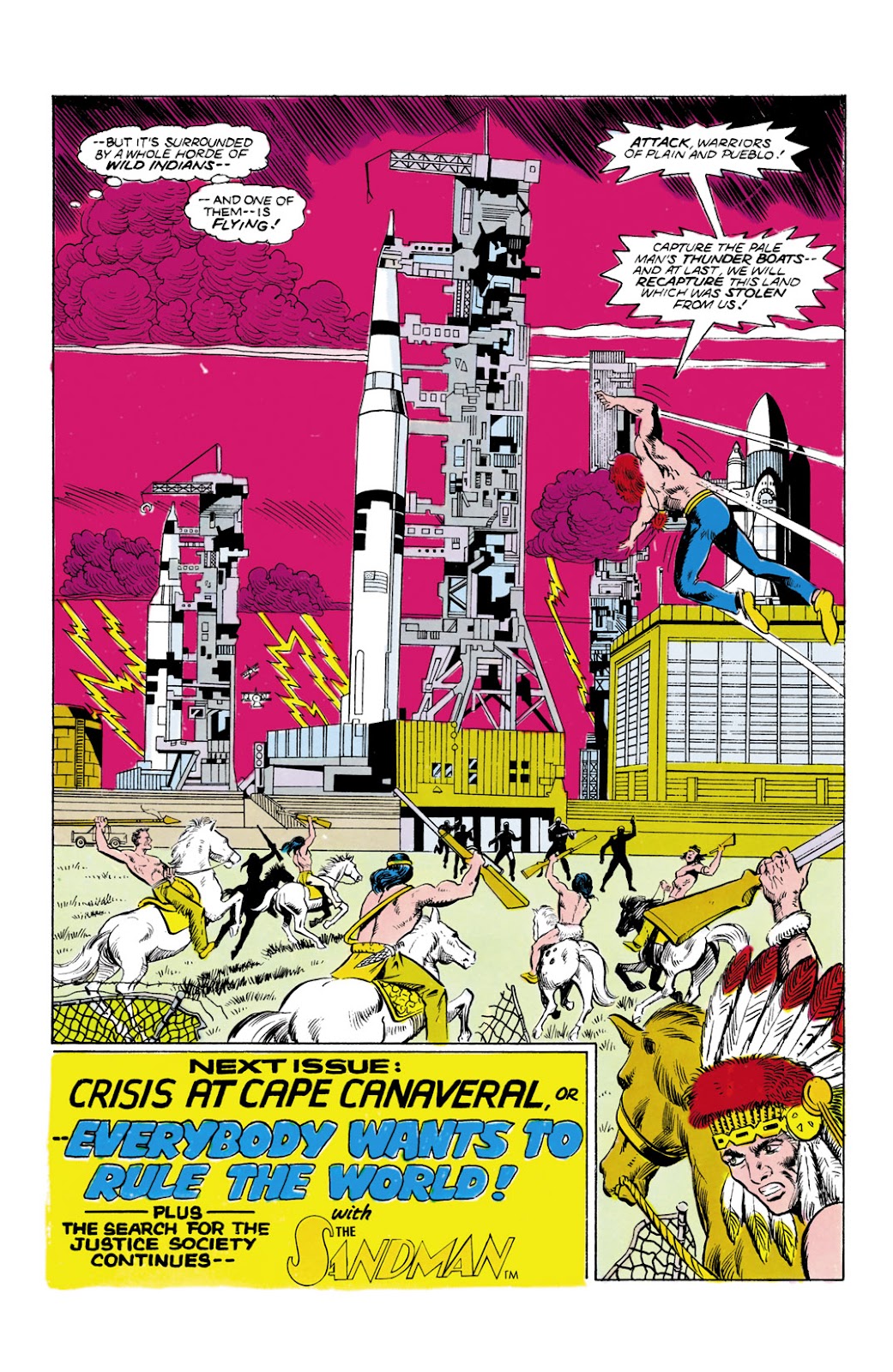 Why do I have William Conrad's voice in my head? Must be something about that last blurb. Thoughts: Well, this made up for the mess of last issue, even if bondage seems to have been a major theme. Makes me wonder what Roy and Dann had been up to! Actually, it's a bit of coincidence. The splash page of Jay and Joan Garrick (well, intended) was done by Jerry Acerno, as a pin-up; but, Roy had discontinued the Golden Age pin-ups; so, it was repurposed here, for the story. Still, bondage does factor into the capture of Mr Who and Nyola, while Tarantula "wraps up" Ramulus's vines. Someone was channeling Marston (which makes it funny that Wonder Woman isn't here). The use of the Dummy to take out GL is quite inspired and I like how GL defeats Oom, with a power ring gastroscopy. Too bad everything is shoehorned into linking to Crisis #5. Firebrand's little band of historic heroes include a batch of western characters (Trigger Twins, Roving Ranger, Don Caballero and Strongbow{who is with the Native group attacking the Cape}) who debuted in All-Star Western #58, which was the issue that followed the final JSA issue of All-Star Comics. So, don't be surprised if Roy kills them all off, as payback for displacing his beloved JSA! Valda the iron Maiden is from Roy's Arak comic, Viking Prince and Silent Knight were major features in The Brave and The Bold and Golden Gladiator was a lesser one there, Miss Liberty was a back-up in Tomahawk, and Black Pirate was a regular in Sensation Comics (where he was pretty much a rip-off of Douglas Fairbanks, who had starred in a movie by that title and from whom Sheldon Moldoff took the likeness). Super Chief is also one of the Natives attacking the Cape. Arak is there, too. Not sure about Firehair. Historical Notes: Roy has all but abandoned real history, as Crisis has caused all kinds of time issues, as well as dimensional crossovers. So....um......er...Joan Williams' (soon Garrick) dress and shoes are period correct. The cars look 40s-ish.... I got nothing. March 1944: On the Eastern Front, the Soviets launch air attacks on Estonia (which is controlled by the Germans) at Narva and Tallinn. Narva, a historic baroque city, is almost completely destroyed while 757 are killed and another 25,000 are rendered homeless in Tallinn. Dutch resistance leader Joop Westerweel is arrested, when he returns from a mission to lead a group of Jewish children into Spain.  Westerweel was a school teacher and a Christian, who helped organize an escape line through France and Belgium to funnel Jews to Spain and Switzerland. He was executed at Herzogenbusch Concentration Camp, in August 1944. Germany turns on its allies in Hungary and Romania, after Hungary tried to sue for a separate peace, with the Allies. It launched Operation Margarethe, the occupation of Hungary, from Austria, while Hungarian regent Miklos Horthy was in Salzburg, Austria, to negotiate with Hitler. This left the Hungarian Army without orders, allowing the Germans to occupy key points, without much resistance. Horthy was coerced into replacing prime minister Miklos Kallay with Dome Sztojay. He was then allowed to return to Budapest. During the occupation, Adolf Eichmann arranged for the transport of half a million Hungarian Jews to the death camps. A second invasion, of Romania, was also planned, to keep them from surrendering to the Soviets; but, it was not implemented and Romania switched sides in August, after a coup. Mt Vesuvius erupted, killing 26. The 340th Bombardment Group was based at Pompeii Airfield, at the base and had between 78 and 88 aircraft destroyed. Also in Italy, anti-fascist strikes broke out in the North, while attacks on Monte Cassino continued. In Balvano, near Salerno, a rail train became stuck inside a tunnel, after losing traction on the rails, due to humidity. The trains were burning lower quality coal, due to wartime shortages and it produced higher levels of carbon monoxide. The train was filled with stowaways and over 500 people (passengers, stowaways and crew) were poisoned and died. Italian Resistance fighters attacked members of an SS Police unit, marching at Via Rasella, in Rome, killing 33. In reprisal, the Germans executed 335 Italians, including 75 Jews, (a 10 to one ratio was ordered, but not enough Italian prisoners were on hand and Jews in custody were added to make up the total demanded) at an abandoned quarry, near Via Ardeatina, inside the tunnels there. The victims, aside from the Jews, included resistance members, political prisoners and numerous innocents who were plucked off the streets. The youngest was age 15. Among the victims were Padre Pietro Pappagallo (inspiration for Padre Pietro in Rossellini's film Rome, Open City) and Italian Army officers Col Giuseppe Montezemolo and Gen Simone Simoni, both of whom had been subjected to incredible torture (including the removal of teeth and fingernails), before being executed with the group. A memorial stands at the site of the massacre, which became a major symbol of the fight against the Germans and a symbol of German cruelty. Incidents like these are reflected in Italian war films of the 1960s and early 70s, showing the fight against the Germans. In the Pacific, 4000 Marines landed on Emirau, in the Bismark Archipelago, to complete the encirclement of Rabaul. No resistance was encountered A small naval installation and floating LSD drydock were constructed there, as well as two airfields, for future operations. With the completion of Operation Cartwheel, the encirclement of Rabaul, MacArthur turned his attention to the march towards the Philippines. Rabaul was cut off from it's supply lines and it an other Japanese forces were now isolated and mostly rendered useless. Japan had lost large amounts of aircraft that could have been used on carriers, the pilots of those planes and a large group of mechanics, when their evacuation vessel was sunk. Rabaul had no aerial defense except anti-aircraft guns and was subjected to regular air raids, which became so routine that the USAAF used the attacks to train and season aircrews, prior to being sent into heavier combat areas. Air strikes continued right up to one week before the Japanese surrender, in August 1945. During a bombing mission over Berlin, bomber DS664, a Lancaster belonging to No. 115 Squadron RAF was attacked by a Junkers Ju 88 night fighter and it spun out of control, in flames. With his parachute destroyed by the fire, Flight Sergeant Nicholas Alkemade decided he would rather die by impact than flame and jumped out of the stricken bomber at an altitude of about 18,000 feet. Pine tree branches and a ground cover of soft snow broke his fall and he emerged with only a sprained ankle. her was captured and interrogated by the Gestapo, who were skeptical of his claims of having jumped without a parachute, until the wreckage of the aircraft was discovered. The Germans gave him a certificate testifying to his feat and he became a celebrated prisoner, until he was repatriated in May 1945. After the war, he worked in the chemical industry and was once interviewed for the ITV program Just Amazing! He died on June 22, 1987. On March 24, just after nightfall, a group of Allied prisoners, at Stalag Luft III, moved into position in a tunnel, dubbed "Harry." The cold had frozen shut a trap door, delaying operations, and it was discovered that the tunnel emerged in a sparser area of the neighboring forest, than had been planned. A signal system was set up and the timetable for moving out prisoners was slowed to about 10 per hour. By just before 5:00 am, 76 men had escaped, before #77was spotted, emerging from the tunnel. The Germans began searching the camp for the entrance to the tunnel, which allowed the remaining prisoners to destroy forged papers. One of the last huts searched was No. 104, where the entrance was hidden; but, the Germans failed to locate the entrance. Finally, a guard was sent from the exit, back through the tunnel, until he became stuck. He called out for help and his cries were eventually heard in Hut 104. The Germans sent out an alert. Many of the escapees had difficulty locating the local rail terminal and missed most of the night trains. They then tried to either walk across country or wait at the terminal for later trains. The unseasonably cold winter weather had forced many escapees to abandon the fields and woods and travel on the roads. Thus, the Germans began to rapidly arrest the escaped prisoners. 73 were recaptured and Hitler ordered them all to be shot. Goering, Filed Marshall Keitel, Major -General Westhoff, Major-General von Graevenitz succeeded in persuading Hitler that German prisoners would be subjected to reprisals, by the Allies. Hitler changed his order to shooting "more than half." Himmler was given the order and passed the selection to General Nebe and 50 of the recaptured were executed. The organizer of the escape, Roger Bushell was specifically chosen for execution. 17 prisoners, of the surviving 23, were returned to Stalag Luft III. The camp commandant, Col. Friedrich Wilhelm von Lindeiner-Wildau was relieved of command, interrogated and threatened with court martial; but, feigned mental illness to avoid imprisonment. he was later wounded by the advancing Red Army, while leading an infantry unit, during the defense of Berlin. He was captured by the British and was a prisoner, for 2 years, at the London Cage, a special facility for high ranking military, SS and Nazi party prisoners, where they were interrogated. Investigations found that the commandant had run the prison within the rules of the Geneva Convention and he had won the respect of the senior officers for humane treatment. He was repatriated in 1947 and died in 1963. 3 prisoners succeeded in escaping: Norwegian pilots Per Bergsland and Jens Muller and Dutch pilot Bram van der Stok. The two Norwegians escaped by rail, then by boat, with the help of friendly Swedish sailors. van der Stok spoke fluent German, among other languages and had an early berth in the escape rota. he was able to link up with the French Resistance and was evacuated to Spain, where he was able to be repatriated to the UK, via the British consulate. In the film, The Great Escape, he is portrayed by James Coburn, as the Australian Sedgewick, while Bergsland and Muller became the inspiration for Charles Bronson's Danny Velinski and John Leyton, as Willie. The film depicts Americans as part of the camp, which was true and they did help with the digging of the three tunnels and related activities; but, the American prisoners had been removed from the camp before the escape. Among the prisoners in the camp were future George Smiley, actor Rupert Davies (The Spy Who Came in From the Cold), British actor Peter Butterworth and writer Talbot Rothwell, who worked on the Carry On films, Major League pitcher Phil Marchildon, and WGN Chicago children's tv host and broadcasting legend Ray Raynor (Oliver O Oliver, on The Bozo Show and host of Ray Raynor and His Friends).
|
|
|
|
Post by mikelmidnight on Dec 21, 2020 12:31:51 GMT -5
(Love The Police; but, Manfred Mann's version is way better!) The Police are not as good as Madness. That kind of thing … actually makes me happy? This is a minor example, but there is so much amazing work by comics professionals that just sits rotting away in a cabinets, so I'm always pleased to see someone make use of something that'd otherwise be lost. |
|
|
|
Post by codystarbuck on Dec 21, 2020 23:29:47 GMT -5
(Love The Police; but, Manfred Mann's version is way better!) The Police are not as good as Madness. That kind of thing … actually makes me happy? This is a minor example, but there is so much amazing work by comics professionals that just sits rotting away in a cabinets, so I'm always pleased to see someone make use of something that'd otherwise be lost. I like Madness; but, would say they are kind of apples and oranges. Either way, neither can hold a candle to Dire Straits. |
|
|
|
Post by mikelmidnight on Dec 22, 2020 12:49:17 GMT -5
That's an Alan Moore quote, from Skizz (his take on E.T.). Alien rather than hanging out with little boy, ends up with punkette. Later, when it's on the run from uniformed officers who are persecuting it, the alien thinks to itself, "It's true what she told me, the police are not as good as madness," and the panel shows the punkette surrounded by ska albums.
|
|
|
|
Post by codystarbuck on Dec 25, 2020 16:50:24 GMT -5
All-Star Squadron #55 Not exactly sure when this issue was published...... Creative Team: Roy & Dann Thomas-writers/editor (Roy), Arvell Jones & Tim Burgard-pencils, Vince Coletta & Tim Burgard-inks, Cody Weiss-letters, Carl Gafford-colors Tim Burgard handles art on the back-up story, which features Sandman, as Roy rehashes Shanghaied in Space some more. Synopsis: Firebrand and her band of historical heroes are at Cape Canaveral, in 19..19..1985, where it is being attacked by a band of Native American characters from DC books. The Natives are facing soldier wearing khaki uniforms, green berets, and some are carrying the M3A1 "Grease Gun" submachine gun. I don't know if these are supposed to be time-displaced Special Forces soldiers from Vietnam or if Arvel & Carl needed better reference material (M3 was outdated by Vietnam and no one was using it in 1985; Special Forces doesn't handle security at Cape Canaveral (NASA security and Air Force Air Police, who wear blue berets) and the military had the woodland camo utilities, by that stage. Anyway, Danette fires some flame bombs to keep them away from the shuttle, as her swordspeople and gunslingers move in. 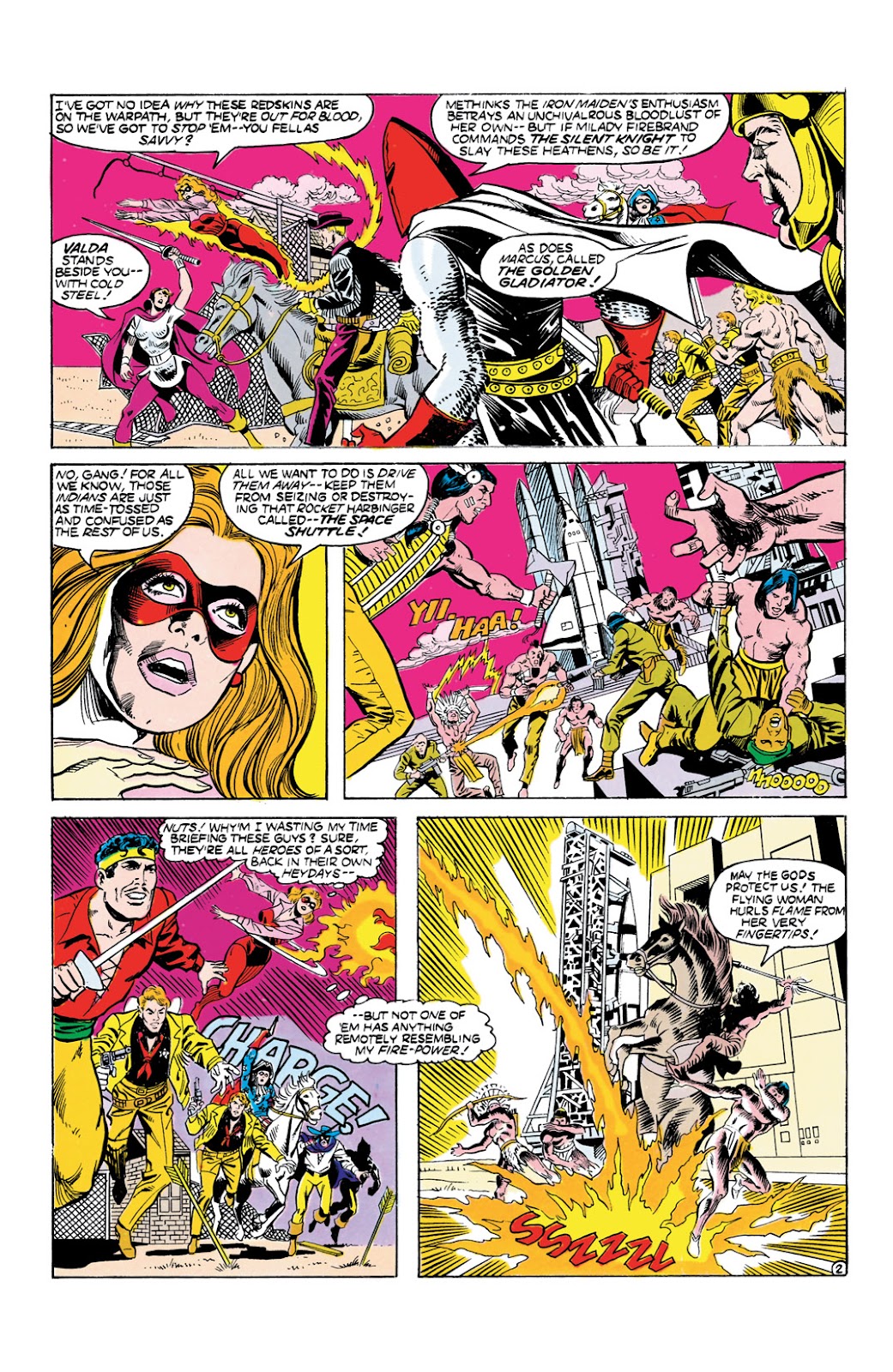 They have their individual skirmishes. Valda the Iron Maiden (she's the one with the Eddy t-shirt  ) meets up with Arak, who says the Natives have cause for attacking. Danette faces Super Chief, who has her outclassed, until she figures out his amulet might have something to do with it and sears away the leather thongs that hold it in place and he plummets to the ground, but has time for a speech. 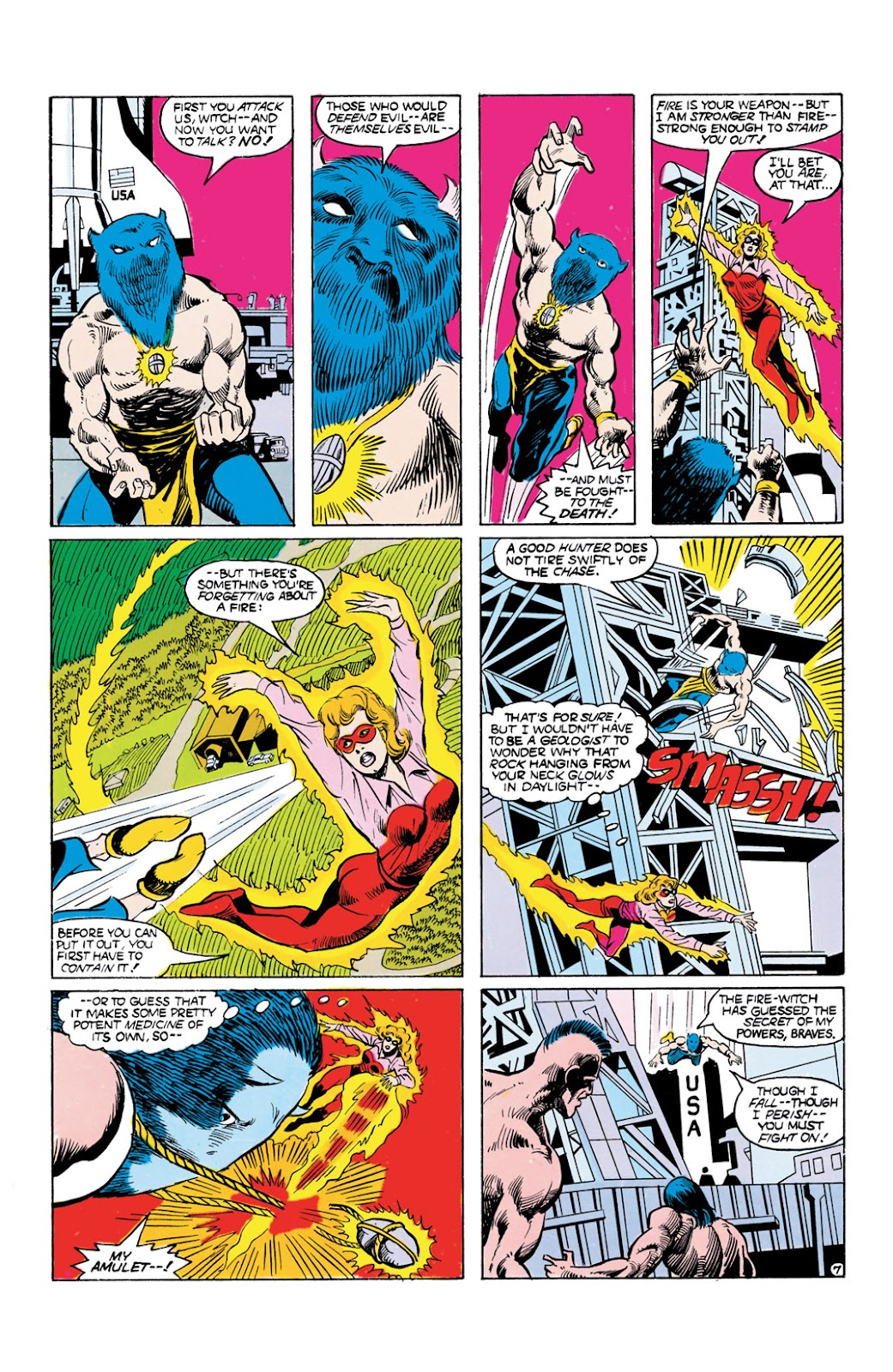 Danette saves him, in the nick of time (When else?), but is knocked unconscious. Super Chief stops a warrior from killing her and then the ground pounders turn up. However, they shoot at tghe White Guys, so they are obviously phonies and Danette's band joins the Natives in fighting them. 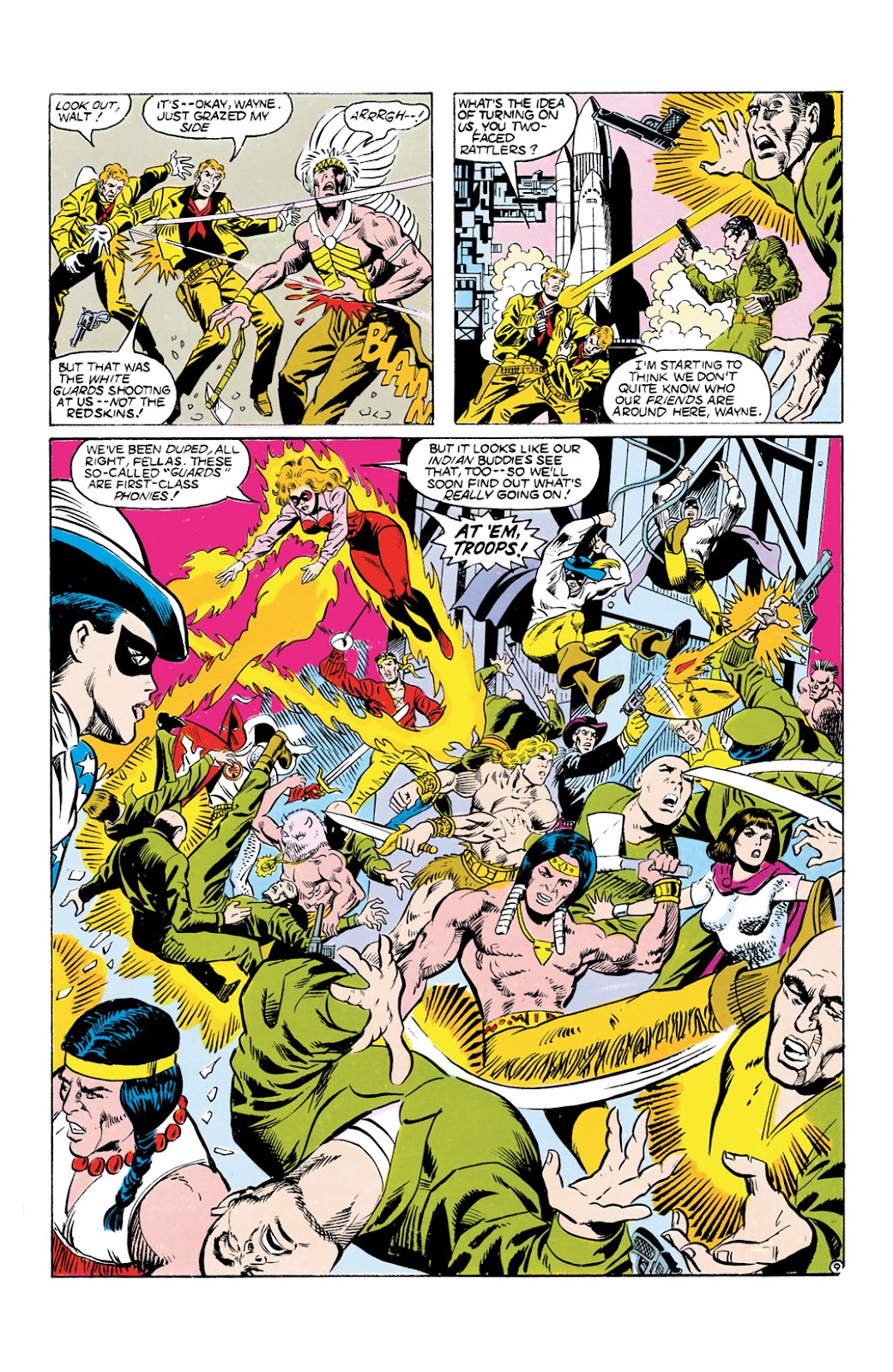 We cut to inside the NASA facilities and find the Ultra-Humanite (in his 1985 ape form) is behind things. he is trying to hijack the shuttle, but the program manager, one Dr Terri Rothstein, is defying him (remember that name). Terri gives in to save her colleagues and Ultra makes a crack about Jews abhorring violence and name drops Auschwitz. He hasn't been reading my historical notes about the Warsaw Ghetto Uprising, the revolts in Treblinka and Sobibor and the uprising in Auschwitz, itself. Should have spent more time in the library! He is interrupted by one Terry Kurtzberger, aka Cyclotron! 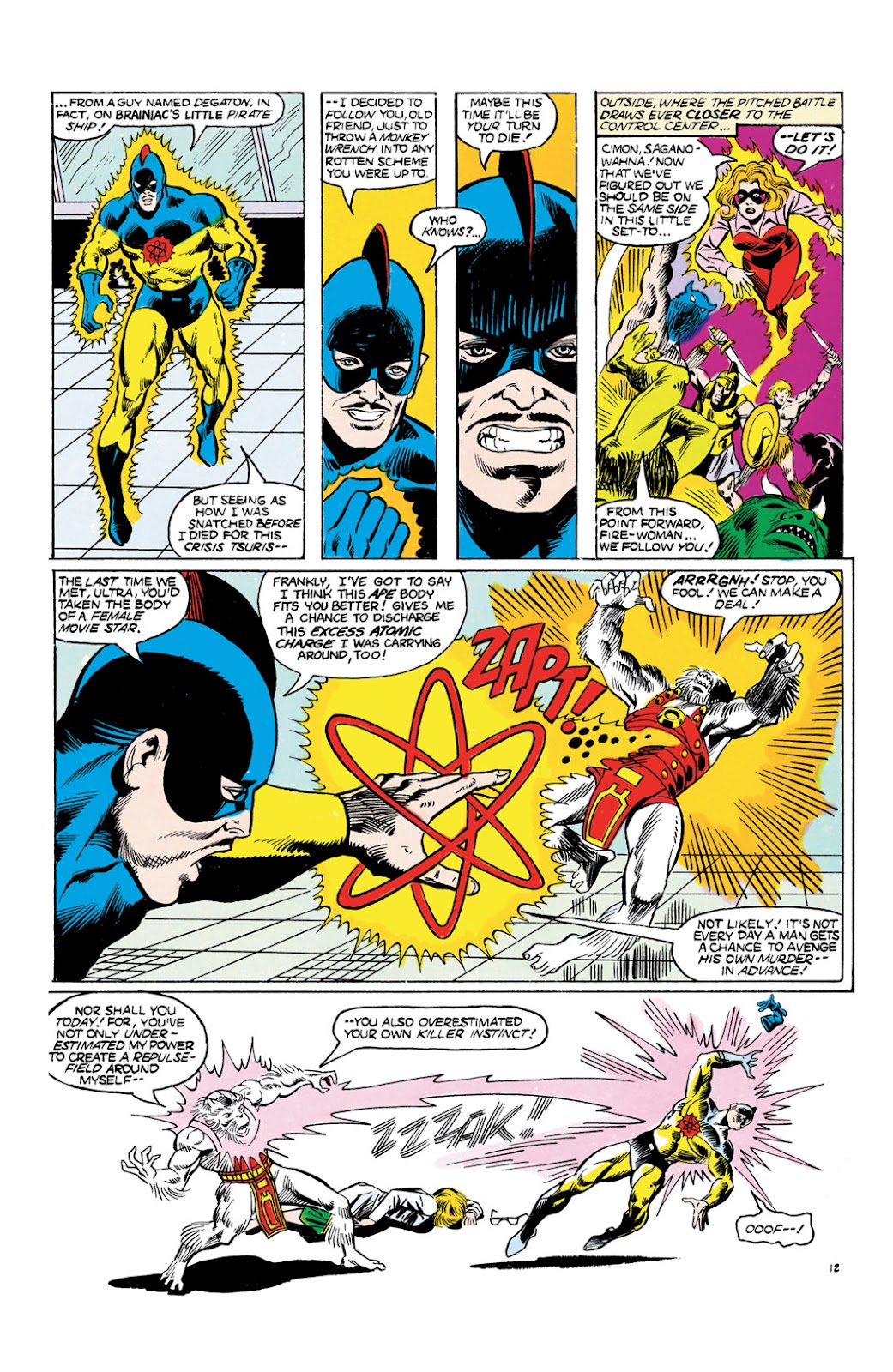 Danette leads her team inside the building and sees Terry and is shocked, which proves to Cyclotron that he was dead, but snatched from time just before. Ultra has Terri Rothstein as his hostage and drags her to the shuttle. Cyclotron tells Danette, who reveals to him that Dr Terri Rothstein is his daughter, all grown up! 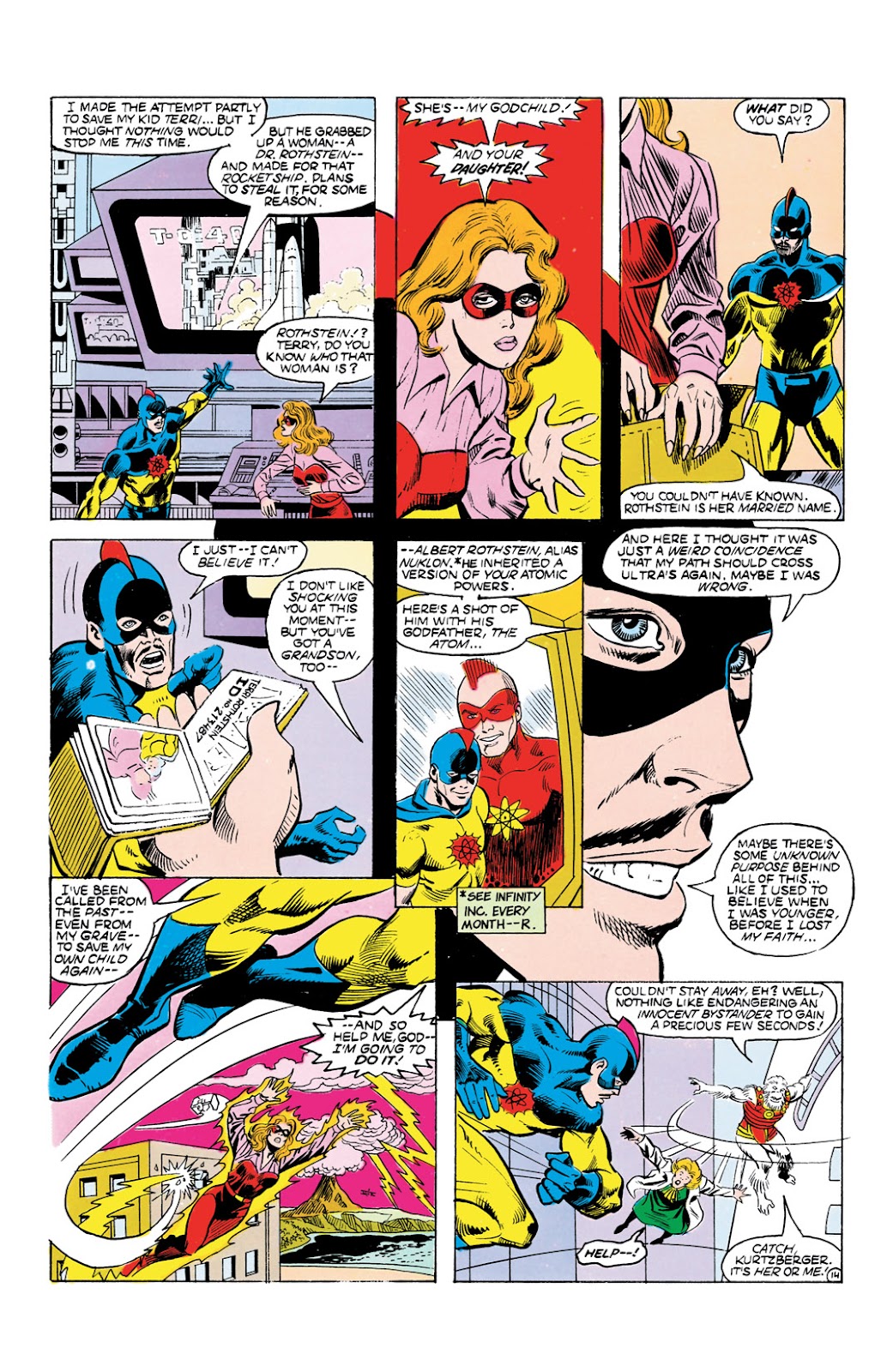 He also learns he has a grandson, Al Rothstein, aka Nuklon, of Infinity, Inc, and that The Atom is Al's godfather. Cyclotron realizes that he was pulled from time for this purpose, to save his daughter and he goes to it. Ultra tosses her off the gantry, but her father catches her, as Ultra blasts him with a brain bolt. They fall, but, Cyclotron hits the ground first and cushions the fall for his daughter. She is unconscious; but he is dying, again and he disappears. Ultra starts the launch and Danette has to work fast to save Terri. She absorbs the flame and is able to save her goddaughter, who recognizes her. She tells Danette that she punched in coordinates for the sun, into the shuttle, so Ultra is headed for a barbecue. Sandman: Wesley finds himself in a rocket, headed for Uranus ( :  On the planet are crystalline lifeforms, whose leader has a dream about flowers from space and they witness Sandman's rocket landing. he is asphyxiated by the atmosphere and they bring an old fashioned bubble helmet and oxygen tanks to revive him and then tell him their woes... 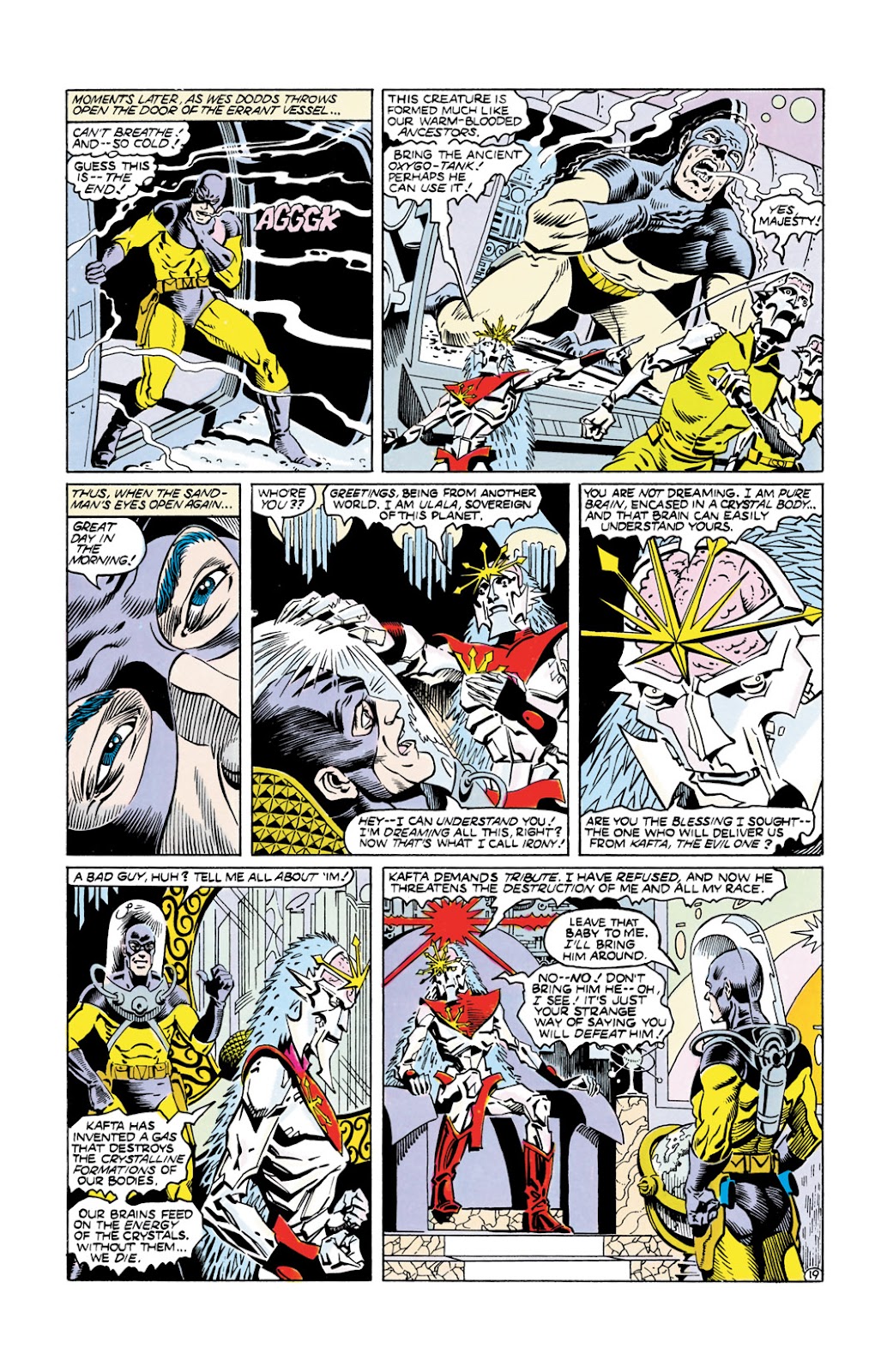 Sandman takes a rocket bike to stop Kafta from poisoning everyone. He breaks into the place, fights him, almost gets poisoned, but wins and everyone is happy. Thoughts: First up, the Shanghaied in Space revisit again serves no real purpose except to feed Roy's nostalgia. I'd have to check the letters pages to see if anyone else cared; but it doesn't do much for me. The main story is pretty good, though Arvell needs better reference material. Roy gets to play around with the historical characters, while also revisiting his storyline with the Ultra-Humanite, in his later form. Crisis allows him to have Cyclotron be the cavalry to save his daughter, which is a nice sentimental touch. Crisis would prove to be a bloodbath, but, it did let the fallen go out as heroes. Having Cyclotron save the daughter he never got to see grow up is especially poignant. Too bad Roy didn't get to use Nuklon, too. At first, I thought maybe the green beret guys were displaced soldiers, or even the Fightin' 5 (they had red berets, though); but, no dice. Just bad reference. One thing is for certain, Arvell Jones cannot draw a beret. It is something I have noticed with many comic artists. They can't seem to get how it conforms to the head and how a military beret is draped (depending on the military). Mike Grell could (he is a Vietnam-era veteran) and Howard Chakin does a good one (Ironwolf, also a character or two in American Flagg) and Joe Kubert could, mainly because he drew the Tales of the Green Beret comic strip. Tim Burgard, who handles the Sandman story, did a little work in comics, but ended up in Hollywood, doing storyboards, on such films as Stargate and Mars Attacks. Historical Notes: I have already covered how wrong Ultra-Humanite was about the Jews and Auschwitz, though much of that came late in the war, as the situation became clear, though there were Jewish refugees who fought in the Allied armies, as well as Jewish partisan groups, in Eastern Europe. Miss Liberty name drops Drums Along the Mohawk, a 1936 bestselling frontier adventure novel, by Walter D Edmonds, set during the American Revolution. It was adapted into a film, starring Henry Fonda and directed by John Ford... Yup, a John Ford film, with Ward Bond; who'd a thunk it? The Space Shuttle launched for the first time on April 12, 1981, with the Columbia. By July, 1985, there had been 18 shuttle missions, with STS-51-F set to launch on July 29. 5 months later, on January 28, 1986, on STS-51-L, the O-ring on the SRB booster rocket failed to seal properly and the shuttle Challenger was destroyed by an explosion of fuel, just after liftoff, killing all on board, including teacher Christa McAuliffe, as well as Francis Scobee, Michael Smith, Ellison Onizuka, Judith Reznick, Ronald McNair and Gregory Jarvis. Then, on January 16, 2003, at the end of mission STS--107, the Columbia broke apart upon re-entry, after having suffered damage to the heat tiles on launch, after a piece of insulation broke off and impacted the port wing. The crew, consisting of Rick Husband, William McCool, David Brown, Kalpana Chalwa, Michael Anderson, Laurel Clark and Ilan Ramon, perished in the disaster. The last shuttle flight, STS-135, with the Atlantis, was on July 8, 2011. On a personal note, my late uncle, Roman, worked for Rockwell, on the design project for the fuel tanks. He passed away last year, of a heart attack. In the early to mid 1970s, my family took a Christmas vacation trip to Florida, to both visit relatives and have a holiday. We visited Cape Kennedy and saw animated conceptual films of the shuttle, which was still either in the design phase or had just begun the construction phase, for the Enterprise. I think artist Robert McCall captured the spirit of the Space Shuttle program, and those lost during the program, with his painting, The Spirit of Chalenger...  April 1944: A quieter month for military operations. The Japanese launched an offensive in China, Operation Ichi-Go, designed to deny the allies air bases in southern China, from which it could launch bombing attacks on the Japanese home islands. Operations continued through December, with China losing much ground. General Joseph Stillwell sought permission from Gen Marshall to take over all Chinese forces in the theater, but ended up being dismissed to appease Chiang Kai-Shek. The end result badly hurt the standing of the Nationalists, especially among journalists in China, who saw Mao's movement as more democratic than the Nationalists, who were seen as more corrupt and reactionary. However, Allied censorship prevented much of this from going out to the American public. The Holocaust continued. Rudolf Vrba and Alfred Wetzler escaped from Auschwitz and wrote a detailed report of life within the camp. It gave detailed descriptions of the gas chambers and gave estimates of the numbers killed. It is believed to have been influential in Hungarian regent Miklos Horthy halting the expulsion of Hungarian Jews to Auschwitz. Copies eventually reached Switzerland and were widely covered by the Swiss press, which brought it to the rest of the world. Adolf Eichmann opened negotiations with Joel Brand, of the Hungarian Aid & Rescue committee, to release thousands of Jews, in exchange for supplies for the German army. Soldiers of the 12th SS Panzer Division murdered 85 civilians after their train is blown up, in France. Italian Fascist philosopher Giovanni Gentile was assassinated by Bruno Franciullacci, a partisan. The Allies begin bombing Belgrade, Yugoslavia, killing 1100, including worshipers at the Orthodox Easter services. 60 Squadron SAAF (South African Air Force) flew a photoreconnaissance mission over Auschwitz, bringing Allies some of their first photos of the camp. Exercise Tiger was carried out at Slapton Sands, near Devon. This was a dress rehearsal for D-Day, with the area simulating Utah Beach. On 28 April, German E Boats attacked ships during landing exercises and caused the deaths of 749 men. The ships were not zig-zagging and made an easy target and the Germans went after it. The disaster angered Eisenhower, especially after reports that the ships were not sailing properly, as well as the Germans sailing through British patrols. 10 officers were missing, who had BIGOT clearance, which gave them details of the Normandy landings. The planned invasion was nearly called off until all 10 were accounted for. It also tipped the Allied hands to the Germans and Hitler ordered Normandy be reinforced, though he was still convinced that an invasion would come from the Pas de Calais. Information about the disaster was suppressed until after D-Day and most families never learned how their loved ones died until years later, after books exposing the disaster had been published, starting in 1988.
|
|
|
|
Post by codystarbuck on Jan 3, 2021 18:22:53 GMT -5
All-Star Squadron #56 The Seven Soldiers of Victory. You know, someone needs to write a mini-series, where the Seven Soldiers of Victory meet up with the Fantastic Four, The Warriors Three, the Fightin' 5 and the Secret Six. They should battle The Sinister 6, The Unholy Trio, and the 100, all set to the music of 10,000 Maniacs. I'm sure it would be written by a room full of monkeys. Creative Team: Roy & Dann Thomas-writers & editor (guess which one?), Mike Clark & Mike Harris-pencils, Vince Coletta and Tony DeZuniga-inks, Cody Weiss-letters, Carl Gafford-colors More Roy indulging is inner nerd, as he is revisiting more old Golden Age tales. Synopsis: In Philadelphia, The Shining Knight is riding Winged Victory over the city, as a robot smashes into a bar and grabs a guy named Mickey (Finn?) He loads him on a truck, which heads to the waterfront (where Brando and Rod Steiger are waiting). Sir Justin tries to sneak in and gets a robot punch to the back of the head. he wakes up a prisoner... 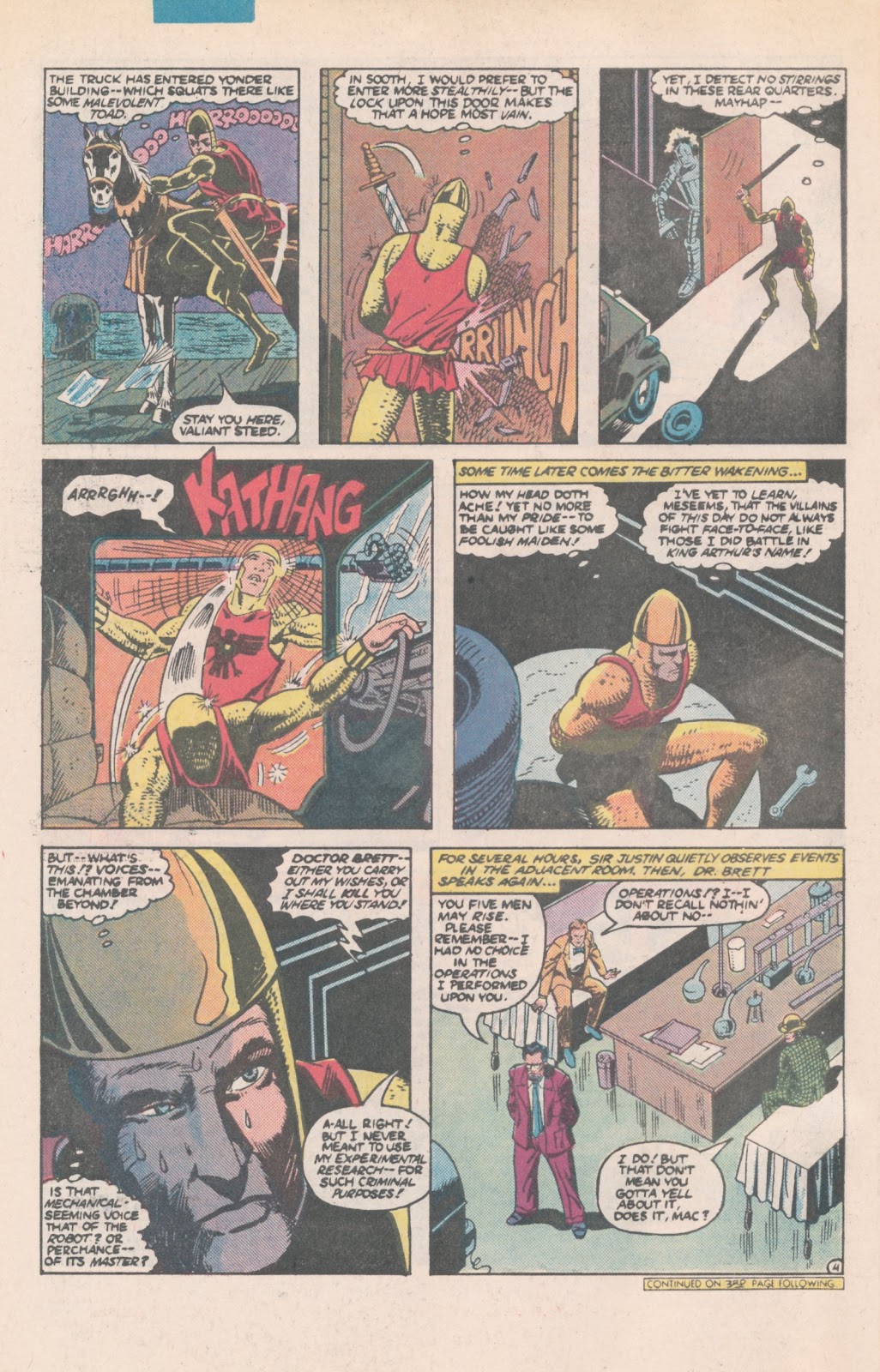 The captured hood and several others awake from operations which have heightened their senses to great degrees. The meet the Sense-master, a dude in a tube, who controls the robot and offers them the powers, plus money, in exchange for stealing 5 jewels. 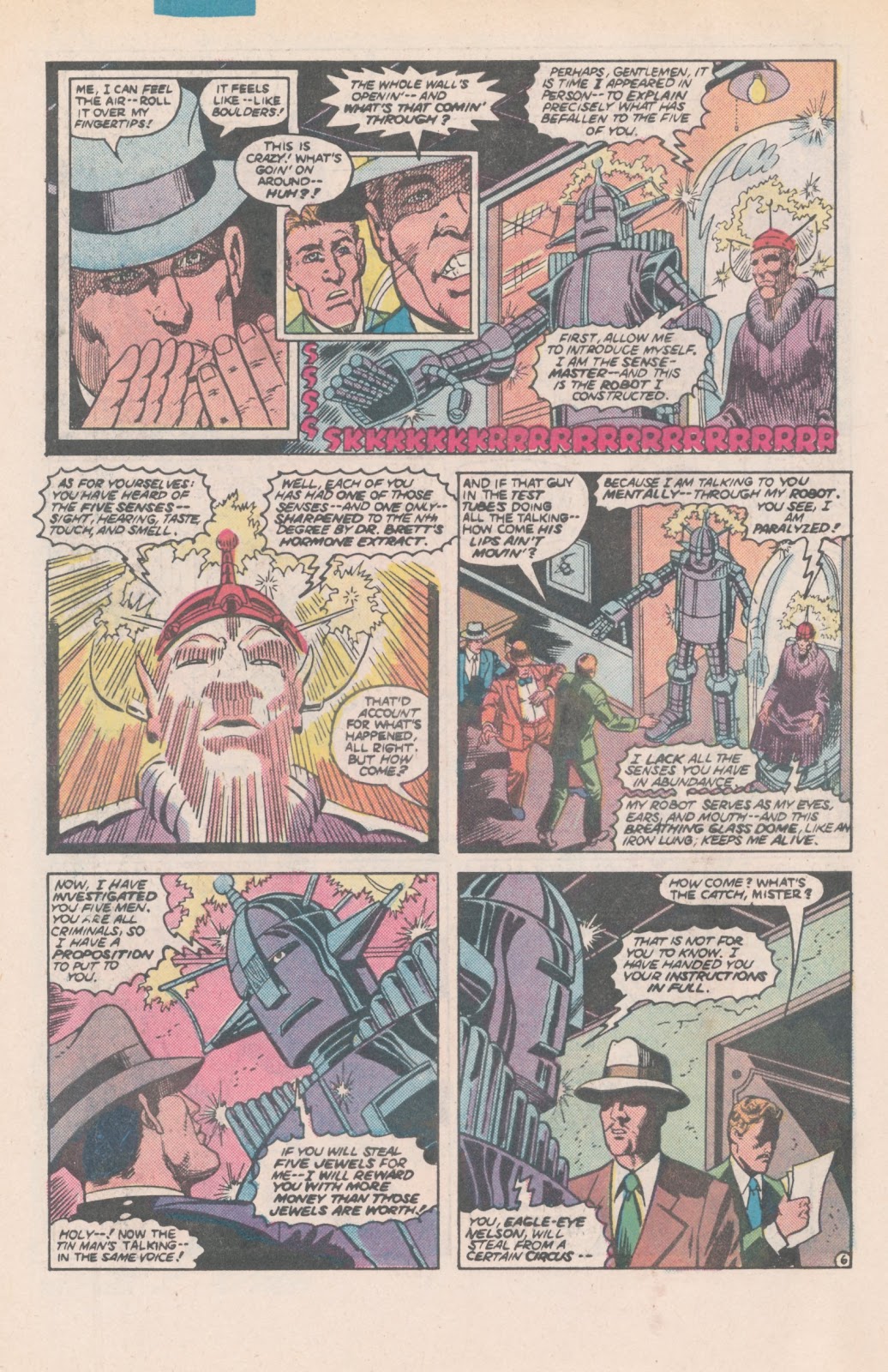 The Shining Knight gets dropped out a trap door, into the ocean below; but, his sword falls with him and he uses it to free himself and reaches the surface. he goes to call the other Soldiers. 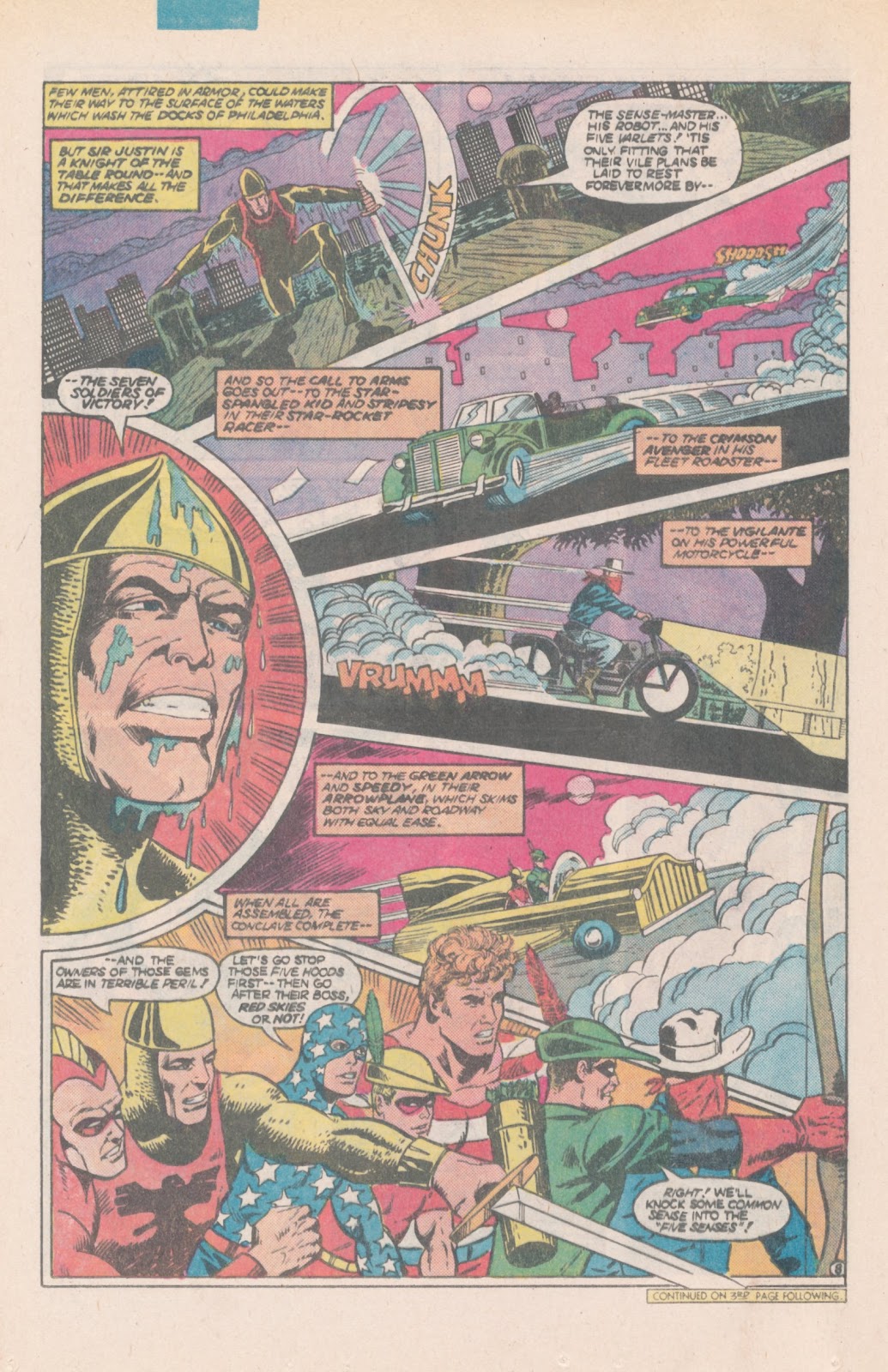 Mickey Gordon (not Finn, alas) goes to a radio station, where his super hearing catches a beautiful woman playing piano. They bond over it and Mickey is torn about stealing her diamond necklace; but, the point is moot as Sense-Master sent another goon along who takes it. Crimson Avenger and Wing were following and they spot the other goon and give chase up a transmitting tower; but, the guy gets away in a blimp! Sir Justin faces Fingers O'Fallon at the home of Don Coty, an explorer with a Cervantes fixation (Don Coty...Don Quixote). Sir Justin decks Fingers, but Sense-Master had a trained brid on the case and he makes off with a topaz stone (hey, my birthstone!). Star Spangled Kid and Stripesy face the Human Bloodhound, who steals an emerald ring from Sylvester's mother. They beat him with sneezing powder, but he had already switched the ring. Vigilante faces Leo Palates, who is the taste goon. They battle, but a cook is a pawn of the Sense-Master and gets the stone. At the circus, Green Arrow and Speedy face Eagle-Eyed Nelson, who is after a ruby and grab him after a trained dog has the jewel. The hoods return to the Sense-Master and he electrocutes them (wired floor, while he is inside a glass tube). The Seven Soldiers come bursting in too late. They discover that the Sense-Master is a wax dummy and Dr Brett, who performed the operations is the real crook, hidden inside the robot shell. The jewels combine with a statue, to open it up and reveal the Life Stone, which can animate statues. 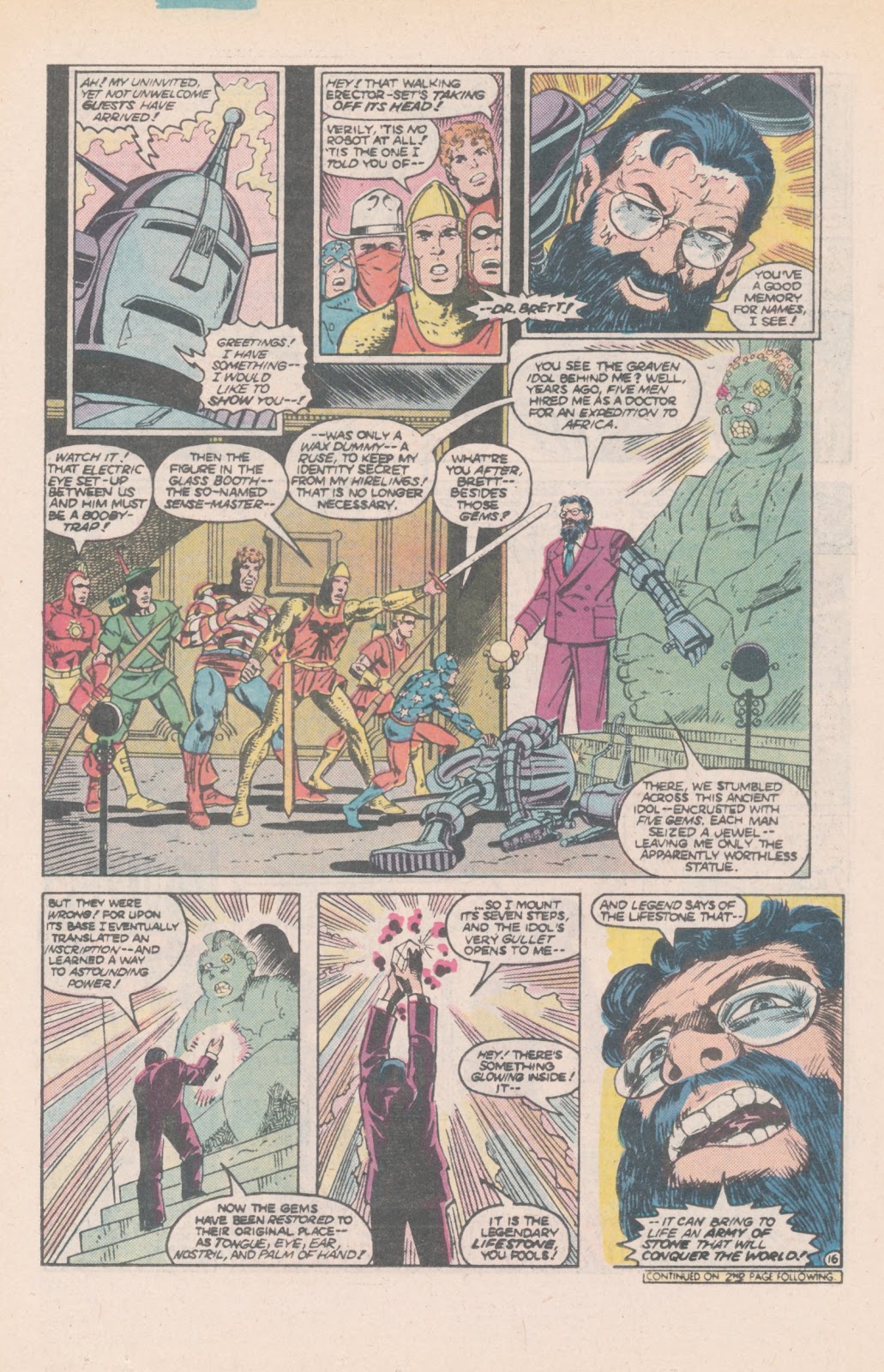 They give chase and Dr Brett animates the statue of Atlas, from Rockefeller Plaza. 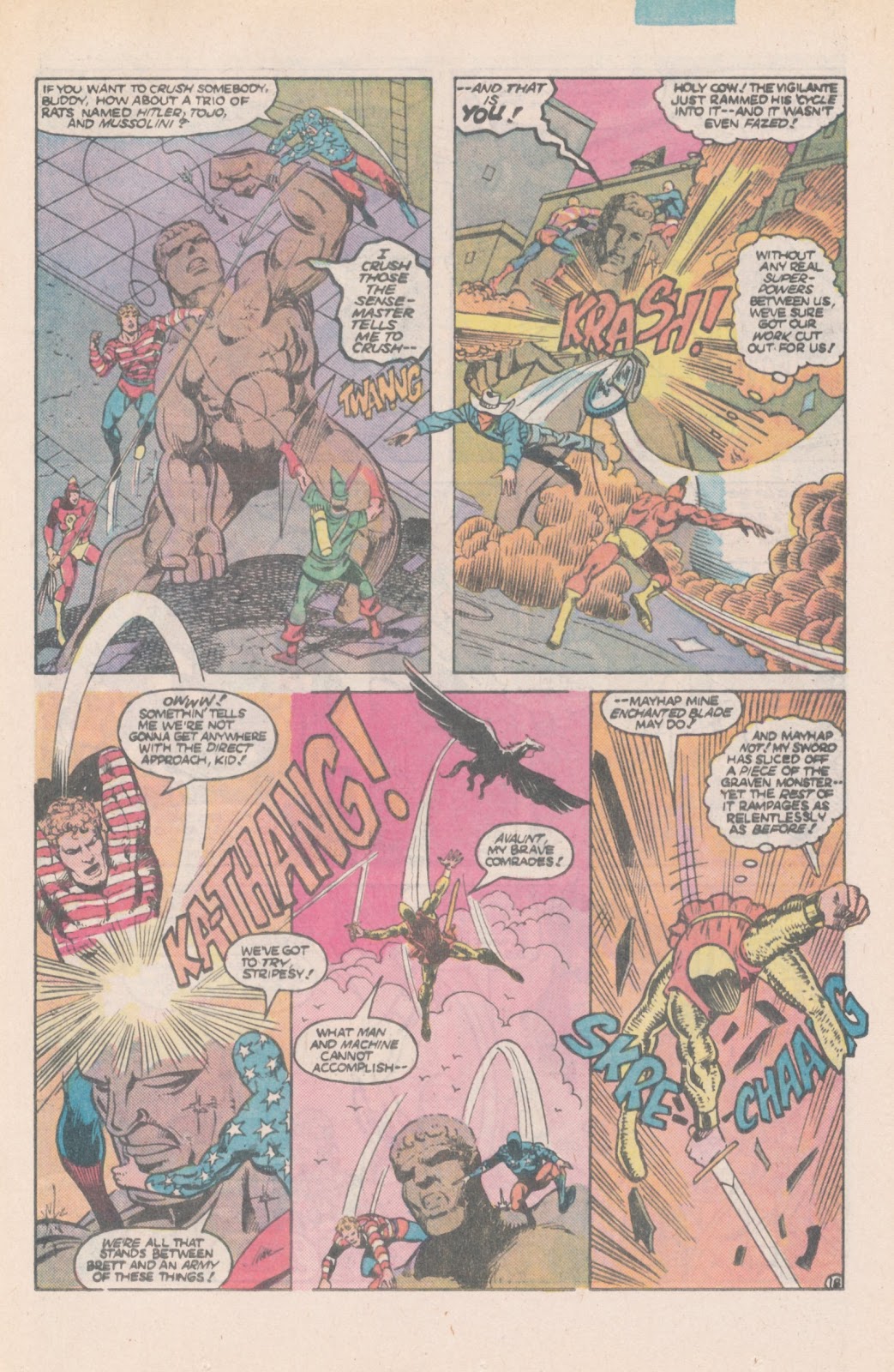 They fight and Vigilante tackles Brett, causing him to drop the stone and turn him into stone. They put Atlas back and Mickey is in the clear, as his girl isn't pressing charges and this mercifully ends. Back-up has Dr Mid-Nite, in space, where he lands on Neptune, meets up with aliens who are dying of plague (measles, actually) and he cures them. They provision him and send him off home. Thoughts: Ugh! This is what happens when a writer edits himself. I like Roy's writing and he was also a good editor; but, he wasn't objective when he became self-indulgent and it happened a lot in his latter days at DC. It's bad enough we are indulging this rehash of All-Star Comics; but, this issue is just a side plot to an old Seven Soldiers story, that really isn't that memorable. I guess Roy figured no on was reading anyway; but, there might just be a reason why. Last issue had some good stuff; not so much this one. The art is fine, though hardly anything above average. Things aren't helped by the Scooby Doo reveal of Dr Brett. I can hear their voices in the panel where the robot head is removed. This is just a placeholder, between major stories; but, it was stuff like this that was killing the book. It didn't help that Roy had learned that DC reneged on its promises to him that the All-Star stories were to be considered as having taken place before the crisis and, instead, removed the Golden Ager versions of the Trinity from the table. Roy was able to make an agreement to replace them with new characters, fulfuilling their roles, which will lead into Young All-Stars. Historical Notes: The truck that takes Mickey away says Hidalgo Shipping, and he is brought to a waterfront warehouse. The Hidalgo Trading Company was a front for the warehouse hanger and boat dock for Doc Savage, in his pulp adventures. At one point, Cody Weiss has a brain fart and both the truck and the warehouse signs say "Hildago". Sounds like someone was in St Louis, on "The Hill," where the Italian section resides. One of the hoods references Elektro, the World's Fair robot, when he sees the Sense-Master's robot. Of course, Elektro was repurposed by the All-Stars as Gernsback, named for the pulp editor and publisher Hugo Gernsback, who gave his name to the science fiction writing award. May 1944: On the Eastern Front, the Soviets drive the Germans from the Ukranian city of Sevastopol and then succeed in liberating the Crimean region. They then carried out the deportation of over 191,000 etnic Tartars from the region, in a program of ethnic cleansing, under the cover of punishing for collaborating with the Nazis, despite overwhelming evidence that they had been treated a subhuman and "racially inferior" by the Nazis and Ukranian collaborators. 8000 died in the deportations and tens of thousands died in the harsh conditions of their exile, in Uzbeck SSR. The Tartars would not return to the Crimea until the era of Perestroika, in the 1980s. By 2004, they comprised 12% of the population, but were never compensated for their deportation and loss of their homes by either the Soviet government or the Russian Federation. In Athens, 200 Communist partisans are shot by the Germans, in reprisal for the assassination of Gen. Franz Krech. The British release Mohandas Gandhi from prison, for health reasons, after he engages in a hunger strike. Muslim Albanian troops of the 21st Waffen Mountain Division of the SS Skanderberg round up 281 Jews in Pristina, Kosovo and transport them to Bergen-Belsen. In Hungary, Jews are deported to Auschwitz and other camps, for extermination. Hungary had only deported non-citizen Jews, prior to the German invasion of Hungary, in March. Between May 15 and early July, some 437,000 Jews were deported, most to Auschwitz. In October and November, 50,00 were forced to March from Budapest to the Austrian border, to supply slave labor. Large numbers died and the marches were called to a halt, because of the losses to the labor force (rather than humanitarian grounds). Before the deportations were halted, approximately half the Jewish population of Hungary had been either imprisoned or gassed (80% of the deportees died in the gas chambers). Of the over 800,000 Jews who lived in Hungarian territory, between 1941 and 1944, it is estimated that only 255,000 survived the war. The Germans abandon Monte Cassino and it falls to the Allies, led by the Polish II Corps. Over 20,000 lives were lost in the fighting to take the monastery. In Pearl Harbor, in the West Loch area, 29 LSTs were moored, beam to beam, while they were loaded for Operation Forager, the Invasion of the Marianas chain of islands Many of the ships carried fuel and ammunition, including explosive rounds. An explosion was triggered, sending a huge fireball into the sky and a raging fire ensued. This set of more munitions and some 200 men were blown into the water. Ships began to sink and firefighting was inhibited by the intense heat of the conflagration. By end, 6 LSTs were completely destroyed, 4 others were too damaged to take part in Operation Forager. Also damaged or destroyed were smaller LCTs (Landing Craft Tank), which were lashed to the decks, 17 tracked vehicles (LVTs), and 8 155mm guns. In the end, the disaster only set back the operation by one day. Naval investigations never did determine the exact cause, though the leading theory is a mortar round being dropped, while loading, causing it to explode, setting off surrounding ordinance. there is also much dispute about the death toll of the disaster, with the official total being 27 dead, 100 wounded, though others have placed the death toll anywhere from 132 to 392. The disparity is based on how the casualties were reported, with the military attempting to downplay the severity. There was a media blackout and reports related to the incident were classified Top Secret. The government released a one paragraph statement , saying an explosion had occurred with some loss of life, injuries and damage to ships. A longer account was released to the press after Operation Forager, but full details did not come to light until 1960, when they were declassified. The USS England (DE-635), named for Ensign John C England, who was killed onboard the USS Oklahoma, at Pearl Harbor, began escort duty in the Solomons, in March. In May, she sank 6 Japanese submarines, in 12 days, in an anti-submarine record that was never equaled. Their first kill was a sub making a supply run to Bougainville. They detected it with sonar and launched an attack with their Hedgehog mortar..... 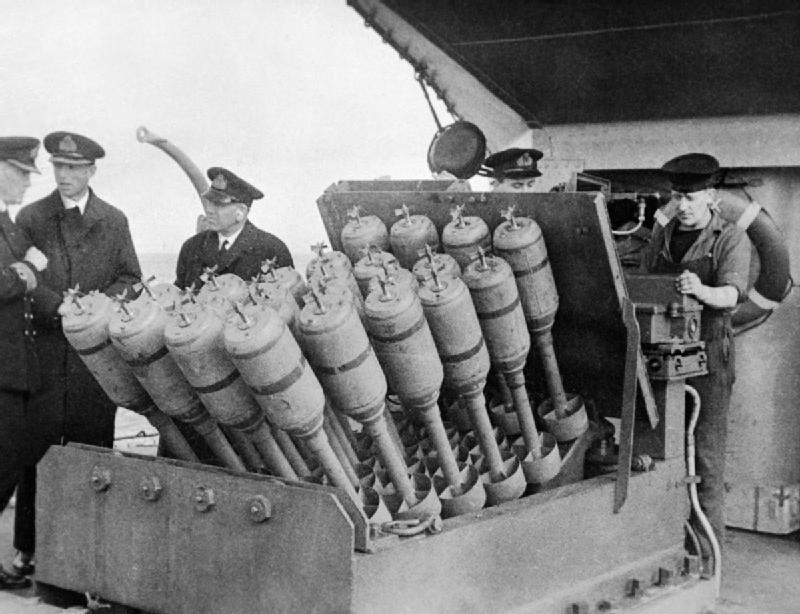 The Hedgehog fired spigot mortar rounds, with contact fuses. Normally, ships used depth charges to cause hydrostatic shockwaves, which damage a submarine's hull. The spigot mortar rounds would explode when they impacted a broad surface, like a hull, causing greater damage. The weapon was developed by the British Navy and used for convoy escort. The England's crew proved deadly accurate with it. They soon received orders to join a hunter-killer group to stop a picket of submarines that were targeting the route used previously by Adm. Halsey's carrier fleet. Between May 20 and 27, the England sank 5 submarines. The last came after it had eluded depth charge and Hedgehog attacks from the USS George and USS Raby. The sub maintained a position between the two ships, preventing them from firing on it. Subsequent attacks again missed the sub and the division commander finally got on the radio and said, "Oh, hell. Go Ahead England!" The ship then launched a Hedgehog attack and scored 6-10 detonations and a large explosion followed within 5 minutes and a fountain of oil and debris. The ship was awarded the Presidential Unit Citation, the highest award given to a military command (rather than an individual). The ship later joined the 5th Fleet, at Okinawa and on May 9, 1945, was attacked by 3 kamikaze planes. The ships anti-aircraft guns set the first aflame, but it impacted their starboard side, below the bridge, and it's bomb exploded. The crew fought a desperate battle against the fire, while combat air patrol took down the other two planes. They were able to extinguish the flames and were towed to Kerama Retto, to make repairs. 37 crewmen were killed and 25 wounded, in the attack. She was eventually sailed back to Philadelphia to make permanent repairs and for high speed conversion; but, the extent of damage and the end of the war put a halt to the repairs and she was scrapped in November 1945. In 1960, a new guided missile cruiser was launched as the USS England (DLG-22/CG-22), in honor of the previous ship. This was the calm before the storm, in terms of military operations, though, as we see, the Germans and their allies continued in their slaughter of innocents, aided by Far Right parties in power, in places like Hungary, Albania, Slovakia and Bulgaria. At the same time, the Soviet Union also carried out its own ethnic and political cleansing, while the Allied nations maintained holds on subjugated colonies and, in the United States, imprisoned American citizens, without trial, based solely on their Japanese ethnicity. From here, the tide turns and a march will begin that will, finally, bring an end to the slaughter and change the balance of world power and the destinies of most of the world's population.
|
|
|
|
Post by mikelmidnight on Jan 4, 2021 12:43:11 GMT -5
You know, someone needs to write a mini-series, where the Seven Soldiers of Victory meet up with the Fantastic Four, The Warriors Three, the Fightin' 5 and the Secret Six. They should battle The Sinister 6, The Unholy Trio, and the 100, all set to the music of 10,000 Maniacs. I'm sure it would be written by a room full of monkeys. I always wanted to see a story where the SSoV (Seven Soldiers of Victory) and the SSoSV (Secret Society of Super-Villains) start to get each others' mail. |
|
|
|
Post by codystarbuck on Jan 4, 2021 22:34:28 GMT -5
You know, someone needs to write a mini-series, where the Seven Soldiers of Victory meet up with the Fantastic Four, The Warriors Three, the Fightin' 5 and the Secret Six. They should battle The Sinister 6, The Unholy Trio, and the 100, all set to the music of 10,000 Maniacs. I'm sure it would be written by a room full of monkeys. I always wanted to see a story where the SSoV (Seven Soldiers of Victory) and the SSoSV (Secret Society of Super-Villains) start to get each others' mail. Surprised Kieth Giffen didn't use that plot in Justice League. I mean, after Justice League Antarctica and the Island of Kooie Kooie, why not? |
|
|
|
Post by codystarbuck on Jan 10, 2021 18:31:35 GMT -5
All-Star Squadron #57 Creative Team: Creative Team: Roy Thomas-writer/editor, Mike Clark, Rick Hoberg, Arvell Jones & Richard Howell-pencils, Vince Coletta, Alfredo Alcala, Tim Gula-inks, Cody Weiss-letters, Carl Gafford-colors Roy is nor credited as editor on the issue, though that was the case, and Dann carried no credit. Mike Clark & Vince Coletta handled the framing sequences, Rick Hoberg and the uncredited Tim Gula handled the Atom chapter, Arvell Jones & Alfredo Alcala handled Starman and Richard Howell did the Wonder Woman chapter. This is more of the "Shanghaied into Hyperspace!" adaptation, so this will be quick. Synopsis: Missing All-Stars have returned to find the destruction from the battle with Oom and the Monster Society of 5th Stringers. Dr Occult and Dr Fate reveal the fates of the missing JSA, leading into their individual chapters... 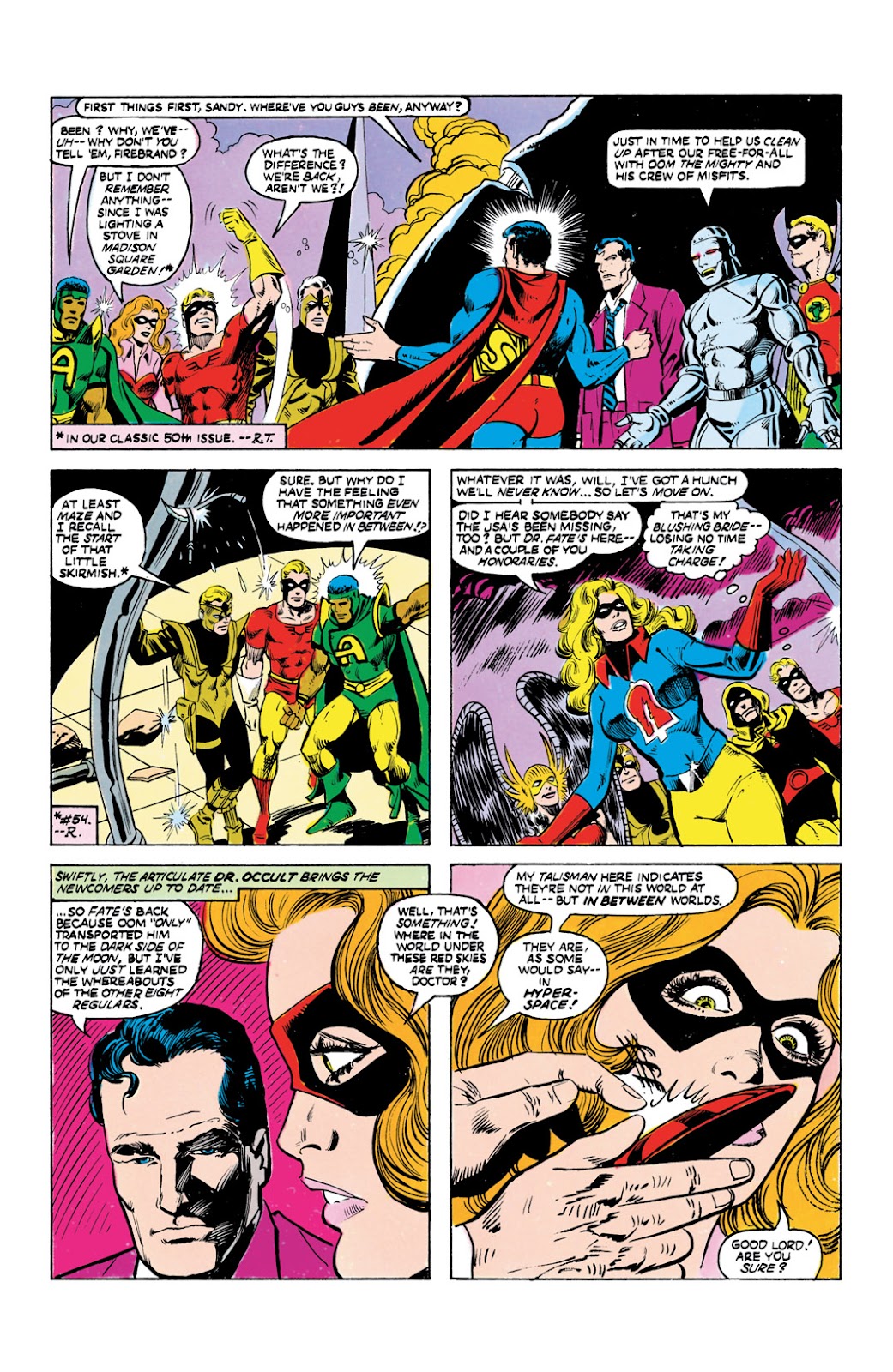 First, Atom lands on Mars and the lower gravity planet proportionally increases his abilities. It's all very John Carter. 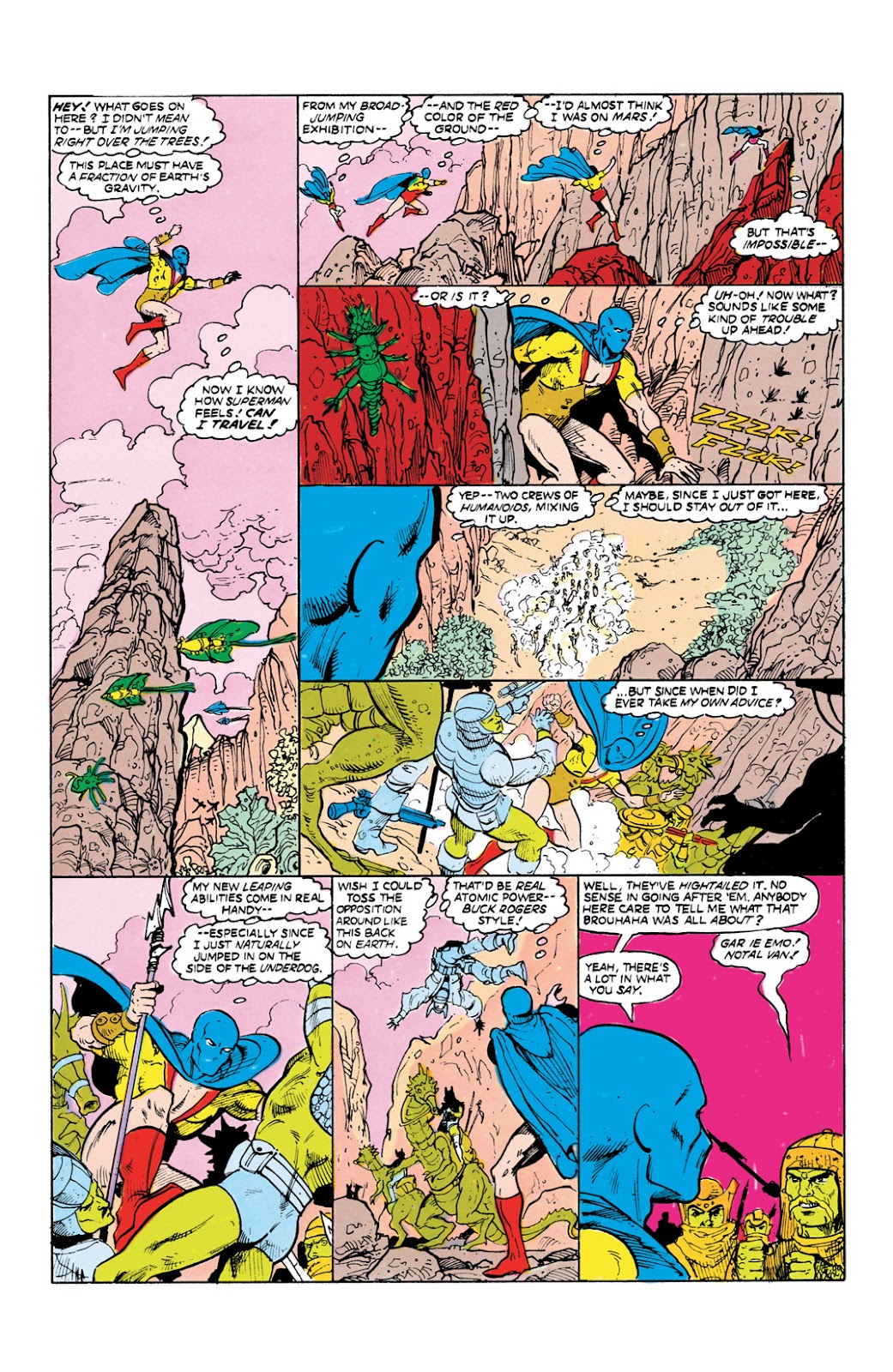 ...right down to atmospheric plants which are being threatened by a northern despot. John...er, Atom helps save the day and takes off in his rocket and Burroughs Inc calls their lawyers. Starman lands on Jupiter and is somehow not crushed by the immense gravity. He meets guys in metal suits, who aren't crushed like an aluminum can and is shown how the Nazis shanghaied them and tell him the Red Spot is an organism that is eating up everything. Starman goes out to try to stop it, uses his cosmic rod to mess with gravity, then Irish Whips it into space and goes home... 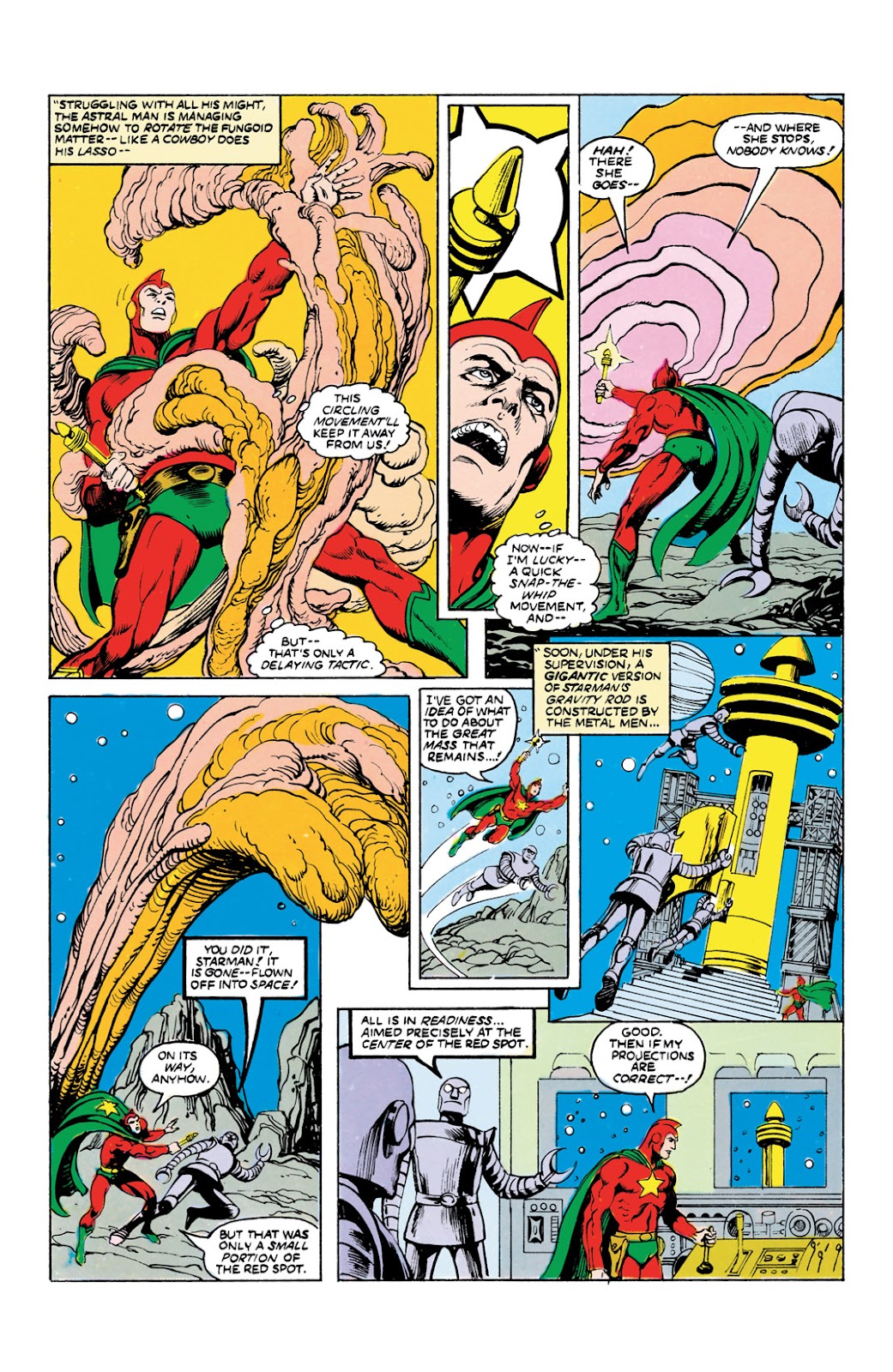 Wonder Woman lands on Venus, populated by butterfly women and is welcomed, then Meteor Men turn up attack and faster than you can say "Marston was kinky," everyone is tied up... 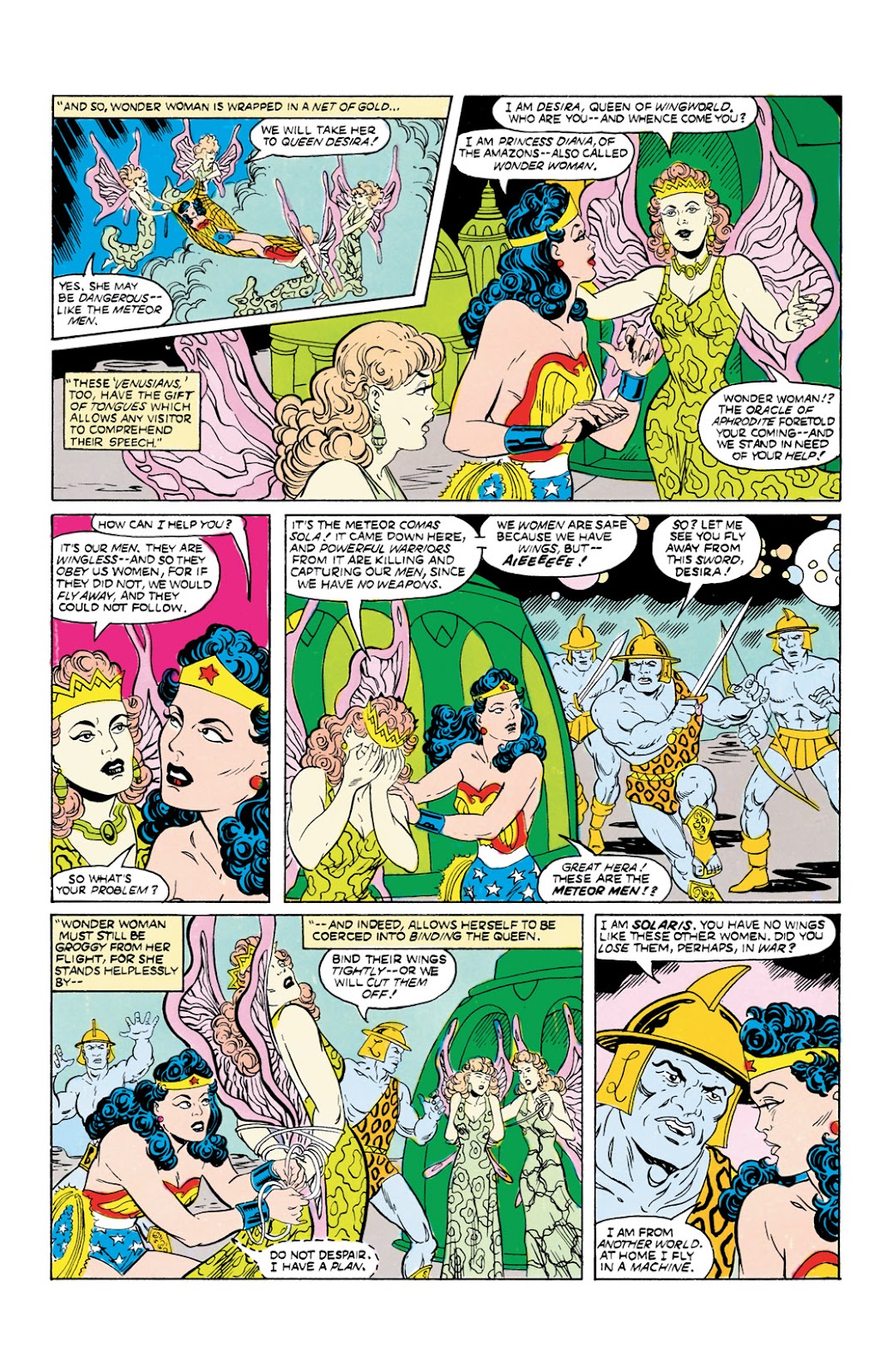 Diana gets slapped around and the bib meteor bullies give noogies and indian burns to the Venusian men. Diana is chained and forced to watch, but snaps her chains and challenges to boss to an inter-gender match and Amazon 3:16 says Diana just whopped his tuchus! However, the guards don't play fair and hold a spear to the queen's throat. Diana gets trussed up (because, why not?) with her lasso, but her ankles are free and she kicks the boss in the face, leaps over a stockade wall and gets the queen to free her, then brings the wall down on the Meteor Men. They end up on the receiving end of the bondage and it all ends looking like Eric Stanton was writing this.... 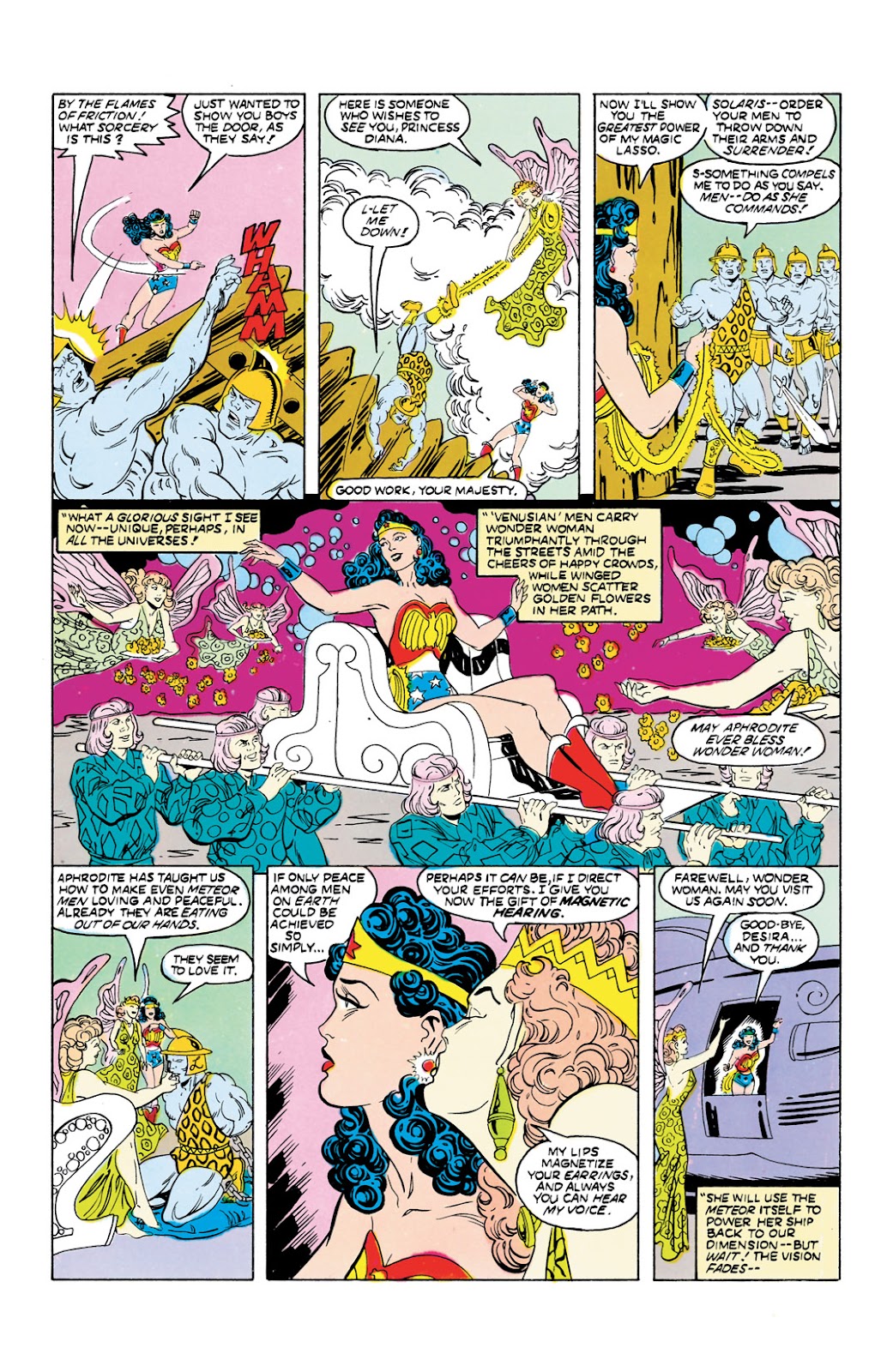 The framing device ends and we are told we are finally moving on. Thoughts: Like I said, the Atom segment is a complete rip-off/homage (tomato/tomahto) of John Carter and Starman is really bad science (then again, all of the planets of the solar system are supporting life when they couldn't, so why not?) and Wonder Woman is one big BDSM fantasy, though I think Howell pretty well captures the weird fairy tale quality of the 1940s Wonder Woman stories, in all their kinky glory. I've already said this storyline was self-indulgent and I stand by it. No one beyond Roy seemed to care and it did nothing for the characters, nor were they particularly good stories. Trying to ape the primative styles of the 1940s mostly ends up looking amateurish. Time to move on; and, thankfully, Roy seems to be at that point. Historical Notes: John Carter first appeared in "A Princess of Mars, " by Edgar Rice Burroughs, in 1912, in All-Story Magazine. In that story, he is transported to Mars, encounters the Tharks, observes a battle between the Tharks and the Red Men, meets Dejah Thoris, and saves the world from suffocating when the atmospheric plant is disabled. June 1944: Not much happened. Well, apart from this...  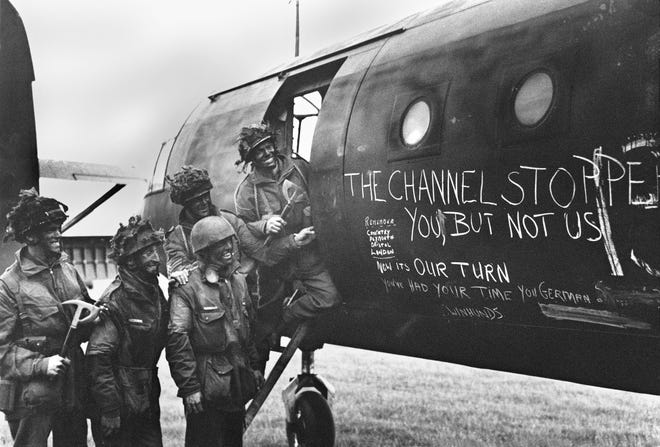 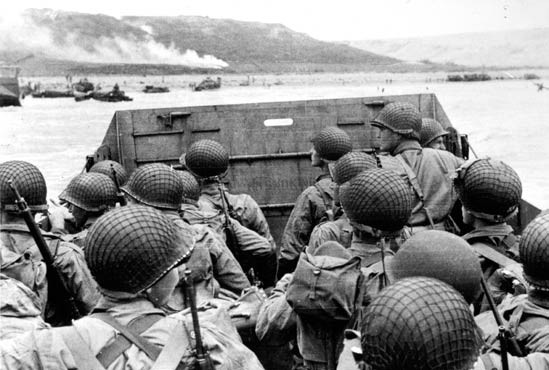  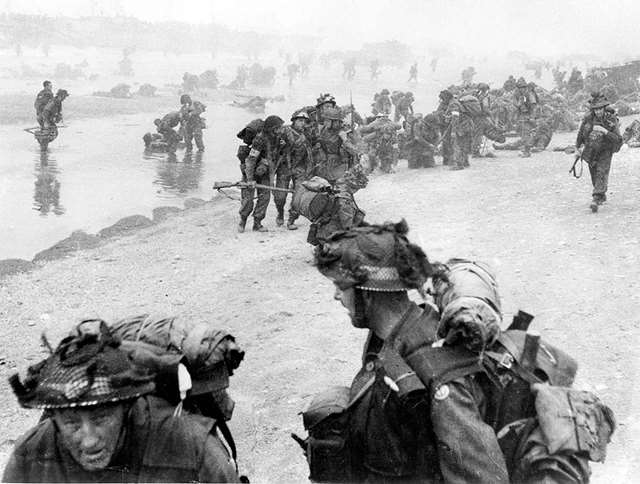  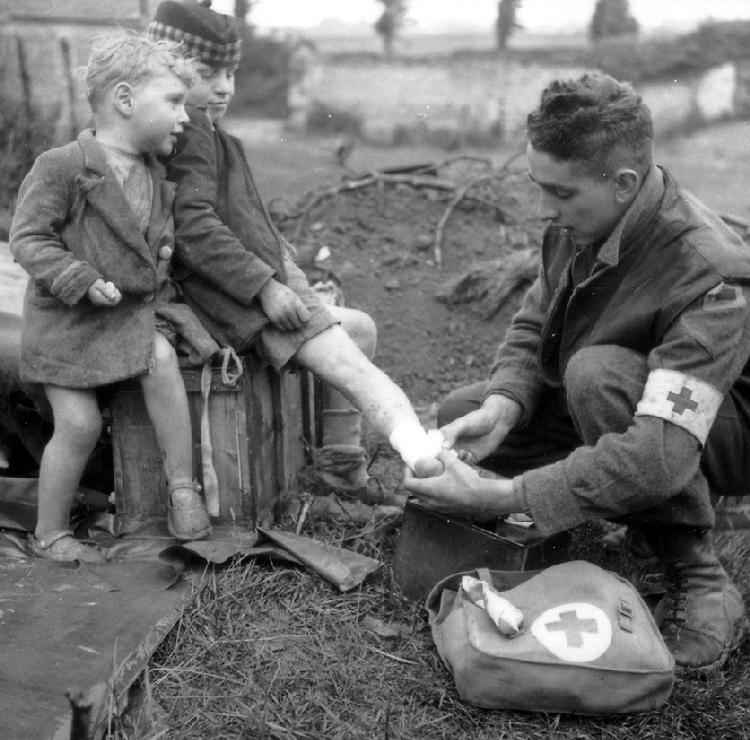  On June 1, the BBC begins transmitting coded messages to the French Resistance, including the first line of "Chanson d'automne," by Paul Verlaine ("Les sanglots longs/des violins/de l'automne" = "The long sobs of Autumn violins"), indicating the invasion will occur within 2 weeks. On June 4, Rome fell to the Allies On June 5, a weather forecast indicates a break in the storms that plague the English Channel. Gen. Eisenhower gives the order to "Go". at 10:55 pm the BBC broadcasts the second line of Chanson d'automne, Blessant mon coeur/d'une langueur/monotone" = "Wound my heart with a monotonous langour," indicating that the invasion will occur within 48 hours. Gen. Eisenhower visits with pathfinders of the 101st Airborne, prior to their loading their C-47 aircraft for their mission. Airborne forces load their C-47 transport planes, as well as Waco and Horsa gliders, to carry out the advance airborne assault, to capture key crossroads and bridges around Normandy. Lt Dick Winters, of Easy Company, 2nd Battalion 506th Parachute Infantry Regiment, 101st Airborne Division, loses his rifle soon after exiting his plane, on his mission to neutralize guns defending the Utah Beach sector. As part of Operation Deadstick, D Company, 2nd (Airborne) Battalion, Oxfordshire and Buckinghamshire Light Infantry, under command of Maj. John Howard, land in a coup de main assault on bridges crossing the River Orne and Caen Canal. They achieve complete surprise and capture the bridge intact and then prepare for counter-attacks from the Germans. Their orders are to hold the bridge until troops from Sword Beach can reach them. Elements of ther 82nd Airborne land in the center of Sainte Mere-Eglise, and are cut down by German troops as the float towards the ground. Members of the SOE link up with elements of the French Resistance to carry out sabotage missions to stall the German response. On June 6, after a massive naval bombardment, troops begin landing on the beaches of Normandy, at 06:30. The beach zones are code named Utah (US), Omaha (US), Gold (UK), Sword (UK) and Juno (Canada) The Utah landing is off target, but in a more advantageous position and met with lighter resistance. Landings progress quickly there. Easy Company carries out its mission to knock out defensive guns in a textbook assault, led by Lt Winters, who finds himself the senior officer present and leads the mission. At Gold Beach, high winds made landing difficult and DD tanks were released closer to the beach than planned, which proved advantageous, as more arrived intact than in other sectors. Accurate fire from the cruisers HMS Ajax and Argonaut took out 3 of 4 gun emplacements. Another strongpoint avoided destruction and provided heavy fire onto the beach. Company Sgt Maj Stanley Hollis is awarded the Victoria Cross for his actions at Gold Beach, in the Battle of Port-en-Bessin. Sword Beach also move well, thanks to landing 21 of 25 tanks, which are able to cover infantry landings. Sword Beach soon becomes congested, bogging down the advance. Lord Lovat's 1st Special Service Brigade land in the 2nd Wave and are piped ashore by piper Bill Millin. They advance inland to relieve the defenders of the Pegasus Bridge. Members of 4 Commando move on Ouistreham, including French soldiers under command of CDR Philippe Kieffer, the first French troops to land on French soil. At Juno, the German defenses had escaped much of the bombardment and Canadian troops come under heavy fire and suffer heavy casualties, but the Canadians fight fiercely and create several exit points. At Pointe du Hoc, US Army Rangers scale the cliffside to knock out German gun emplacements; but, find that the guns have not been installed. They eventually located the guns 550 yards to the rear and destroy them, but suffer heavy casualties before being relieved of their mission. Omaha Beach proves to have the heaviest defenses and troops there suffer the greatest casualties. Aerial bombardment had released late and many obstacles remained, forcing landing craft to unload further out and men to wade and even swim ashore. Many are killed in the first wave and the water is soon soaked in blood. 27 of 32 DD tanks released flooded, and 33 crewmen are lost. Some tanks are disabled on the beach, but continue to provide covering fire until they run out of ammo and rising tide forces their abandonment. Over 2000 casualties are suffered and landings are halted until destroyers can be maneuvered to provide artillery support. Fighting on the beach continues until midday, when elements are finally able to begin to create exit points and start the move inland. Troops were badly shaken and morale was low; but, key officers and non-coms moved through the areas encouraging the men to grab their weapons and fight. Brig Gen Norm Cota, leading the 29th Division at the Dog Green sector, is credited with inspiring his men by saying, "Gentlemen, we are being killed on the beaches. Let us go inland and be killed." He also encountered a group of Rangers and asked what outfit they were. They shouted out 5th Rangers. He bellowed, "Well, God damn it, if you are Rangers, then get up there and lead the way! "Rangers lead the way" became the official motto of the 75th Ranger Battalion, of the US Army. By end of day, most sectors had troops moving inland and the "Mullberries," and artificial harbor, were being moved into place to move greater numbers of supplies and equipment to the beach. It became known as The Longest Day, inspiring the title of Cornelius Ryan's book on the battle, compiled from interviews with soldiers in various armies involved. By months end, Bayeaux and Cherbourg have been taken. In the East, the Red Army launches offenses against Finland, but are repulsed and Finland remains free of outside rule. The Red Army does succeed in driving German forces out of Belarus and destroy two German army groups, the largest loss by the Germans in the war. The steamer Danae, carrying 600 civilians from Crete (including 360 Greek Jews) sinks en route to Auschwitz, with no known survivors. The Germans carry out the massacre of the entire population of the French village Oradour-sur-Glane, murdering 642 men, women and children. The murder is perpetrated by the SS Division Das Reich, in collaboration with the French Milice, a Right Wing Vichy paramilitary group which aided in the persecution of French Jews and in battling the Maquis. The population was rounded up and herded into the square to examine their papers. Woman and children were locked up in the church while the men were taken to barns and machine gunned. The church was set on fire and those that tried to escape through the doors and windows were cut down with machine gun fire. The village was set ablaze and a large portion was burnt to the ground. Only one woman escaped, alive but wounded, after she crawled to nearby bushes and hid. The town was left as it was as a memorial to the dead, never to be rebuilt. 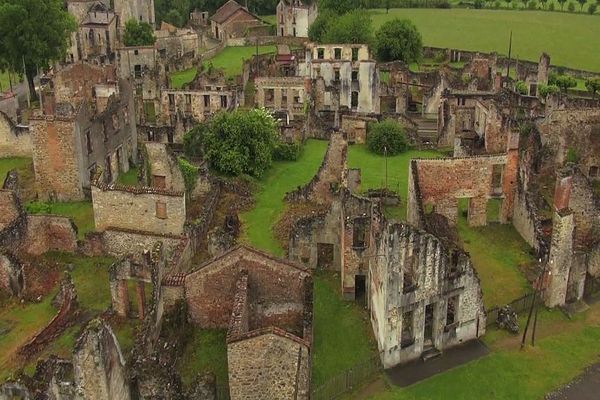 In the Pacific, US forces land at Saipan, in the Marianas island chain. The US objective was to cut off communication between Japan and its forces, by taking the Marianas and Taiwan, and to seize a base from which B-29 bombers could attack the Japanese home islands. The landings surprised the Japanese, but the defenders were ordered to fight to the last man. 24,000 Japanese were killed in battle, many in suicidal "banzai charges," as well as 5,000 by suicide. 22,000 civilians died, including 7,000 Japanese civilians (many by suicide). Allied forces suffered 13, 790 casualties. Fighting raged from June 15 until July 9. The Japanse sent a naval force to try and land reinforcements, but were met by the Allies, in the Battle of the Philippine Sea, aka The Great Marianas Turkey Shoot. The US had an advantage in carrier forces and aerial forces. The Japanese lost 3 fleet carriers and over 600 aircraft, as well as their most experienced pilots. Initially, the US felt they had lost the opportunity to destroy the Japanese fleet; but, the loss of the 3 carriers; and, more importantly, the aircraft and pilots, meant that Japan could not launch any offensive naval strikes. 5 Medals of Honor were awarded to Marines and soldiers, including Army Captain Ben Salomon, a dentist who manned a machine gun to defend his unarmed patients from a Japanese assault, until he was killed. Marine PFC Guy Gabaldon was awarded the Silver Star for his capture of over 1,000 Japanese prisoners. Gabaldon was a Mexican-American, who had been raised with nisei children and knew street Japanese. He was able to use his language skills and experiences to convince the Japanese that Americans were not monsters and surrender to them, rather than die fighting or commit suicide. He was nominated for a Medal of Honor, but awarded the Silver Star, a common event for minority soldiers whose bravery matched or exceeded white soldiers who were awarded the medal. It was later upgraded to a Navy Cross, in 1960. Efforts continued to have his efforts recognized with the Medal of Honor, with the Mayor and City Council of Los Angeles petitioning the White House to upgrade the medal, in 2006. Guy Gabaldon died that year. In Burma, British forces win the Battle of Kohima. The victory relieved the Japanese siege of Imphal, which had lasted since March. It proved the turning point in the Japanese offensive towards India, as they began their retreat, after suffering huge losses. Iceland declared full independence from Denmark on June 17.
|
|
|
|
Post by codystarbuck on Jan 10, 2021 18:59:40 GMT -5
The opening of the first episode of the seminal Thames Television documentary series, The World at War, features images from Oradour-sur-Glane, as Sir Laurence Olivier, describes the events....
I highly encourage anyone with an interest in history to watch the series, done in 1973, with many survivors from all sides. It does a tremendous job of conveying the history of not just the battles, but the homefronts, the government decisions, the atrocities and the horror of World War 2. It bookends the series by returning to Oradour-sur-Glane. It features interviews with soldiers and civilians from all over, including Albert Speer, Hitler's secretary Traudi Junge, British general Brian Horrocks, government officials from the Allies and Axis powers, eyewitnesses from various communities and propaganda footage from the enemy and Allied side. It looks at the Holocaust, the rise of the Nazis and fascists, the militarist in Japan, the change in government from Chaberlain to Churchill, the isolationist movement in the US and bundist groups, racial unrest, the internment of the nisei, life in Japan before and during the war, efforts by Japanese officials to negotiate a surrender before the Atomic bombings, and the horror of the explosions.
The series is a very balanced look at the events that led to the war, the people who fought it, and the aftermath. It is filled with the mistakes and stupidity of humanity, the bravery and the determination to rid the world of an evil. There are lessons there for every generation.
|
|
|
|
Post by Calidore on Jan 10, 2021 21:20:09 GMT -5
I'll second The World at War. Being made less than 30 years after the end of the war meant that many people who were there on both sides were still alive to be interviewed. It certainly deserves its status as one of the greatest documentaries ever made. The DVDs are loaded with supplements as well.
Two advisories, however:
1. The "restored" blu-rays from A & E are presented in cropped widescreen rather than their original full-frame. Stick with the DVDs.
2. The series is never exploitative but also doesn't flinch from the unpleasant results of war, which means some very graphic footage. The episodes on the Holocaust and the human aftermath of the atomic bombings in Japan can be especially tough going.
|
|

































 ) meets up with Arak, who says the Natives have cause for attacking. Danette faces Super Chief, who has her outclassed, until she figures out his amulet might have something to do with it and sears away the leather thongs that hold it in place and he plummets to the ground, but has time for a speech.
) meets up with Arak, who says the Natives have cause for attacking. Danette faces Super Chief, who has her outclassed, until she figures out his amulet might have something to do with it and sears away the leather thongs that hold it in place and he plummets to the ground, but has time for a speech. On the planet are crystalline lifeforms, whose leader has a dream about flowers from space and they witness Sandman's rocket landing. he is asphyxiated by the atmosphere and they bring an old fashioned bubble helmet and oxygen tanks to revive him and then tell him their woes...
On the planet are crystalline lifeforms, whose leader has a dream about flowers from space and they witness Sandman's rocket landing. he is asphyxiated by the atmosphere and they bring an old fashioned bubble helmet and oxygen tanks to revive him and then tell him their woes...











